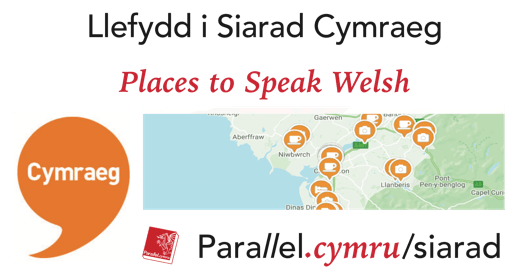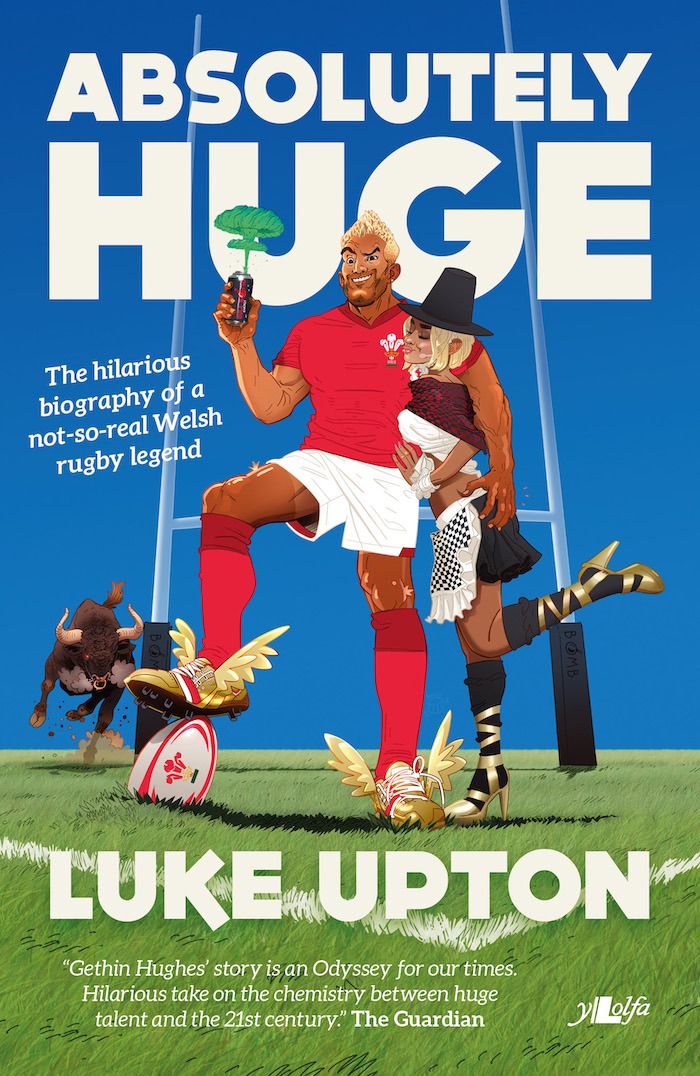Parallel.cymru is very fortunate to have an experienced traveller and great Welsh sports fan, Dai Rowlands, provide a travelogue of his journey to Japan for the Rugby World Cup- a perfect way to help those of us stuck behind our TVs and desks in Wales to get a feel for the experience of being there!
The following is a daily diary of a journey to Japan, the land of the rising sun, to watch the Welsh Rugby team play Fiji and Uruguay in the 2019 Rugby World Cup. Neil Rowlands invited me to compile this diary for inclusion in the increasingly popular Parallel.cymru website.
Following Neil’s invitation, I thought back to the stimulus to undertake such a journey. Recollections of Euro 2016 came flooding back when the Welsh football qualified for a major tournament for the first time in almost 60 years. I was fortunate enough to attend every Welsh match in that pulsating tournament. Memories of the camaraderie, national passion and pure excitement were the major factors in wanting to support the national team once again in a major tournament, even if the shape of the ball was different this time around.
Sister Linda and myself travelled to Bordeaux for the first match of Euro 2016 against Slovakia. We will never forget that first morning of the tournament for the Welsh fans. We sat at a typical French café opposite Bordeaux central station in glorious sunshine. There were endless streams of Welsh fans exiting the station as trains rolled in from Paris and other destinations across France. This was just the beginning, and as we made our way into the centre of Bordeaux, we began to realise how many fans had travelled to support the national team. Various football songs and Welsh hymns were sung loudly from the endless French bars and restaurants. This set the scene for a fabulous five weeks travelling across the breadth of France to Lens, Lille, Toulouse, Paris etc. It is the memories of these fantastic times that gave the impetus needed to make the commitment to travel much further afield and join the thousands of Welsh rugby supporters in Japan for RWC2019, provided of course tickets, flights and an itinerary could be sourced and within budget.

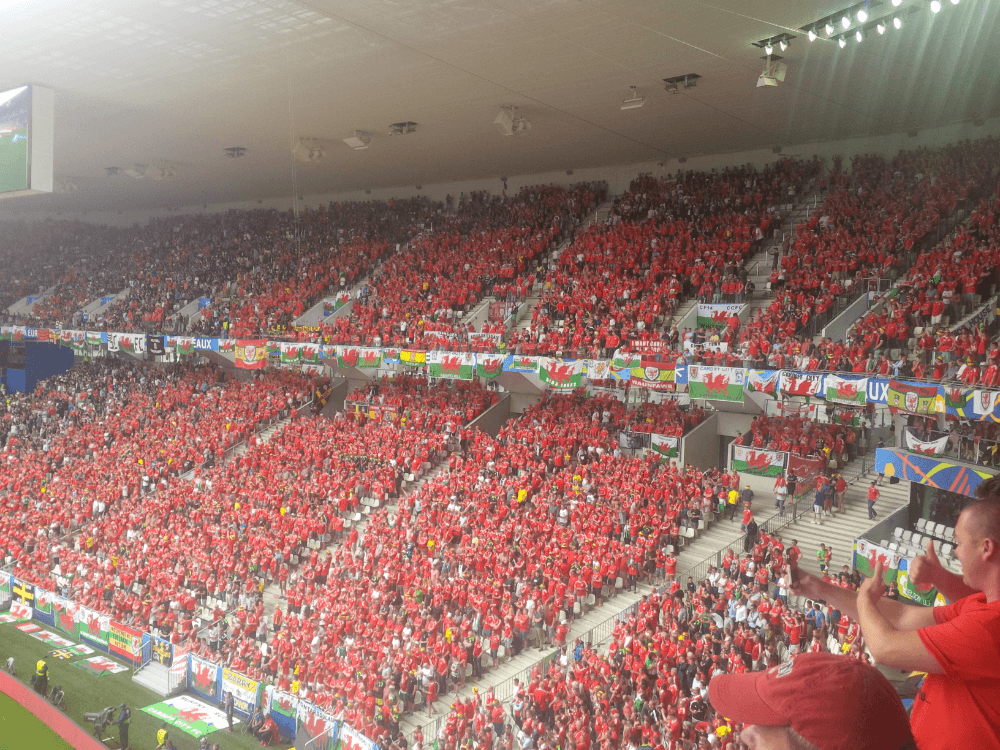
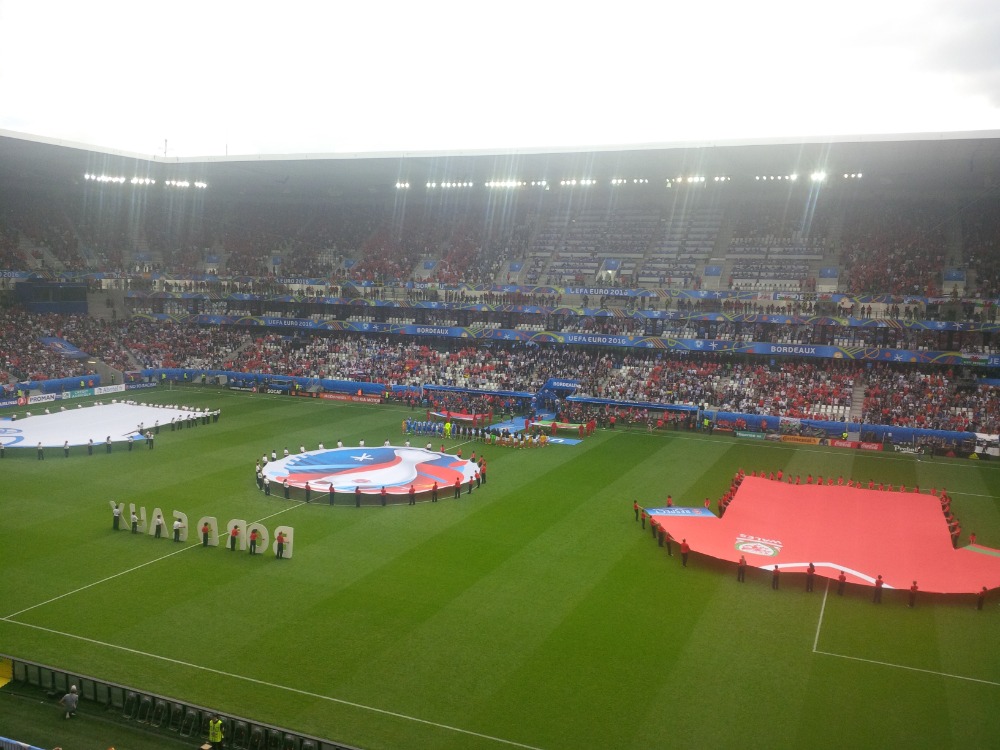
A café in Bordeaux
The Red Wall of fans in Bordeaux
The Anthems- Wales vs Slovakia
The first task was to source match-day tickets which were on sale via the official RWC2019 website. Two of the Welsh matches (Georgia and Australia) were set for September with the Fiji and Uruguay matches being scheduled in October. Various constraints meant it was only practical to attend two of the group matches which were those to be played in October (Fiji and Uruguay).
Purchasing tickets was not as straightforward as expected and required registering in a queue of 20 hours with the RWC2019 website. The lengthy queue was due to the sheer number of applications from supporters of the 20 teams participating in the tournament. When your turn eventually came about, a notification email from RWC2019 was received giving 30 minutes to log on and order your tickets otherwise the place in the queue is forfeited and the process starts over again. After a couple of false starts, tickets were eventually secured for Wales versus Fiji and Uruguay- both being played on the island of Kyushu in the south of Japan. Kyushu is a six hour bullet train journey from Tokyo.
With tickets secured, the next stage was to seek suitable flights which fitted with the matches being held on 9th and 13th October respectively. Qatar Airways from London to Tokyo via Doha satisfied the criteria with departure from London Heathrow on Saturday 5th October. The initial itinerary included a one hour transit in Doha although this was soon to be rescheduled by Qatar airlines such that the stopover in Doha grew to more than 5 hours…….. ho hum, the joy of international travel.
With the relatively easy components of the plan completed by May, it was time to embark on the daunting task of arranging an itinerary within Japan, a country with a different culture, time zone and language. Initial enquiries showed that all types of accommodation in Oita the location of the Fiji match, were already fully booked. Oita being apparently only a small town, mild panic ensued and it was time to consider alternative strategies. Google searches on tour operators within Japan threw up a couple of possibilities. Both companies requested various details including arrival/departure dates, the matches for which tickets had been obtained, preferred mode of transport within Japan etc. Inside Japan Tours (a subsidiary of Inside Asia Tours) were terrific, very helpful and with a number of suggestions and alternatives. Within a few days, they forwarded a proposed and detailed, day-by-day itinerary together with budget. This included metro tickets from Tokyo Haneda airport to the Ibis hotel downtown Tokyo, an 8 day bullet train pass, and all the required transfers including 2 hour coach return journey from a hotel in Fukuoka to the stadium in Oita shared with many other Welsh supporters who similarly could not secure accommodation in Oita.
Decision made and the booking was confirmed with Inside Japan Tours (strongly recommended for anyone visiting Japan). A detailed itinerary and various tour guides were gratefully received in addition to a goody pack of official baseball cap, rugby jersey, umbrella and luggage tag.
Wey hey, with all plans made it seems we are all ready for a memorable journey to support Wales at RWC2019.
Saturday 5th October: Hampshire to Doha
ng ShinjukuDawn in the Hampshire village of Crondall brought a grey and damp day. Much of the preparatory packing had been done earlier in the week so all that was required was a final check of clothing, toiletries, Welsh rugby shirts and flag.
First up in the morning was a visit to the local David Lloyd leisure centre for a workout in a virtual spin class with the aim being to get as physically tired as possible before the twenty five hour journey to Tokyo. After the spin, it was home to watch England thrash Argentina and secure qualification to the quarter finals of RWC2019. The lawn needed a final mow which provided more physical exertion then out with the darling wife, Kate for a farewell coffee in the nearby village of Odiham.
Kate was her usual superstar and provided transportation to Heathrow T4 for flight QR8 to Doha with departure at 16.00. Whilst in the airport lounge, brother John was providing score updates for the WBA versus Cardiff City football game which he was listening to via Cardiff City world. The mighty bluebirds ending their 7 match unbeaten run with a 4-2 defeat.
QR8 was on time departing Heathrow T4 arriving in Doha some six hours later. An uneventful flight arrived at half past midnight local time on October 6th.
Sunday 6th October: Doha to Tokyo
Qatar airport is much bigger than expected and has the usual array of large and expensive duty-free shops. The aim was to get some sleep and attempt to move forward a little onto Tokyo time. This didn’t happen so spent a frustrating 5 hours reading, surfing and snacking. The airport was busy on arrival and became quieter around 2am with footfall picking up again around 5ish. We were called to gate A7 at 06:00 for the scheduled 06.45 departure of flight QR 812 to Tokyo Haneda airport only to be frustrated by the late arrival of the incoming flight which caused a delay of more than 30 minutes to departure. This was a concern as arrival in Tokyo was scheduled for 22:40, whilst the last train to Shinjuku, the district of Tokyo where the Ibis hotel is located, departs at 23:55. Being aware of this tight connection to the last metro to Shinjuku, a swap of messages with Inside Japan a couple of weeks before setting off gave a couple of alternatives. These are a bus at 01:00 or last resort is a taxi. Despite the lateness of the flight, the target was still to catch the train as I was in possession of a metro ticket supplied by Inside Japan and didn’t really want the additional expense of bus or taxi.
QR812 is a 10 hour slog and not having slept for more than 20 hours, the first three hours of the flight was a welcome deep sleep.
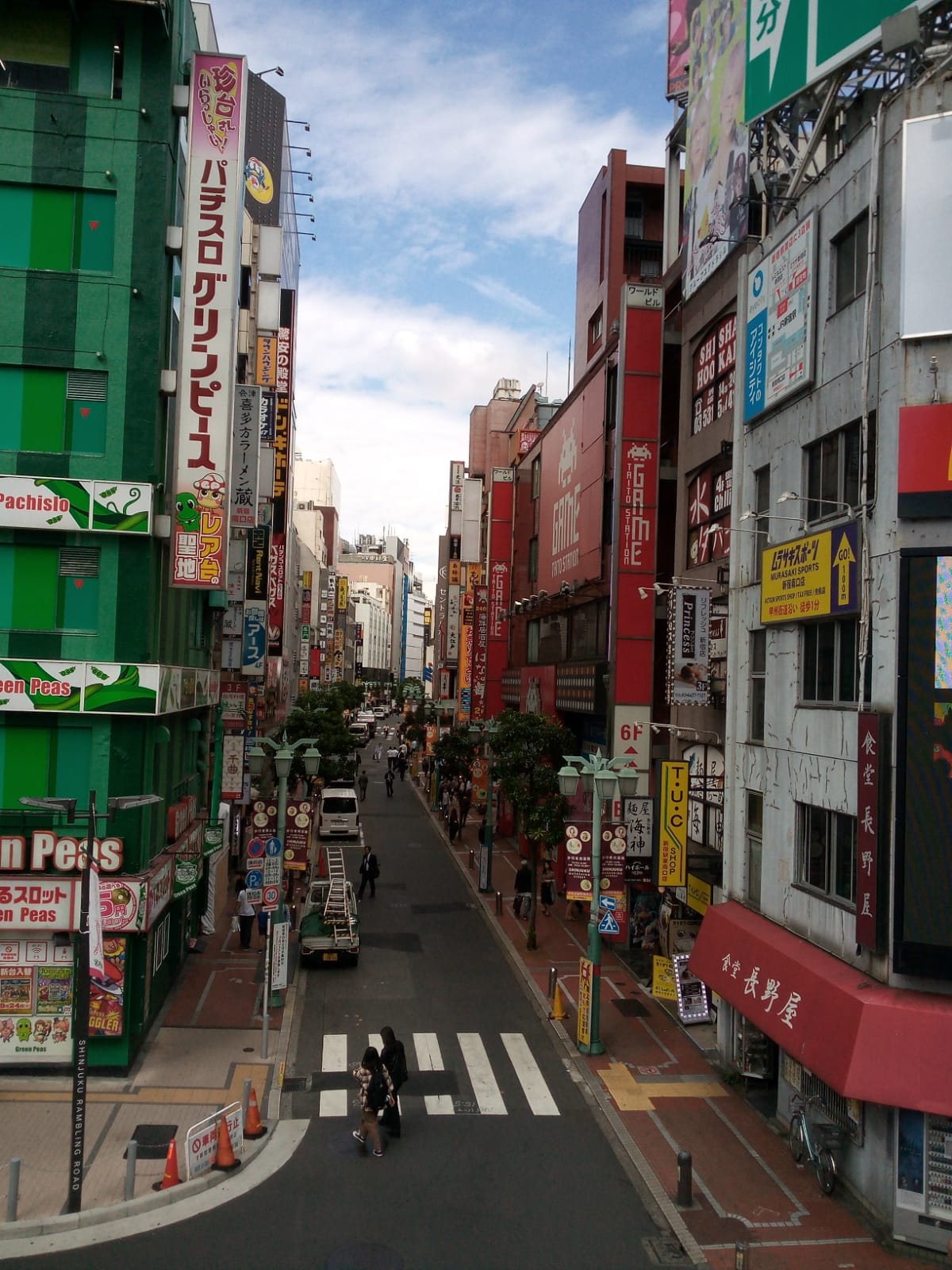
The inflight entertainment on Qatar airways is fantastic with a wide array of movies and music channels. Having never watched Chernobyl, the BBC docu-drama, this was selected as choice of viewing and managed to binge watch three episodes before the headphones started to become annoying and there is only so much TV that can be watched in one session.
Looking out the window at the endless miles of barren landscape below made me realise how very lucky we are to live on our lush green island. The inflight interactive map on the modern A350 showed we were flying north of the Himalayas through southern Russia and into China. There were no trees or greenery for more than 1,000 miles (2 hours flying at 500mph), only punctuations of occasional industrial settlements in what resembled a brown, craggy moonscape. Just at that moment, I really wanted to know more about the industrial development and mining industry in this remote region and the unimaginable life of the workforces in these industrial outposts.
Having departed Doha just after 0700am, the first seven hours of the flight were in daylight, however as we travelled eastwards over China, dusk and eventually nightfall ensued. Having travelled extensively in a 37 career in the oil and gas industry, one very useful trick learned to minimise jet lag is to set your watch to the time of your destination at the beginning of the journey. Consequently, you are preparing both mind and body throughout the journey. This being said, as we flew over the yellow river in China, it was 19:45 Tokyo time, 8 hours ahead of UK and the body clock was very confused. What happened to Sunday 6th October?
Monday 7th October: Arriving in Tokyo
Monday’s dialogue is subdivided onto two sections, punctuated with a welcome night sleep.
 QR812 arrived in Tokyo’s Haneda airport 20 minutes late and although there were queues at both the immigration and customs checks, Japanese efficiency came to the fore and consequently the train from Haneda airport to downtown Tokyo was caught with some time to spare. A change at Shingawa onto the JY line for the vibrant district of Shinjuku. I always thought that a map of London’s rail and underground network was confusing, but take a look at Tokyo’s mind-blowing railway and subway network – a big WOW!
QR812 arrived in Tokyo’s Haneda airport 20 minutes late and although there were queues at both the immigration and customs checks, Japanese efficiency came to the fore and consequently the train from Haneda airport to downtown Tokyo was caught with some time to spare. A change at Shingawa onto the JY line for the vibrant district of Shinjuku. I always thought that a map of London’s rail and underground network was confusing, but take a look at Tokyo’s mind-blowing railway and subway network – a big WOW!
During the journey from Haneda to Shinjuku, you become aware immediately by the difference in culture to back home. There are recycling receptacles everywhere, all used diligently. There is no litter, people don’t eat or drink in public and although almost all the younger folk seemed joined to some form of electronic media, most often a mobile telephone, nobody makes or takes calls in public. This became apparent throughout the trip, when locals would walk outside bars, restaurants and cafes to make and take calls. The Japanese are so very polite and considerate to other people.
The transport system from the airport is older than expected, but very clean and punctual. By now it was gone midnight but the JY train to Shinjuku was packed with late night Japanese revellers and one very tired Taff.
Shinjuku station is apparently the world’s busiest used by more than two million people each day. There are so many exists (east, south east, west, south etc etc) and the numerous concourses spread for more than half. I had no idea where to exit and eventually selected the south exit as it was the closest. The outside of the station was a vast array of skscrapers and neon lights. I had no idea where to turn to find the Ibis, Shinjuku hotel. I asked a couple of innocent revellers, one of whom very kindly walked with me the 15 minutes to the Ibis. He told me that he lived in that direction. Such is the politeness of the Japanese.
The bar at the Ibis had apparently long closed, but I had caught glimpse of a British bar, the Hub, the other side of the road and immediately opposite the entrance to the Ibis. As it was so late, I couldn’t be bothered to deposit the luggage in the designated hotel room, but instead went straight to the Hub for a much needed beer or three. The cozy bar, playing live Premier League football (it was early Sunday evening in UK) was still buzzing at 1am and it didn’t take long to strike up conversation with other rugby fans – mainly Brits. There was one other Welsh guy in the Hub, Gareth, and judging by the look in his eyes, had been in the bar for some time. Within thirty minutes of arriving, we were “entertaining” (the word is used loosely) the rest of the Hub drinkers with our interpretation of Sosban Fach and Men of Harlech. So impressed were the others present that they requested an encore. Sparkly-eyed Gareth wasn’t quite up to any more singing, so we called time on our entertainment session.
As a Welshman travelling alone, I was invited to join a couple of other groups of fans. We each swapped stories of our itineraries, where we came from and other meaningless alcohol-stimulated chit-chat. This brought back many memories of our attendance at Euro 2016, where we met numerous football and Welsh supporters from all over the country and exchanged stories into the early hours. For anybody that has not attended such a major sporting event, this aspect of the tournament is compelling. So many interesting people, everyone with a different story to tell and so willing to provide advice if needed. It really is akin to an enormous extended family, each with different roots but each with a common aim- to support their team. In many respects, the actual games are merely an interruption to a fantastic social occasion.
It was gone 2am, the bartenders, all wearing rugby shirts, had called last orders so it was time to walk back across the road to the Ibis and the tiny room that will be home for a couple of nights. Certainly no space for swinging pussycats, not even a kitten! Even though so late, you are immediately struck by the in-room technology with the most complicated tap system and loo flushing ever witnessed. Grasping the basics before sending goodnight wishes to my darling wife which evolved onto a very welcome deep sleep.
Later that morning and following a light breakfast at the Ibis, there were two tasks to be undertaken prior to some Tokyo sightseeing. First up was the purchase of an adaptor to facilitate charging of electrical appliances which was purchased at a fascinating Japanese store crammed full of all sorts of household goods and very little room to move. The required adaptor was found on the third floor amongst loads of similar electrical appliances.
Then it was off to the JR (Japanese Railways) ticket office at the vast Shinjuku station to exchange a pre-purchased voucher for a ten day railcard and also to reserve seats on a Tuesday morning bullet train to Fukuoka on the island of Kyushu. This sounds straightforward, but in such a vast station, with so many different ticket offices, it required a degree of patience.
Tokyo is a huge and busy city with a population over 13 million. It is divided into districts, each with its own identity. Shinjuku, according to the guidebooks is one of the busiest of these districts and host to an exciting and eclectic nightlife. It is overwhelming just walking around the streets. The noise and sheer number of people is claustrophobic and overwhelming to someone more used to the space and relative tranquillity of a Hampshire village. For anyone requiring their own personal space, Tokyo is not the city for them.
By late-morning, some form of escape and space was urgently required from the noise and enormity of the city and its hoardes of people.
Most of the cafes, restaurants and coffee shops were tiny and rammed with locals enjoying morning coffee or an early lunch. Eventually, a more spacious, not so busy, air conditioned, coffee shop provided much needed respite from the mad craziness of Shinjuku’s packed streets. A leisurely and comfortable hour was spent consulting various guidebooks from which a plan gradually emerged to try and wrestle back at least some sanity and normality. This certainly did NOT involve any form of transport system, having overdosed on travelling the previous two days. Shinjuku Gyoen National Gardens was only a short walk away and was recommended as a “must visit” in one of the guides. Armed with map in hand, I ventured back outside into the wild world of Shinjuku and navigated the packed streets in search of Gyoen Gardens.
Phew, what a relief. On reaching the gardens there was greenery, space, much fewer people and little traffic. Chill time……. pause and relax.
You never know what to expect when visiting different countries, cities and cultures. Mentally, I was certainly not prepared for the vastness and business of this amazing city. Gyoen gardens gave time and space to recover and reassess.
Hunger and tiredness ensued so I meandered through a not so crowded district, stopping firstly at one of the numerous Tulley’s coffee shops for an iced coffee and then at a small, typical Japanese restaurant down one of the many crowded alleyways where they served a fab rice dish- devoured with wooden chopsticks.
Later, enjoying a late afternoon tea in the relative tranquillity of the lounge at the Ibis hotel and catching up on news and emails, a group of six weary looking Welsh folk checked in to the hotel. Swapping stories in the time-honoured manner at these events, they had left Abertillery at 04:00 am the previous morning (Sunday) for a drive to Heathrow and then onto Tokyo with Etihad which included a two hour stopover in Abu Dhabi. They were already drinking the local beer served at the Ibis and were very pleased to hear about the Hub bar across the road. In fact, one of the guys insisted that I show him the exact location of the tiny entrance to the Hub which was easily missed in the surrounding vastness.
Whilst reading the guidebooks earlier in the day, a plan had been hatched for the evening which incorporated a twenty minute walk to a district supposedly less busy than Shinjuku but apparently with a good selection of bars and restaurants. Armed with an umbrella to protect against the increasingly heavy rainfall, it was back out into the madness and bright lights. Virtually every shop, café and restaurant had loud music blaring from their entrances to add to the general overpowering din. Dodging all the other umbrellas and with map getting increasingly damp, I walked briskly to the planned destination only to be disappointed by the small selection of options. Turn around and head back through the rain to the craziness and huge array of options in Shinjuku. It was difficult to decide where to eat, but the choice was whittled down dramatically as only 10% of the eateries had menus in both English as well as Japanese. Furthermore, many of the establishments were not on ground level but either below ground or on various floors of the many tall buildings. First up however, was a pre-dinner beer in a basement bar. The bar was packed with locals screaming at the live Tokyo league baseball being shown on the many TV screens around. I sat on the one spare seat in the bar and just watched in amazement as the excited baseball fans cheered at the action. The audience was split equally between the Bears and the Chiefs. I can only imagine the atmosphere when Japan are playing their games at RWC2019.
Back out into the rain and onto one of the many small local restaurants which included the menu with an English interpretation albeit in very small letters. The first mistake was to order a large beer. It took both hands to lift the litre glass and it took the duration of the kebab meal to consume.
The rain was still falling as chaos was once again confronted en-route to the Ibis via a briefish stop for a nightcap of the local cider – yummee scrumpy. Surprising that smoking is still allowed in many of the establishments and yet banished from the streets. There are notices on the pavements stating “no smoking” and consequently there are smoking areas partitioned off along the walkways for the many Japanese that smoke.
The final stop was the 7-11 store a short distance from the Ibis. Whilst looking for a suitable choccie bar for a midnight munch, I bumped into three Welsh guys, Owain, Glyn and Gareth. The latter was my duet partner from the previous night. They were purchasing a cheap bottle of local red wine to take back to their hotel room on the basis it was much cheaper than that served at the Hub. It transpired that Owain, Glyn and Gareth were from Glyneath and were flying south the following morning for the Wales versus Fiji match on Wednesday. No surprise there!
Owain was a similar age as myself, and on learning of my Maesteg roots, he asked if I knew a Margaret Jones from Glycorrwg on the basis it was close to Maesteg. Apparently, he met Margaret at a rugby international in Cardiff many years ago and had not forgotten her. How sweet and such a bizarre conversation for a small supermarket at midnight in downtown Tokyo but so typical of these events.
The white chocolate was divine and consumed whilst sending good night wishes to Mrs Rowlands.
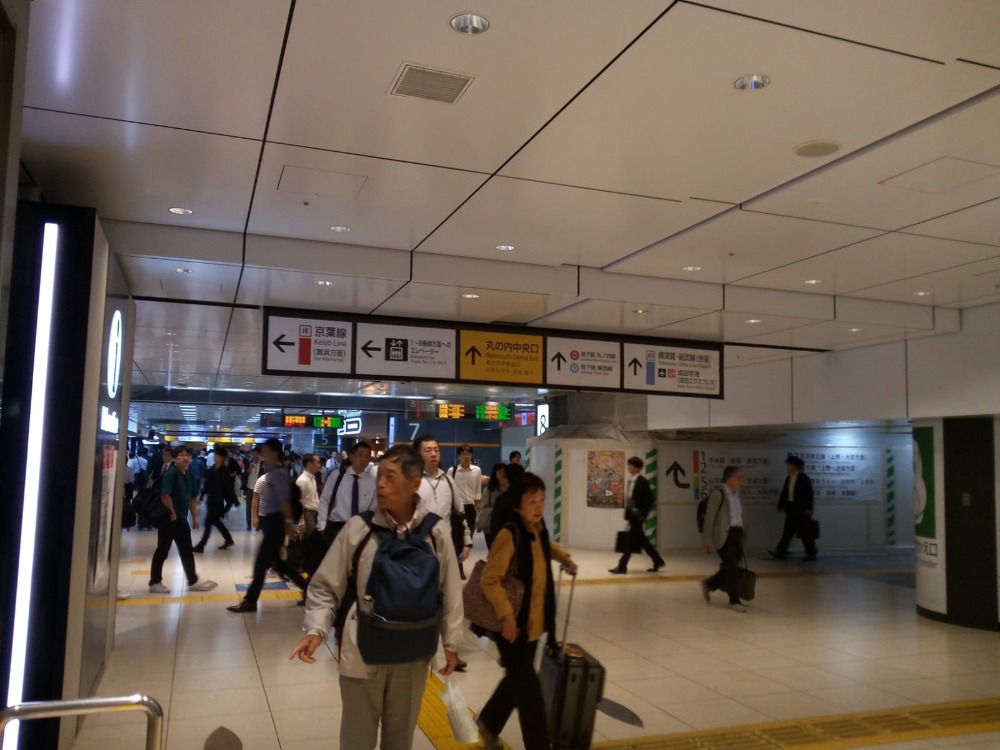
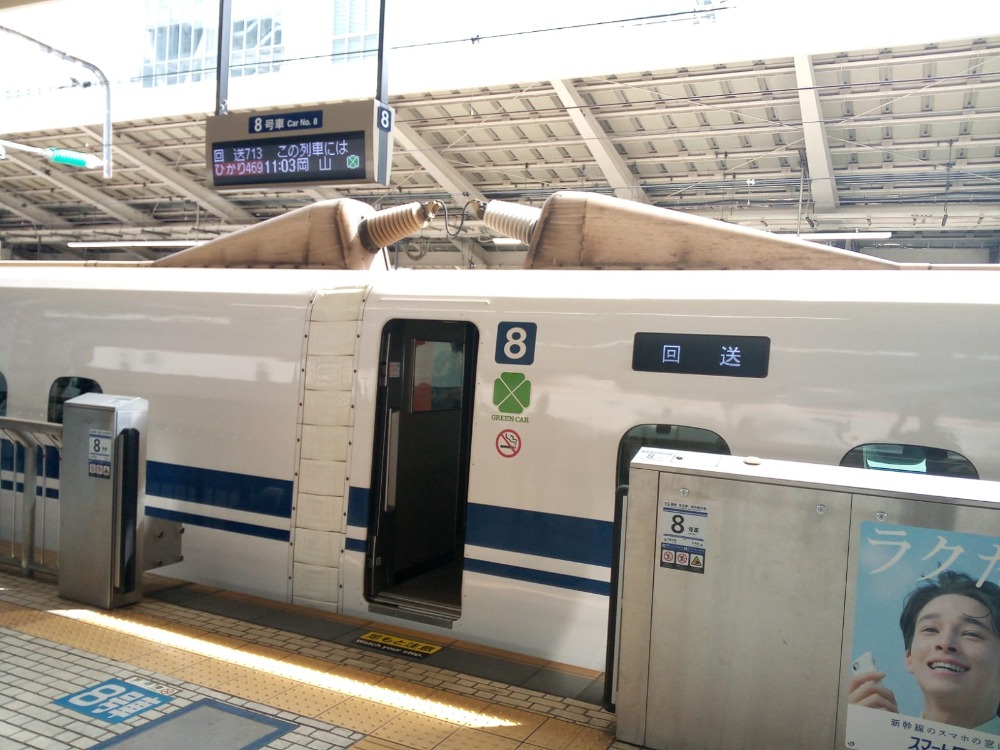
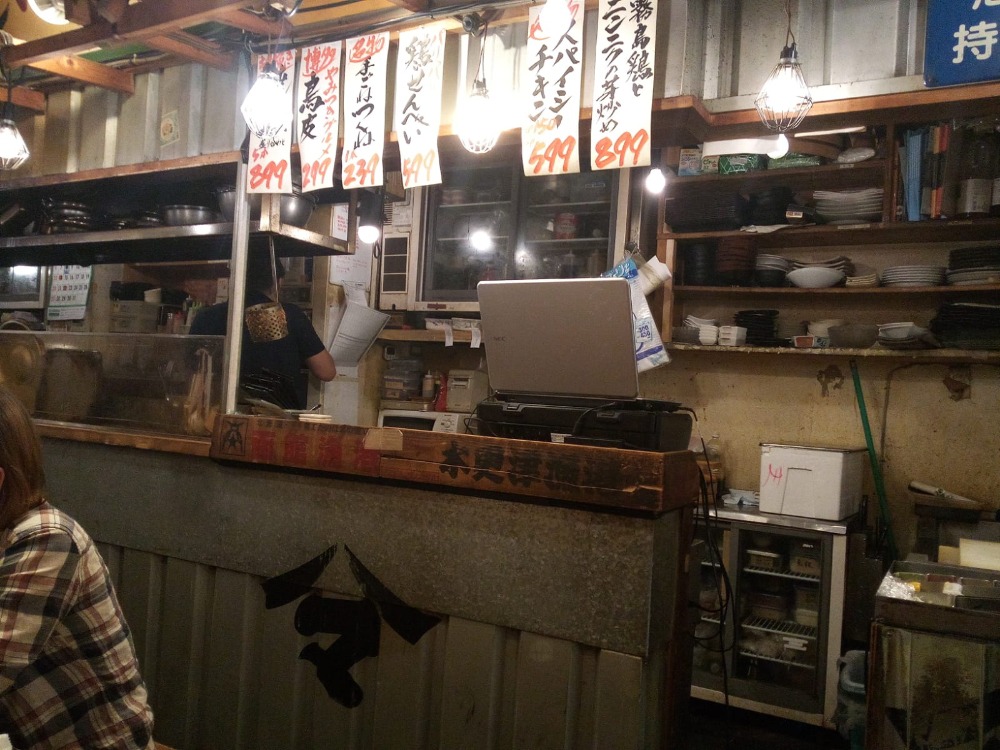
Tokyo station
A Bullet Train
Din-dins
Tuesday 8th October: The journey south to Kyushu Island
Today commences the journey south to Kyushu island in preparation for tomorrow’s match against Fiji. Get up at 07:00 and begin to pack. This isn’t difficult as the luggage was never really unpacked due to the lack of space in the hotel room that more likened a student’s hall of residence. Shower followed by a small nondescript breakfast then time to venture back out into the wild world of Shinjuku except at 08:30 it is rush hour in Tokyo. Wild has become super-manic especially as the temperature was over 20 degrees and both holdall and rucsac were also making the journey south. Shinjuku station was busier than previously witnessed and it was easy to imagine how 2 million people travel through this station every morning.
The rapid transits to Tokyo central station depart from platforms 7 and 8 every two minutes in rush hour. I caught a glimpse of a local commuter eyeing my luggage and the reason for this soon became obvious. There is yellow signage every ten metres on the platforms indicating where the carriage doors would open. There were orderly queues at each embarkation point. I joined one of these queues. But what happened next is still difficult to comprehend. A rapid transit train approached platform 7. When it arrived, commuter faces were squashed against windows in crowded carriages and yet, with the help of strong platform assistants, most of the waiting passengers were physically pushed into the carriage. This was not for me, so I stepped sideways out of the queue and gathered my thoughts as the next transit approached platform 8. A quick decision needed to be made and really there was no option but to join another queue, breathe deeply and wait for what happens next. This train did not seem as full as the previous train and there was initially room for a small Welshman and his luggage. Any spare space rapidly disappeared within seconds as the sturdy platform assistants shoehorned more and more passengers onto the already overfull carriage. Standing nose to armpit with one tall local and feeling like a sandwich filling between four others the train moved off. It was impossible to reach an overhanging handle in an attempt to stabilise my footing, but that didn’t matter as there was no room to fall as all the passengers swayed in unison in sympathy with the train’s motion. The air conditioning in the carriage was turned to maximum but it had little effect in cooling down the body heat generated by the patient commuters. Embarrassingly, I was the only person sweating- the others must be accustomed to the discomfort.
Unbeknown when boarding, there were three stops on this rapid transit to Tokyo central station. What a relief when after 8 minutes of hell, the train stopped at a Tokyo suburb and 80% of the passengers disembarked. There was space to sit under one of the AC vents which provided huge comfort for the remaining 12 minutes of the journey.
It was difficult to tell if Tokyo central station is as big as Shinjuku station for the simple reason that both stations are so vast, it is impossible to see their extremities. What is becoming obvious, is that railway stations form a focal point in Japanese cities and contain shopping centres, entertainment complexes as well as many cafes and eateries.
Time to take stock at Tokyo Central station in the middle of rush hour and seek out where the JR bullet train for Hakata, Fukuoko would depart. Luckily there are lots of station assistants in the many cavernous underground concourses. I eventually found platform 15 from where the 11:03 bullet train to Shin Kobe would depart. There was a nearby French coffee shop which provided much needed sanctuary for an hour or so.
As with all public transport in Japan, the bullet train was punctual to the minute even though boarding was not permitted until the multitude of cleaners had left the train. Similar to the UK, the Japanese rail network is run by different franchises for different regions. Each franchise has its own style of bullet train- all very futuristic, resembling horizontal space rockets. The first leg of the journey to Shin Kobe was aboard the Shinkansen franchise which differed from the second leg from Shin Kobe to Hakata.
We eased gently out of Tokyo central station before the afterburners kicked in. The acceleration was unbelievable and yet it still took more than twenty minutes until we reached the outskirts of Tokyo and the first of only a few stops at Yokohama.
Behind was a city of bewilderment. The logistics are unimaginable. So many questions unanswered. It is difficult to comprehend how a city of the size of Tokyo came about, and furthermore how it functions- and functions so efficiently. However, for now, I was pleased to leave Tokyo behind and travel southward in support of the Welsh national rugby team.
Footnote – there is one type of shop that you simply do not see in Tokyo – garden centres. When travelling overground through the endless suburbs of Tokyo, not one of the cramped, characterless houses and apartment blocks had a garden of any description- in fact there was virtually no greenery to be seen anywhere. Don’t ever consider opening a garden centre in Tokyo. Doomed to fail!
As the train rapidly journeyed southward, the scenery eventually changed. The urban landscape of the previous two days had been replaced by a rural landscape punctuated by industrial towns incorporating manufacturing, the likes of which we can only dream about in UK. Rice fields dominated the rural landscape and eventually lush, deep green forests covered the mountains either side of the broad valleys.
We passed through and stopped at Osaka which is yet another huge, sprawling Japanese city, and also host to some of the RWC2019 matches.
The train pulled into Shin Kobe at precisely 14:14 as scheduled where a change was needed to another bullet train heading to Hakata leaving at 14:22, luckily from the same platform. It was noticeable at Shin Kobe that in addition to the many locals, there was a splattering of red- Welsh shirts obviously heading in the same direction as myself.
 The 14:22 train left at precisely 14:22 and this next part of the journey was particularly scenic- meandering through deep valleys and tall rounded mountains with a dense deep green tree coverage.
The 14:22 train left at precisely 14:22 and this next part of the journey was particularly scenic- meandering through deep valleys and tall rounded mountains with a dense deep green tree coverage.
As we approached Hiroshimo, I was overcome with a strange tingling emotion and tried to imagine the devastation caused to the people and landscape by the US activities in 1945. Should we be grateful to the US as apparently this activity brought about the end of the Japanese hostilities in WW2? The train left Hiroshimo and so the thoughts moved onto to happier times. Furthermore, it was time for a doze.
Arrival at Hakata was 16:40 and the walk to the Hakata Green Hotel was only four minutes from the station. Room 814 was slightly bigger than the student-type accommodation at the Ibis but the atmosphere in the room was more businesslike. Similar to the Ibis, there were only three coat hangers and little room to unpack.
Time to consult the map and guide leaflet picked up at reception and devise a plan for the evening entertainment.
The Hard Rock Café (HRC) was only a 15 minute walk from the hotel and offered a welcome break from the local cuisine. HRC was on the second floor of a modern office block in downtown Hakata. The walk to the HRC gave the impression that Hakata is a lot more modern than Tokyo, much less busy and more akin to a western city than the traditional Tokyo. There was more space and less bustle which gave rise to a much more relaxed ambience.
A couple of beers with dinner whilst being entertained by a combination of music and the South Africa vs Canada match being shown on the many TV screens. There was a table of ten Welsh fans in the HRC so had a quick chat only with them when leaving. Feeling jaded and travel weary so an early night was in store.
A relaxed walk back to Hanada Green Hotel picking up a white choccie bar on-route at the nearby 7-11 store. Time to send a few messages before an early night in preparation for the 2.5 hour bus journey to Oita tomorrow to watch Wales play Fiji.
Wednesday 9th October: Match Day- Wales vs Fiji
Woke up at 6ish as a consequence of the early night on Tuesday. Made a coffee in the bedroom/closet and caught up with “stuff” via the hotel internet. Had decided the previous evening that following the travel of recent days the body was in desperate need of exercise. A route was planned using the detailed map of Fukuoka and at just after 07:00 set out for a two hour walk with the aim of taking in the recommended sites of the city.
Outside, the temperature was cool and the morning rush hour had not started in earnest as I set off due north along one of the main routes heading toward the port and marina. The city is much more modern and with much wider streets than Tokyo with space to breathe and look around. It wasn’t long before came across the first of many temples for which Fukuoka is famous.
One of many things to learn in Japan is always wait for the green light at pedestrian crossings before venturing across the road even if it is obvious there is no traffic. The locals are diligent and patient. The biggest threat as a pedestrian is the many cyclists that speed along the pavements riding their “sit up and beg” cycles including a sizeable shopping basket which could incur significant damage on an unsuspecting pedestrian. They are a menace and impossible to hear when speeding up from behind.
There were many cleaners of different varieties at this early hour. Street cleaners, office cleaners, even the shop keepers were cleaning the front of their shops and I even caught a glimpse of somebody dusting an advertising board.
Consulting the map and giving careful consideration to the electronic “green man”, I crossed a main highway and then turned right heading toward the Naka river. By this time and thirty minutes into the walk, commuter traffic on foot and road was noticeably busier. When reaching the river, turn left along a walkway following the banks of the river to the port of Fukuoka. Turn left at the waterfront just as a passenger ferry was leaving the terminus. By now it was an hour into the walk and time to head back toward the hotel along a different route incorporating narrower yet interesting side streets with the occasional small shop, café, 7-11 minimarket or temple.
It is relatively easy navigating a walk in Fukuoka as the streets are laid out in a grid fashion, similar to US cities, so no excuse for getting lost. Back on the main road heading toward Hakata station and the Hakata Green Hotel, the temperature and number of commuters had both increased even more. Japanese business people, both men and women are very smart, but the pace and urgency of Tokyo was nowhere to be seen. Umbrellas were used by commuters to shelter against the sun. Unprotected, I could feel the perspiration on my Welsh football shirt following the most exercise undertaken for almost a week.
On the return walk to the hotel, I checked out the location of the meeting place designated by Inside Japan for the coaches to take us to Oita and also a suitable bakery to purchase some munchies for the journey.
Breakfast was a lot more interesting than at the Ibis and this was my first time to experience noodles combined with scrambled egg. I didn’t know what comprised the other ingredients of the plate which was eaten with a fork and spoon and not chopsticks like all the other breakfast diners.
A much needed shower, then pack a small rucsac with essentials for the long return coach trip to Oita, including a large Welsh flag. Get changed into an Admiral-sponsored Welsh rugby shirt then off to a café for morning coffee before the rendezvous at 12:15 in front of the east entrance to Hakata station. Following coffee at the modern Café Veloce, there was an important stop to be made at the bakery for goodies and a bottle of water.
The reason for having a coach journey organised by Inside Japan to Oita and for staying such a long way away from the match venue, was explained by Mark, one of two Inside Japan representatives for the journey. The other was Rachel who had a fantastic valley accent and wore a Welsh rugby shirt underneath her green-and-white Inside Japan outfit. All accommodation in the seaside resort of Oita was fully booked nine months before the tournament even started. Many tour operators then secured both rooms and train tickets in Fukuoka for their clients. Every train between Fukuoka and Oita for that morning was fully booked months ago, hence Inside Japan took the initiative to increase their booking capacity with the coaches.
Most of the passengers on the two coaches were Welsh, although I sat amongst a couple of Aussies (father and daughter) and an Irish guy with a very strong Irish accent; genuine rugby fans taking in as many of the RWC2019 matches as possible. Stories were swapped about itineraries, venues and the usual “stuff”, before deciding to resort to the iPod and take in the journey for which once again we were totally ill-prepared.
This was to be one of the most stunning and scenic journeys I have ever taken. We journeyed through the absolutely beautiful Kyoshu mountains. The Oita expressway traversed dense and lush mountains and then across the cultivated valleys. The beauty and cleanliness reminded me of Switzerland. At last we were witnessing typical Japanese architecture in the rural villages rather than the characterless apartment blocks of the main cities. Wooden chalets with tiled roofs and every spare hectare cultivated with rice, salad crops and other fruit and vegetables crops. Extensive lemon plantations grew on the lower slopes of the mountains whilst rice cultivated the flood plains of the many rivers that had carved their valleys into the tall yet rounded lush green mountains. Every Japanese person that isn’t cleaning is either manufacturing something or growing something. A simple society focussed on sustainability. Why and when did we go so wrong in UK?
The beauty of the countryside was so overwhelming that it caused goosebumps to appear. Words fail to adequately describe the scenery as we travelled toward our destination at Tanoura Beach, where we would meet up with the shuttle buses headed for Oita stadium. Approaching Oita, we were still perched high in the mountains overlooking the resort of Beppu which joins into Oita. The lush green hills were to the right and a stunning view overlooking the coast beneath us and to the left. We commenced the descent to Beppu and then on to Tanoura beach car park. There was a welcoming committee of RWC2019 staff to everybody who parked at Tanoura beach which was located immediately across the coast road from the sea.
The shuttle buses left every ten minutes for the 30 minute ride to Oita stadium which is located in an extensive open sports complex in parkland high above the city of Oita. The many coach parks were extremely well organised with different locations for each shuttle destination, the largest of which was for the coaches from Oita station. Tanoura beach coaches arrived and departed from car park 3; must remember that number after the match finishes.
A 1.5 km walk through the massive park along a well-signed walkway together with an increasing number of rugby supporters. Lots of RWC2019 employees lined the route to greet us with high 5’s and answer any questions. The customary bag and body search as we entered the stadium perimeter was very well organised and no queues. It was just over 1.5 hours to kick off so plenty of time for a local hot dog and a pint of Heineken – the latter have RWC2019 sewn up for alcohol sales.
Beer was allowed into the stadium so gave plenty of time to find my seat which was adjacent to the 10m line opposite the TV cameras. There were locals in the seats next to me and close by a Welsh lady with a lovely Carmarthen accent. Her husband is the commentator at RWC2019 for Welsh speaking S4C, Wyn Gruffydd. He was sat in the press box opposite whilst she was completing soduko puzzles trying to pass time to kick off. I watched the Welsh team go through their pre-match routine before talking with Missus S4C who had some wonderful stories about their visit to Japan. They had been in country for more than a month and the logistics of transferring all S4C equipment from match to match was mind-boggling. A bus has been hired by S4C for the next leg of the journey to Kumamoto for the Wales versus Uruguay match on Sunday.
The Welsh flag packed in my rucsac was draped over the seat in front and the charming Japanese ladies sat to my left took great pleasure in waving the flag at all possible opportunities. One of the ladies’ sons appeared and insisted on a “team” photograph.
Time for the anthems. It was peculiar singing the Welsh anthem with very few other Welsh people nearby. You could hear your own voice, which was a little off-putting. Most of the crowd were Japanese and were obviously supporting the underdogs and they created a deafening noise whenever the Fiji team took possession which sadly was all too often in the first 15 minutes. The Fiji players were huge and very quick. They looked dangerous every time they attacked and they did so with such strength and force. Wales gradually forced ourselves back into the game as Fiji took too many risks and eventually tired. There were high 5’s with the Japanese supporters to the left and right every time Wales scored heading toward the bruising 29-17 victory. A fantastic spectacle for neutral fans.
After the final whistle there was time to stay behind and watch both teams on their bows to the crowd and lap of honour. I commiserated with a lovely Fiji husband and wife sat just behind before heading back in the now-illuminated walkway up through the park to Car Park number 3. There were hundreds of shuttle coaches ferrying supporters to their destinations and after 10 minutes the bus arrived destined for Tanoura Beach.
Feeling weary now as it approached 23:30 and the effects of a long day and a few pints of Heineken were taking effect. We transferred from the shuttle to our Inside Japan coach, a few pats on the back and congratulations with fellow passengers then the iPod was back up and running. It didn’t take long before falling into a lovely sleep listening to Steve Harley and Cockney Rebel. It seemed like only a few minutes had passed before we rolled into a scheduled stop at a service station for a pee and sandwich break. In reality, an hour and a half had elapsed.
Couldn’t get back to sleep as we travelled the final hour from the services back to Fukuoka railway station. A brief walk to Hakata garden hotel then literally fall into bed at 02:15 am. What a day- in so many meanings of the word. The morning walk at 07:00, the stunning drive along the Oita Expressway, the atmosphere building in and around the stadium, people met and one of the most brutal rugby matches I have witnessed.
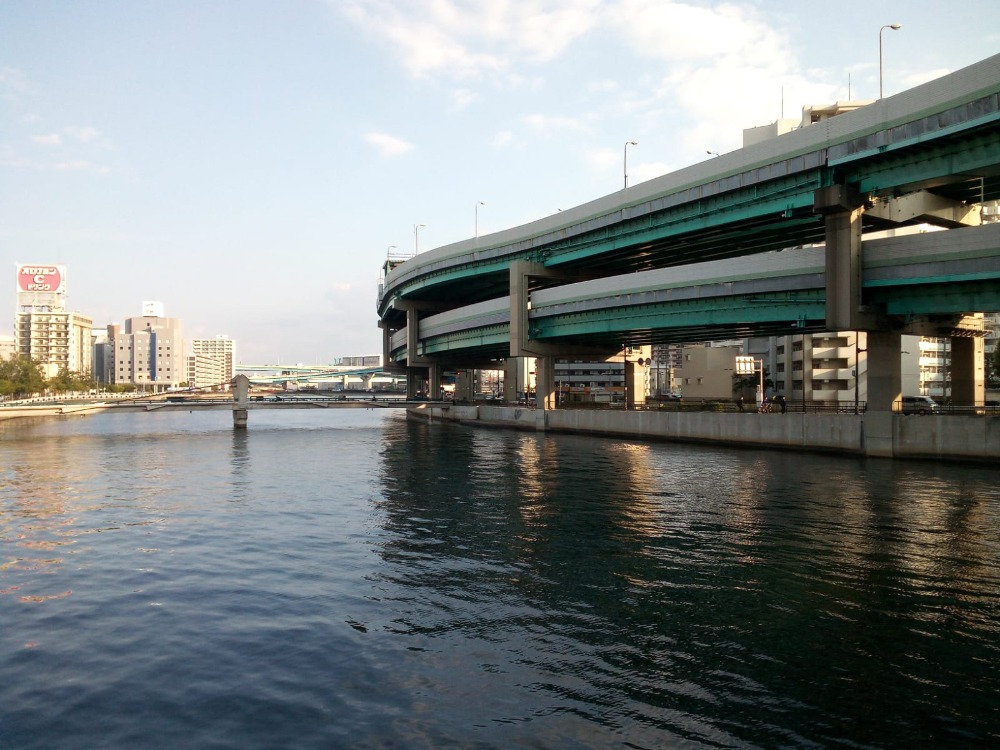


Amazing road system in Fukuoka
Fukuoka marina
One of many temples in Fukuoka


Just outside the stadium
Oita Stadium
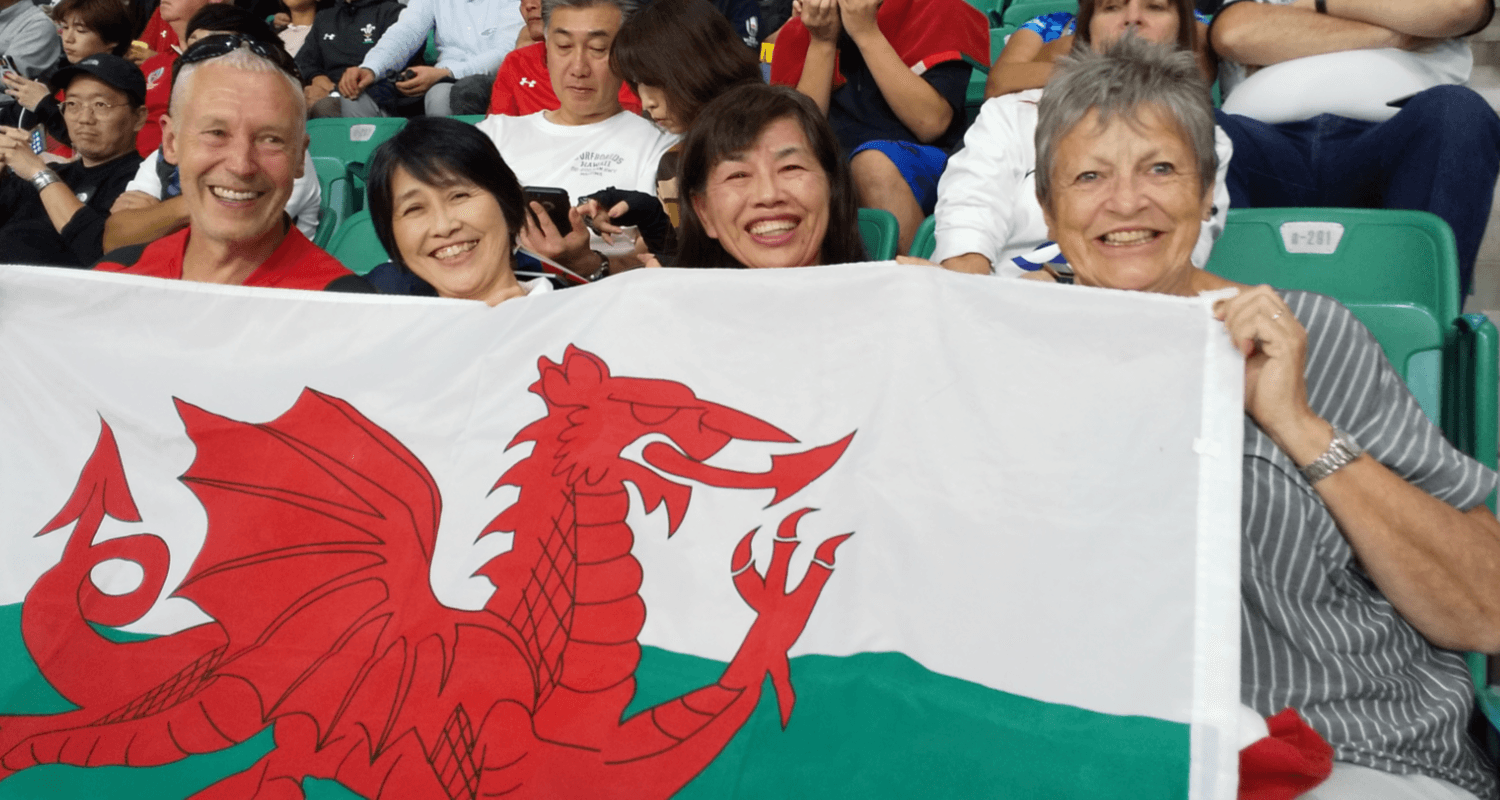
With new friends at Wales-Fiji
Thursday 10th October: Nagasaki
Didn’t wake until gone 08:30, following the previous long day of excitement. Shower, re-pack holdall, quick local breakfast at hotel and then brief walk to Fukuoka station for the 10.55 JR train bound for Nagasaki. In this land of patience, discipline and queues, I firstly joined the queue at the ticket office and then the queue on the platform for carriage number 2.
This train was much slower than the bullets and consequently allowed a closer look at the countryside and dwellings. Every house and every flat in each block had both a clothes line and four recycling bins on their balconies or small gardens. Such is the education and discipline toward sustainability of the Japanese people (130 million people) that recycling and conservation of electricity (no tumble drying) is to the fore of every household, hotel and office block. There was even clothes drying hanging out next to railway lines.
The first half of the journey was uneventful, but the journey became more interesting as we reached the coastline of the Nagasaki peninsula. Here the trainline runs adjacent to the coast where another of the Japan’s industries became apparent. Tall bamboo canes projected vertically upward from the shallow waters just offshore, this being one element of the extensive fishing industry for which Japan is famous and is the origins of sushi.
The JR limited express arrived into Nagasaki as stated in the Inside Japan itinerary promptly at 12:49. It is amazing that an itinerary compiled many months ago in the UK many thousands of miles away can state exactly what time each of journeys will both start and end and be so accurate.
The Richmond hotel was two kilometres form Nagasaki station and by now the temperature was 28 degrees so for the first time in Japan I used a local taxi which cost 800 yen (just over £7). The Richmond hotel is located down a very narrow, old fashioned side street in a district known as Shianbashi. The hotel was new having only opened earlier this year. I asked the charming receptionist about an upgrade to a bigger double room as a personal treat after tolerating the enlarged closets of the two previous hotels. The decision was easily made at £5 per night – the same price as one beer!
Similar to the rest of the Richmond hotel, the room was modern, clean and spacious (a result). At last the holdall was unpacked for the first time and even managed some handwashing of smaller items of clothing.
A brief snooze and then venture out into the afternoon sun for sightseeing in Chinatown, Nagasaki harbour and along the many boardwalks to a peaceful park. Apparently, the design for the boardwalks originated from the more famous wooden coastal walkways in San Francisco bay. They certainly looked and felt similar.
The street map picked up from the hotel was getting good use and allowed me to get my bearings for the remainder of the two day vacation in Nagaski. There were a number of attractions to keep visitors entertained. Stopped off for a late afternoon cuppa on the way back to the hotel as dusk was just beginning to show its golden glow over the mountains perched above Nagasaki city.
The plan for the evening was a meal in Chinatown- recommended by all guides to Nagasaki. But on arriving in Chinatown, disappointingly, the restaurants were very bright and not very welcoming so decided on a detour and take in refreshment at a couple of bars whilst considering a Plan B.
Being a seaside town with many holiday type attractions, Nagasaki is a popular tourist resort; however there were very few oversees visitors to be seen compared to Tokyo and Fukuoka. The many bars are unusual in that they are generally very small and narrow with 6-8 barstools and very little other space to stand. I was the only person it the two bars I visited whilst considering Plan B for din dins. The barmaids in both places seemed excited by the presence of a foreign customer, but conversation proved difficult and I promptly set off for a restaurant I recalled from the afternoon excursion which looked relatively attractive from the outside and had a few English words on the menu. There were a handful of locals eating to the left as I entered the restaurant and there was a peculiar aroma… perhaps smell is more accurate. I was immediately greeted by a lady and then her husband and that was it. No escaping.
The husband and wife (Mr and Mrs Mizota) proved to the owners and they seemed very proud that a foreigner considered eating at their restaurant, the Katarou. Mr Mizota ushered me to sit at a perched bar which is the typical format for many Japanese restaurants. Mr Mizota sat next to me and quickly guided me to the set menu. To be honest, I didn’t feel as if I had much choice in the matter. He stayed perched next to me for the duration of the multi-course meal. He was 74 years old and talked extensively about his life in Japan, South America and Europe working for Unicef following studying for a doctorate.
The courses were dominated by fish much of which was uncooked but tasted good in a dip of soy and crushed garlic (manager recommendation). The owners and their two staff laughed loudly as I endeavoured to finish the gravy broth with a rice spoon. Not good etiquette, but there was no chance of finishing with chopsticks so I thought it was the logical solution. Apparently not so.
At the end of the meal the three us celebrated with a toast of local wine when I told them their restaurant will become famous in Wales via a website called parallel.cymru.
The wife accompanied me to the front door and we said our goodbyes with no-one else left in the restaurant. The Richmond hotel was only a few minutes walk through the narrow backstreets of Shianbashi then, travel weary and straight to bo bo’s.
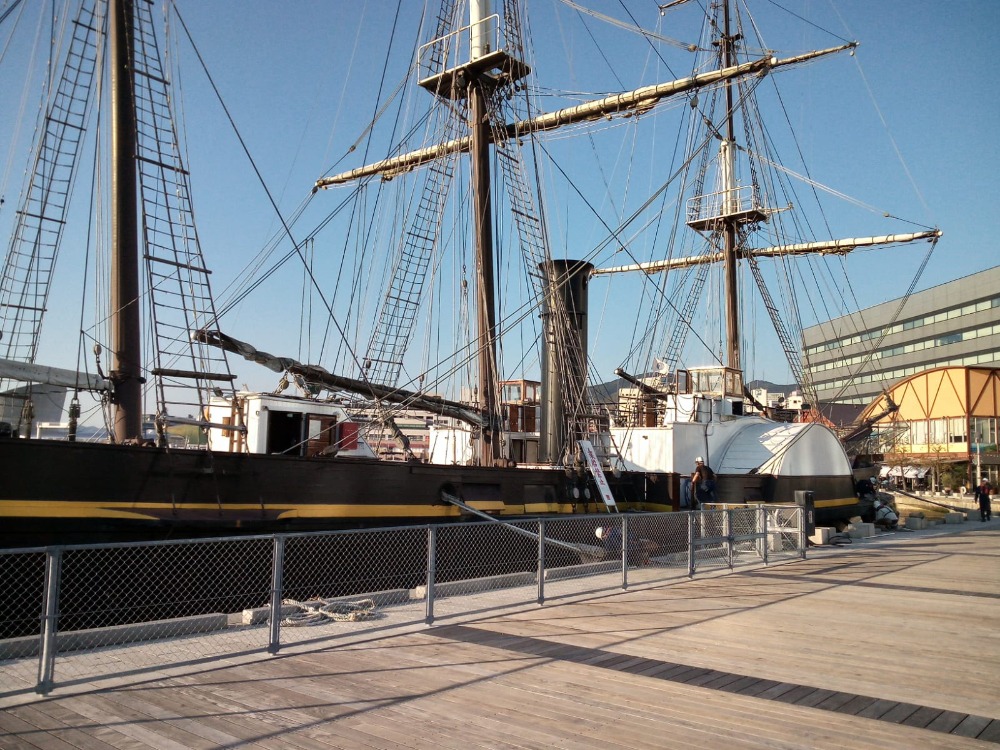
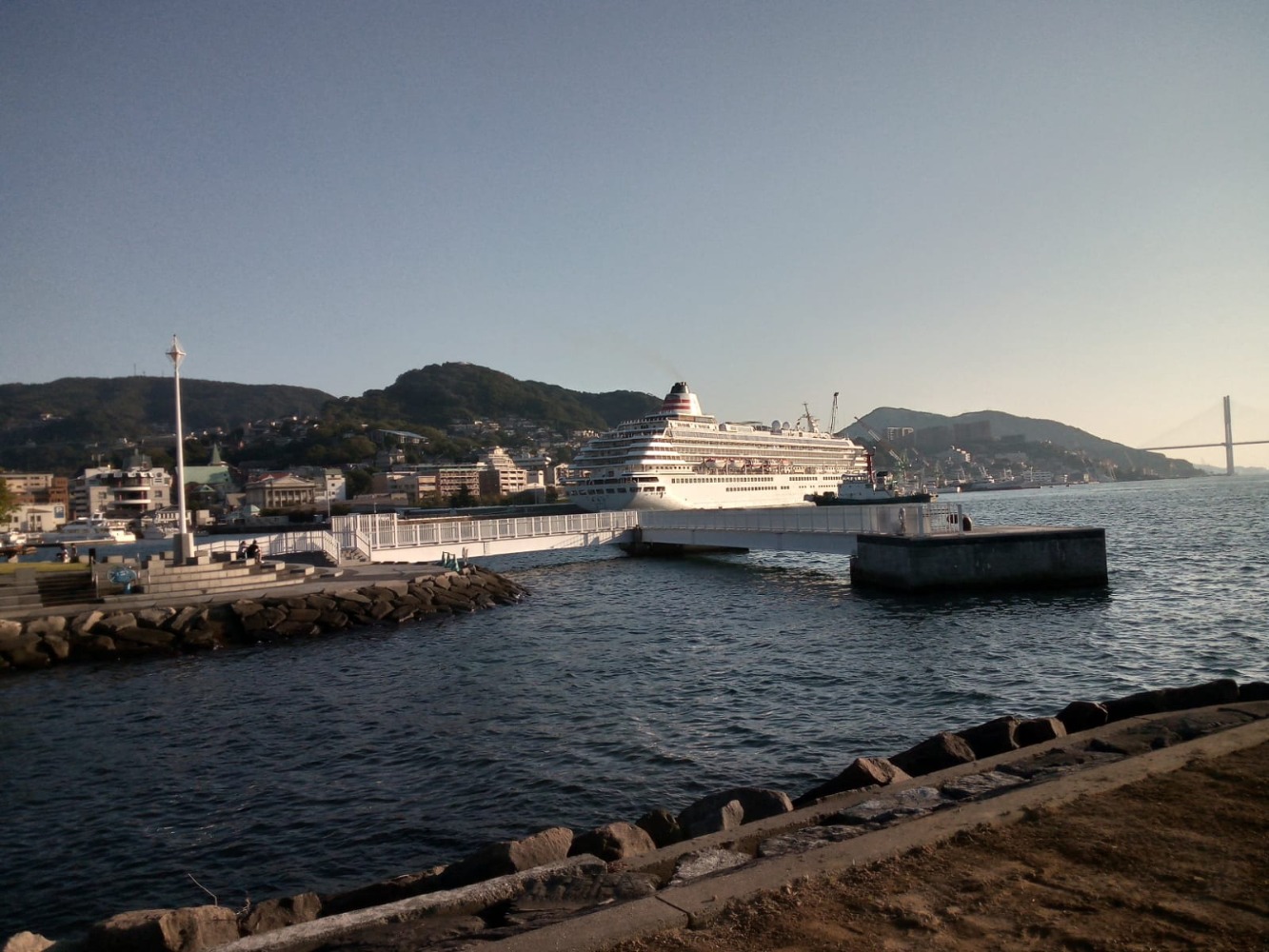
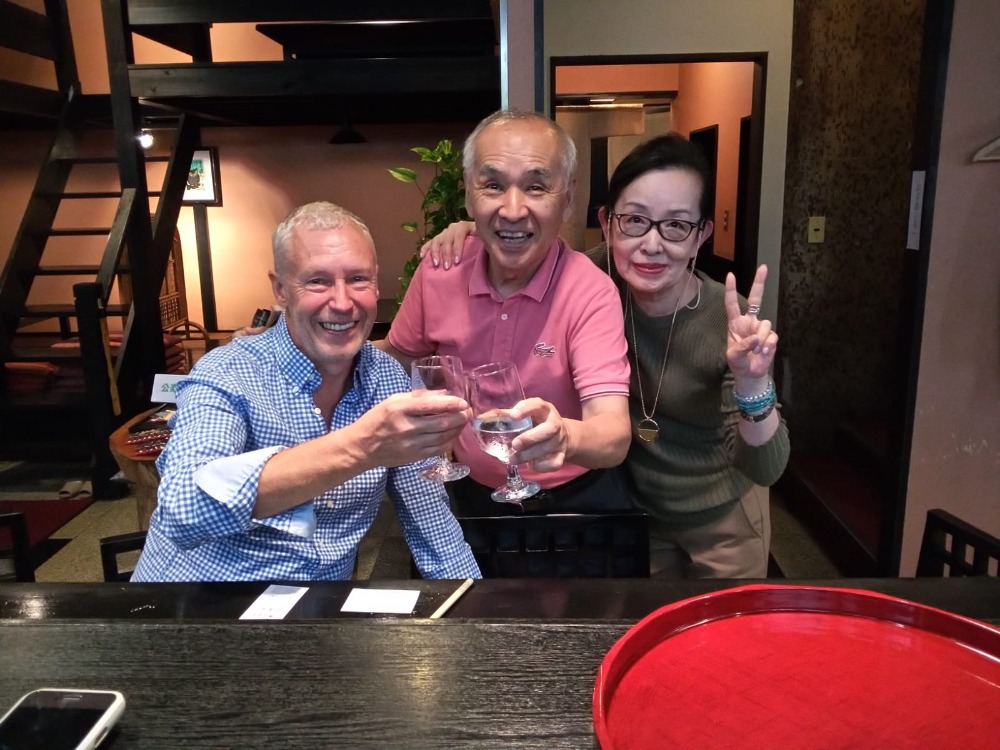
Traditional boat at Nagasaki boardwalk
Passenger liner leaving Nagasaki
Toast with owners of Katarou restaurant
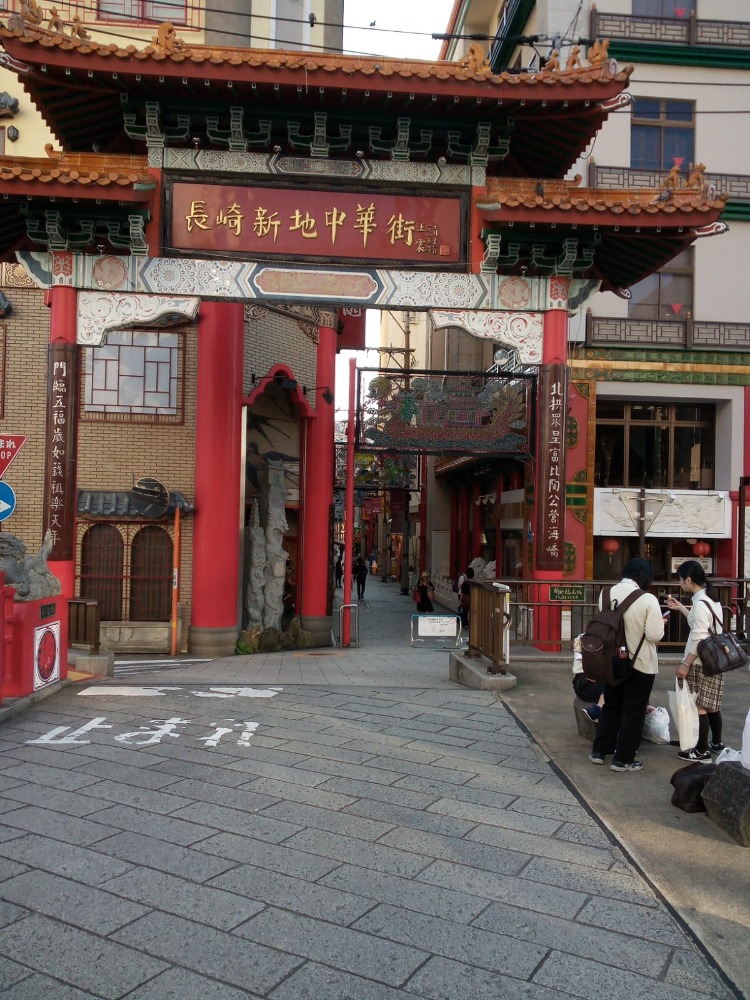
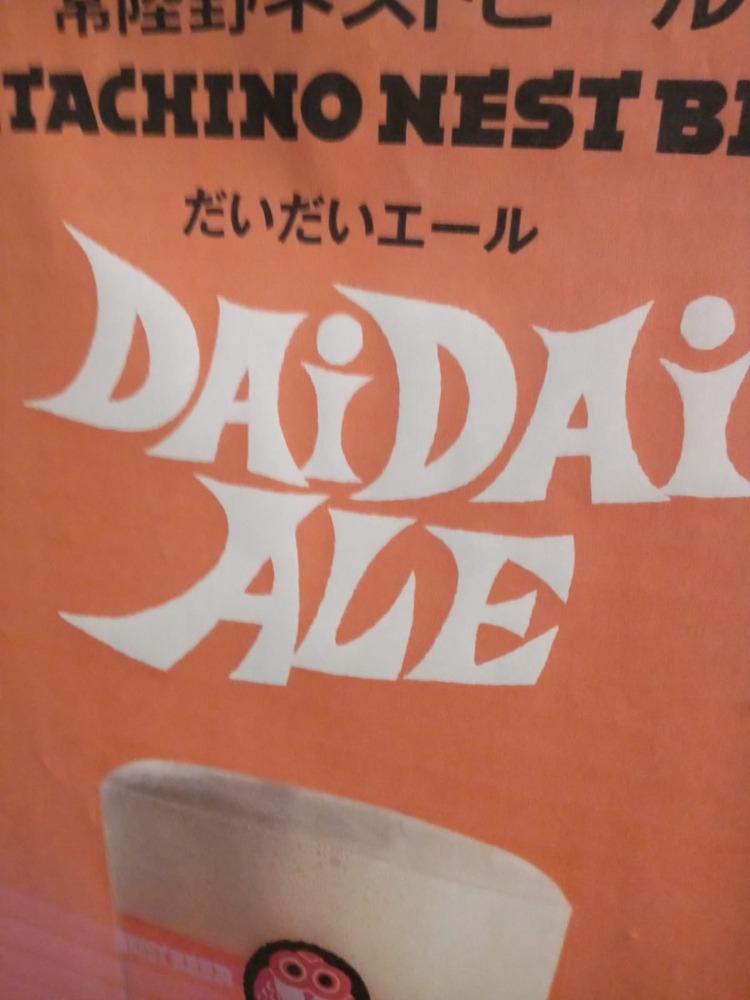
Nagasaki Chinatown
Coincidence
Friday 11th October: Nagasaki
Today is holeeeeeday in Nagasaki. Decided more exercise was needed so a route was planned to Peace Park which is about 3 miles each way. Set off through downtown Nagasaki toward the waterfront at 06:50 with map in hand. Walked along the waterfront and then north along the banks of the river toward Peace Park which took just short of an hour. A quick look around the park then head back south toward. By now the temperature was rising and feet beginning to swell; I could feel a blister developing so slowed down. Had not seen any foreigners until stopped at a road crossing waiting for the green light to appear and a couple of joggers appeared from behind one wearing a Welsh running vest. Had time to swap stories about the game at Oita before the lights changed to green and the husband and wife jogged off in front toward the waterfront and downtown. I followed some distance behind, back to the hotel for a shower then a Japanese breakfast.
Having studied the guides and visited some of the sites the previous afternoon, a decision was made to head for the atomic bomb museum which was close to the morning walk to Peace Park. The morning temperature had risen quite dramatically as I headed for the “blue” tram stop and the 25 minute ride to the station named after the atomic bomb museum.
The museum was extremely informative but also emotional. Two hours were spent looking at photographs and models illustrating Nagasaki before and after the bomb was dropped and also reading about the events leading up to the bombing and also the horrors caused. There was total devastation to the landscape and population for miles around. More than 75,000 people were killed on the morning of August 9th, 1945 and 100,000 were injured. The museum describes the horrific illnesses suffered by the injured in months and years to come. The atomic bomb at Nagasaki was dropped a few days after the first atomic bomb at Hiroshima which caused similar devastation. It is not surprising that the Japanese surrendered a short time afterward, bringing to an end World War 2.
On leaving the museum after two hours, it was difficult to take my mind away from what I had just witnessed. A walk through Peace Park where there is a memorial at the hypocentre of the bomb and then on to another park on the other side of the main road. This was the sporting centre for Nagasaki with baseball, rugby and athletic stadiums together with a 50m national swimming pool.
The afternoon temperature had reached 29 degrees as I returned on the blue tram route toward the hotel and a late afternoon tea in the welcome of an air conditioned café.
The plan for the evening was a beer and meal at the wharf area close along the boardwalk and close to the port. The wharf was a small gathering of cafes, bars and restaurants overlooking the marina. It was a 20 minute walk from the Richmond hotel through Chinatown. It was dark by the time the first beer was consumed and the wind had noticeably increased. Typhoon Hagibis was more than 800 miles away heading toward Tokyo bay but it’s effects could be felt even from this distance.
Dinner was a dish called ramen, one of the local specialities made with noodles – yum yum! The other diners were all Japanese; however just as I was leaving a couple of guys wearing Welsh rugby shirts appeared. A quick swap of pleasantries then head back past Chinatown toward the hotel in the Shianbashi district.
There was still time for a nightcap or two in a typical bar opposite the hotel. This bar was slightly larger than most with 8 barstools and also surprisingly, two tables. There were three very friendly barmen but no other clients. Apparently, the nightlife begins around midnight, which is way past my bedtime. We endeavoured a conversation, and they frequently resorted to their mobile phones for translation. One even triumphantly found the Penderyn whisky website!
Cross the very narrow street to the comfort of the Richmond hotel and off to bed wondering whether I will wake at 03:45 for the Slovakia versus Wales football match
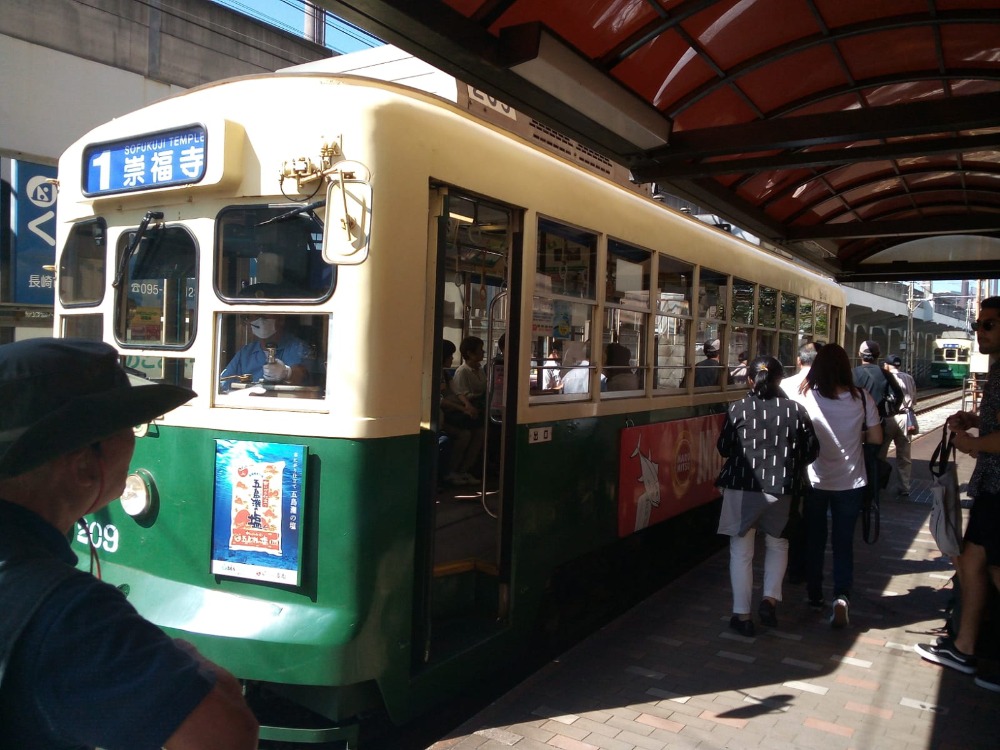

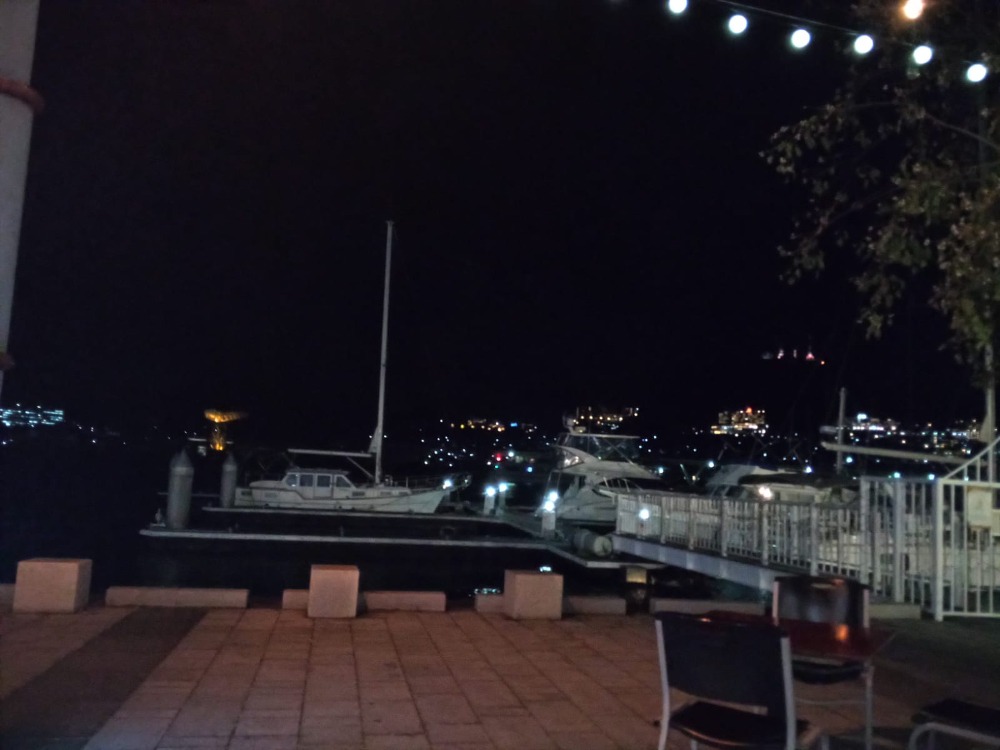
A blue Tram at Peace Park
Early morning walk at Nagasaki waterfront
Nagasaki wharf at night
Saturday 12th October: The epic journey from Nagasaki to Kumamato
The tour operator Inside Japan had complied a scenic transfer from Nagasaki to the next destination of Kumamoto, where Wales play Uruguay on Sunday 13th , tomorrow. The journey was scheduled to incorporate a tram, three buses, a ferry and a train. There was to be a sting in the tail courtesy of typhoon Hagibis.
Up at 06:30 but little packing this morning as the holdall had been forwarded to the Canedeo hotel in Kumamoto courtesy of a wonderful service provided throughout Japan. For a nominal fee, depending on size and weight, luggage can be forwarded to any nominated destination for next day delivery. Due to the complexities involved with today’s journey, this seemed an opportunity too good to miss.
There was a short walk to the tram station via an ATM inside the 7-11 store to top up cash reserves. The blue tram arrived within five minutes for the twenty five minute transfer to Nagasaki station where the first bus to Unzen would depart.
Woke up with toothache that morning and wasn’t feeling great as I searched for the bus terminus at Nagaski station. A lesson learnt during this trip is to arrive early for the start of each journey. This is on the basis that not all destinations have English signage and not all destinations are as obvious as maybe expected. Arriving early for departures is not really something that comes naturally to me as people who know me will vouch. But this adventure required a modification to normal behaviour patterns.
I asked a few random passengers where I might locate the Unzen bus. Their English was as good as my Japanese and so eventually resorted to an information desk inside the railway station. This proved to be a good move as the bus terminus was located within and beneath a brown building on the other side of a very wide and busy road and reachable only by a pedestrian bridge.
By now, and with the toothache becoming increasingly annoying, I thought seriously about the wisdom of the planned complex, scenic journey to Kumamoto or whether to be damned and take either a direct train or bus, both of which were available from Nagasaki station.
In the bowels of a warm, airless terminus, sweating and in pain waiting in the queue for the 09:05 bus to Unzen, there it was, a direct coach to Kumamoto. No, I was not going to succumb to temptation so boarded the bus for Unzen which unbeknown to me, is a mountain resort high above the east China sea and used predominantly by trekkers.
The journey took 1 hour 40 minutes passing initially through the suburbs of Nagasaki and then many picturesque villages and towns before beginning the ascent to Unzen. This was true Japan and many of the homes in towns and villages had small solar panels on their roofs, chargers for their electric cars (what a wonderful concept, to power a car from solar energy!), water butt and the mandatory recycling bins. Must mention once again the washing lines which are a work of art, some of which resemble scaffolding. The nation is so environmentally aware and disciplined. There is much we can learn in UK if we are to preserve our island in the same way.
As the bus climbed steadily toward Unzen, the wind relating to typhoon Hagibis became worryingly strong. The bus began to rock with the wind as it meandered around the hairpin bends. The pine trees on the mountainside swayed in what was now becoming a gale force wind. There was much tree debris blown onto the road. I was becoming concerned about whether the ferry scheduled for the afternoon would be sailing in such conditions. Luckily internet was available. Having located the number of the ferry company on my itinerary I called and eventually was put through to somebody that spoke English. The ferries were still running at 10:30 but if the wind increased any further, then I was told that for safety reasons they would be cancelled for the day. My crossing to Kumamoto was scheduled for 15:30.
The scenery was dramatic as we continued the climb toward Unzen mountain station. The smell of the sulphur from the steam rising out of the hot springs was pungent. The trees were swaying even more now as concern grew greater about the safety and comfort of the impending ferry crossing. Time to consider alternatives. One possibility was to turn around at Unzen and retrace tracks to Nagasaki. Other possibilities were taking a train or bus from somewhere close to Unzen or Shimabara ferry port onto Kumamato.
Unzen is an attractive mountain resort typical of many in the Alps together with log cabins and stylish retreats. The bus station was a very small building and it quickly became obvious that the lady behind the counter spoke no English. My best friend, Google, advised me that it was indeed possible to take a train journey from Shimabara to Kumamoto. The journey required three different trains and took more than three hours, but at least there was a realistic option to the ferry crossing to Kumamoto.
I boarded a local bus at 11:15 from Unzen mountain resort heading to Shimabara port and apparently thereafter to Shimabara railway station. The bus descended, tackling hairpins and with the wind howling through the gap under the front entrance. This local bus swayed even more than the previous coach. After more than 40 minutes of the descent, the harbour and sea came into view as did two boats rocking quite violently on the water. It was approaching midday; my ferry booking was for a 15:30 crossing.
Inside Japan had scheduled a few hours break at Unzen to walk through the nature reserve taking in the volcanic springs. This opportunity was declined with the strong winds blowing debris from the pine trees and the uncertainty of the journey.
As the bus pulled into Shimabara harbour a decision had to be taken quickly. Do I get off and hope the 15:30 ferry would sail across the choppy channel to Kumamato or should I stay on the bus in the hope it stops at Shimabara railway station where Google stated a local train leaves at 12:18 heading north to a mainline station. I wimped it, stayed on the bus ,which after a further 5 minutes pulled into a stop and the driver ushered me to get off. There was no train station, this was a bus terminus. Luckily one chap inside the terminal spoke a smattering of English and relayed something to the driver who by now was laughing at me in a not very pleasant manner.
Conscious the time was getting closer to 12:18, the bus pulled away from the bus terminal with only myself and the not so sympathetic driver. A further 5 minute drive through the streets of Shimabara which can be best described as a typical dirty port town or “dump”. At last, the bus came to a stop outside a tiny railway station and only one platform. I showed my 10 day green railcard and in sign language was advised this was a local railway line and green travel cards were not valid. Bought a ticket from the ticket office with the one carriage diesel train waiting on the only platform. The train reminded me of those used on the Valley Lines 40 years ago.
Obviously the only non-local person inside the very basic carriage, I sat opposite an old lady who was eating little bread rolls with no filling. I resorted to the iPod in an attempt to relax and take stock of the situation. The train travelled slowly due north along the coast stopping at tiny stations on the way. There was only one railway line with occasional passing points for the carriage chugging in the opposite direction. The railway was so close to houses we could look through their windows. The passengers from these coastal villages were obviously not as wealthy as city dwellers.
After an hour and twenty minutes journey the carriage chugged into Ishaya station which ironically was only two stops or ten minutes up the line from Nagasaki, where today’s journey started. It was now gone two o’clock as I boarded the train from Nagasaki to change at Shin Tose for the Shinkansen bullet to Kumamato. Beginning to breathe easier again now as Plan B conceived at Unzen and confirmed at Shimabara port was taking shape and the stress and uncertainty experienced at Unzen mountain station was a disappearing memory.
Arriving at the large Kumamoto station I hunted a pharmacy or drugstore as they are referred to. A conversation ensued with the pharmacist which involved translation sheets where “toothache” was pointed to. The powders were expensive but were a “must buy” item in an attempt item to get relief from nagging pain.
The final leg of this epic adventure was as stated in my Inside Japan itinerary, the JR Hohi mainline commuter train from Kumamato main station to Higo-Ozu. Then, a ten minute walk to the Candeo hotel where I arrived at 17:00 having left the Richmond hotel, Nagasaki at 07:30 in the morning. The Candeo is a characterless 10 storey building located along a main road amongst many car showrooms, car service bays, franchises, KFC and a few other characterless hotels.
Reunited with my luggage at reception, I checked into a comfortable but small room. Yet again not enough space to properly unpack the holdall.
All previous hotels selected by Inside Japan were city centre locations. The Candeo was in a quiet suburb of Kumamoto close to the airport and 35 minutes on the Hohi line from the city centre. This hotel proved to be contentious with some other Inside Japan (IJ) clients staying at the Candeo. The two IJ representations (Mark and Rachel, the same as those on the coach from Fukouka to the Wales v Fiji Match), explained this was the only viable accommodation available to those who booked less than nine months before the tournament as all city centre hotels had been booked 12 months in advance of the tournament. Rachel and Mark were also staying at the Candeo which seemed to appease the disgruntled clients.
I turned on the in-room TV to view the national news and the devastation being caused in the Tokyo region by typhoon Hagibis. It was 17:30 and the eye of Hagibis was scheduled to hit Tokyo at 17:40. Natrurally, I couldn’t understand the newsroom readers but could readily sense the nervousness in their voices. The news channel was dedicated to the typhoon and reporters were broadcasting from different locations in the north of the country affected by the typhoon. The TV images were horrific, and it was difficult to comprehend this devastation was happening in the same country. A friend from home in Crondall was visiting Japan and following the English matches. He was staying in Tokyo and was confined to his hotel. We exchanged messages through the evening and the next morning when calm eventually arrived once again in Tokyo.
Later in the evening, and following a short relaxation, I walked into the “old town” of Higo Ozu in search of a bar and suitable eating establishment. Old Ozu resembled what I imagine of an old cowboy town. Wooden houses with a few small eateries hidden behind wooden sliding doors. Sliding open and peeking into the small restaurants, locals were sat on cushions on the floor eating with chopsticks from very low tables. Continuing my so far unsuccessful walk, I came across an unattractive three storey concrete building. There were a couple of the previously described restaurants on the first two floors and I then entered what was apparently a wood panelled steak restaurant with proper sized tables and younger clients sitting on proper sized chairs. I asked if it was OK to order a beer and was shown to a table by a friendly bar lady.
Following the trauma of the 10 hour journey from Nagasaki and in time honoured fashion the first two beers didn’t touch the sides of the glass and a lovely relaxed feeling engulfed me.
Whilst walking from Ozu station to the Candeo hotel along the main road earlier in the evening, I caught a glimpse of an Indian Restaurant which was clocked as a possibility for this evening’s meal. It was to become my next port of call. Inside the restaurant was a combination of low-down and proper-size tables and only a smattering of people. The food was excellent as were the two large bottles of local beer.
A five minute walk back to the hotel, administer the painkiller then send a message to my beloved before much needed sleep and look forward to tomorrow, another match day for the Welsh team.
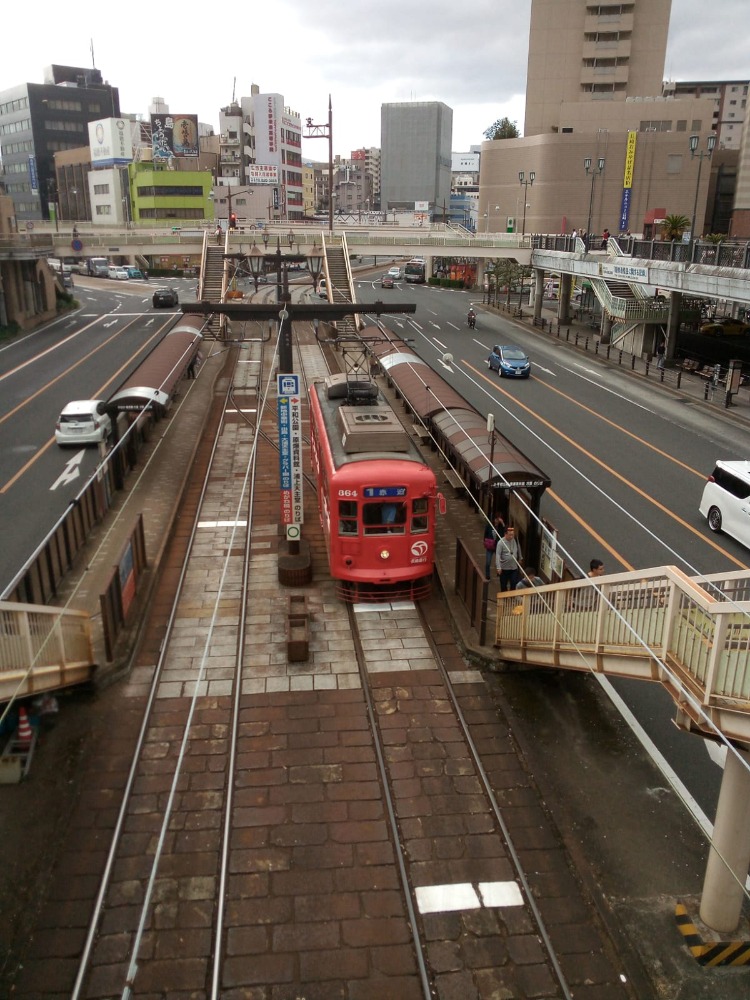


A Nagasaki blue line tram
Unzen mountain resort
Local one-carriage chugalong from Shimbara
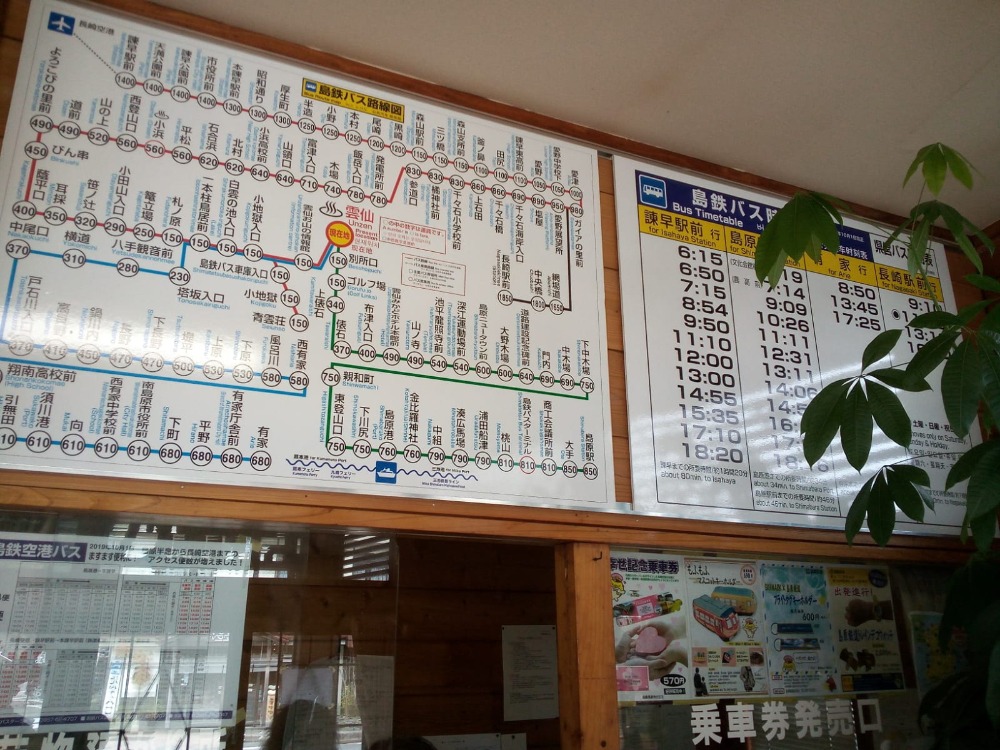

Bus timetable at Unzen
Bullet train bound for Kumamoto
Sunday 13th October: Matchday in Kumamato- Wales vs Uruguay
Woke up around 6ish but the sun had beaten me to it. A stunning, sparkly day with temperatures set to reach 28 degrees later. Decided that some exercise was needed and had seen a couple of rickety old bikes in the hotel entrance that guests could borrow.
Down to reception, unlocked one of the really heavy, rickety bikes then out into the glorious sunshine. Just like all the other cyclists, I stuck to the pavements alongside the main roads and the resorted to the roads where they weren’t so busy, and it felt safe to do so. Not much to describe except a few shrines, paddy fields, other crops and typical suburban houses. The rural smell of the farms was strong and was somewhat refreshing following the many days spent in developed cities.
Back to the hotel, shower, then down to the café area for a Japanese savoury breakfast. There were a few other Welsh fans milling around in the small breakfast area as well as Rachel and Mark from Inside Japan. Got chatting to Mr and Mrs Francis who originate from Port Talbot, but now live just outside London. Mr Francis used to be a rugby referee in his younger days and was certainly very knowledgeable of the sport which became obvious as we chatted about the tournament so far. We discussed our mutual plans for the day and quite by chance we would meet up again at lunchtime.
My aim was to take the Hohi line into Kumamato city centre for some sight-seeing and also to experience the atmosphere in the vast city on match day. Kick off was 17:15 in the afternoon so plenty of time to explore- or so I thought.
Kumamoto mainline station on that glorious Sunday reminded me so much of match days at Euro 2016- Welsh fans wearing red shirts were meandering aimlessly around the city, probably waiting for the bars to open. Other Welsh fans were still arriving in large numbers at the station together with their luggage. So many rugby fans coming from all over Japan! Each with their own itinerary and story to tell- and every one different. The logistics of such an event are mind boggling.
The plan was to board one of the more modern trams than Nagasaki and venture to the castle, this being Kumamoto’s most famous visitor attraction. This plan was scuppered by a 200metre long queue in the sunshine at the tram station. The fallback was to stroll around the city close to the station whilst taking in the matchday atmosphere which by now was noticeably increasing. Found a coffee shop and enjoyed an iced latte chatting with some other fans looking over the main road which had a definite red tinge.
The station for the shuttle buses to the stadium was on the same Hohi commuter line as the Candeo hotel. The shuttle bus stop was 20 minutes from Kumamoto main station whereas as Ozu was 15 minutes further on. Around midday, I returned to the hotel for a blog writing session in the small hotel reception area after firstly changing into the requisite Admiral Wales rugby shirt. On the train back to Ozu, Welsh fans together with their luggage were getting off the train, obviously headed for their overnight accommodation.
Back at the Candeo, a few supporters had already begun drifting out of the hotel headed for the stadium. Met up with Mr & Mrs Francis once again who had also changed into their rugby shirts in readiness for the match. They were intrigued by Parallel.cymru and the diary and became new recruits to Parallel.cymru.
Rachel and Mark were also in the hotel foyer. They had been working all morning rescheduling more than 70 of their clients who had been disrupted by typhoon Hagibis. In total, Inside Japan had arranged itineraries for approaching clients attending RWC2019 from many of the participating nations. With that part of their job completed for the day, they now had to continue their work at Hosi station and the shuttle buses where they would greet as many of their clients as possible. They were both wearing their white and green company outfits so were easy to pick out.
At 2ish, daily blog completed, it was time to head to Kumamoto stadium. A 10 minute walk to the station and then a short ride to Hosi where we meet the thousands of other fans coming the other way on the Hohi line from Kumamoto centre. It was 27 degrees by now so stopped at the nearby 7-11 for a bottle of water and some savoury munchies. These were eaten discreetly as food should not be consumed in public places but the munchies were needed to line the stomach before further pre-match refreshment.
Boarded the train at Ozu with a few other Welsh supporters then got off at Hosi station where we joined the massed hoards arriving from downtown. A red snake slowly made its way down the steps and out of the station. High fives with Mark and Rachel as the snake meandered its orderly way toward the shuttle bus stop. There were a few mini markets on route where some of the crowd broke rank with the snake to purchase cold tinnies. It was hot after all! There was much joviality, swaps of stories and thoughts for today’s match
Tens of shuttle buses waited at the large, open car park and it took no time to board. A Japanese rugby fan sat in the next seat and we talked all the way to the stadium. Hilariously, he showed me a song sheet of the Welsh National Anthem and Calon Lân translated into Japanese. He proudly told me that he was one of the 15,000 Japanese rugby fans that famously attended a Welsh training session a couple of weeks before the tournament started.
Getting off the bus, we were each given a voucher to remind us which queue to join after the match for the shuttle bus to return us to Hosi station. Ours was queue A, with the letters going up to M for each of the other shuttle destinations. This was a huge logistical exercise, similar to that at Oita stadium the previous Wednesday. There was a 20minute walk from the shuttle bus stop through a picturesque park to the stadium. Entertainment was being performed along the route, with dancers, drummers and even a small group of singers. It was very hot, so shelter was sought under trees wherever possible. Signs directed us to the back of the queues for each of the four entrance gates. The queues leading to all four gates were lengthy. We had been warned that that security would be tight, which certainly was the case.
What a coincidence- whilst queuing I was stood immediately behind the lady who I’d sat close to at the Fiji game in Oita. Her husband, the S4C commentator Wyn Gruffydd, needed to be at the stadium four hours before kick-off. The lady had been passing time with Suduko puzzles in the nearby park.
We passed through Gate 2 and then time to say goodbye as her seat was in sector Z with mine in sector C. The first tranche of refreshment booths located immediately after the security gate were beckoning. It was time for the first beer of the day which was enjoyed in glorious sunshine.
There was still 90 minutes to kick-off. I swapped messages with an ex-colleague of mine, Elwyn Jones – no prizes for guessing his nationality. I’d last met Elwyn in Bordeaux who at that time was with his nephew for the Welsh matches at Euro 2016. This time he was with his wife, Sheila. We had been communicating throughout the week and the only time our itineraries coincided was at this match. We agreed to meet up before the match at a mutually convenient location. However, Elwyn and Sheila had firstly been caught up with the crowds travelling from Kumamoto city and were now in a much lengthier queue than mine outside gate 4. The meeting was not to be. Let’s hope Wales qualify for Euro 2020, then perhaps we meet again.
Into the stadium with refreshment in hand. Both teams were going through their pre-match routines. I sat amongst a group of friendly Kiwis who rapidly removed the Welsh flag which had been draped over their seats. Shane Williams was being interviewed immediately in front of us on the perimeter of the pitch. The interview could well have been with S4C as he is well known as a fluent Welsh speaker; I certainly didn’t recognise any ITV interviewers.
Shane then walked to the touch line and briefly spoke with a couple of ex-team mates. He knew the protocol so didn’t encroach onto the field of play.
Time for a bit of name dropping. A couple of years ago I was invited to a Victor Ubogu (VU) sponsored celebrity golf day at a prestigious golf course in Buckinghamshire. I was invited by the same friend who yesterday was confined to his hotel in Tokyo. Shane Williams was playing at the VU golf day and Andy introduced me to Shane, who insisted I sat next door to him for the pre-round breakfast. A photograph hangs proudly on the wall in my study. What a lovely, friendly, family guy; a genuine gentleman which is possibly one of the reasons he gets so many media opportunities.
Kick-off was now thirty minutes away and thankfully the sun was setting behind the stadium and the temperature became much more comfortable. However, the teams were still going through their pre-match warm up which grew in intensity as kick off approached.
Time for the anthems. The Japanese pulled out their song sheets and made an excellent effort to join in with the Welsh National Anthem.
The game itself was a poor spectacle, although the Kiwis were good entertainment, and cheering every attacking move from both teams. On this performance they don’t fear playing Wales even though we appear as number 2 in world rankings. Wales ended up winning quite comfortably and have made it through to play France in the quarter finals.
Many of the fans were leaving the stadium with ten minutes of the match remaining, their aim to watch the Japan versus Scotland match scheduled to start in less than an hour following the conclusion of the Wales Uruguay game. The issue of match scheduling was discussed with Mark and Rachel who stated that the tournament organisers had not allowed enough time between matches that are played on the same day. Official RWC2019 Fanzones have been set up in all cities hosting matches. However there is not enough time between matches for fans to get to the Fanzones and watch a second match if they have attended the first match.
Still inside the stadium and sensing the queues at the shuttle bus park were going to be lengthy, I stayed behind listening to the post-match interviews and subsequently watching the players seek out their families in the rapidly-diminishing crowd.
I sauntered back to queue A at the shuttle bus stop hoping it would have evaporated by now. No such luck and I joined the rear of a huge winding queue which took just over an hour to board the bus. No worries, as there was lots of entertainment in the queue. I was amongst a group of Welsh speakers who were joyously singing songs I recalled from school days, including a full rendition of Max Boyce’s Hymns and Arias- every verse. Also chatting to a lady, much the worse for wear, who knew my home village of Caerau. Apparently her mother still lives in Carmen Street where my twin brother used to deliver newspapers as a teenager.
The most entertainment was provided by the locals who were streaming the Japan versus Scotland matches live on electronic devices of varying sizes. Technology is amazing. Scotland took the lead and there were loud boos in the queue. Then the impossible happened and Japan, who were playing superbly well, scored a succession of tries. Everyone in the queue who wasn’t singing gathered around one of the many mobile electronic devices to watch the miracle that was unfolding. There were rhythmic chants of “Nippon” (Japan in Japanese). It was halftime as we boarded our bus and then a 15minute walk through the moonlit night to Hosi station and the short train ride to Ozu.
The platform for the trains heading downtown was crowded, the platform for Ozu not so. Another coincidence- on the platform waiting for the Ozu train, I met up once again with the Francis family from Port Talbot who were also staying at the Candeo hotel. On the train, I told them of my intention of visiting the steak house where the previous evening I had enjoyed a couple of beers and intended to do the same tonight. I’d noticed a TV screen in the steak house and hoped that they might be playing the end of the Japan versus Scotland match which by now was getting exciting as Scotland were pegging Japan and could overhaul them for a quarter final. Much was at stake.
Mr and Mrs Francis followed me into the steak house where indeed they were playing the Japan versus Scotland match. Mark and Rachel from Inside Japan were also in the bar with a couple of other clients also staying at the Candeo. It was an enjoyable end to a memorable day and Japan held on to qualify ahead of Scotland for the quarter finals.
There was time to stop off at 7-11 and pick up a late night snack to munch in the hotel room before tooth medication, messages then night nights.
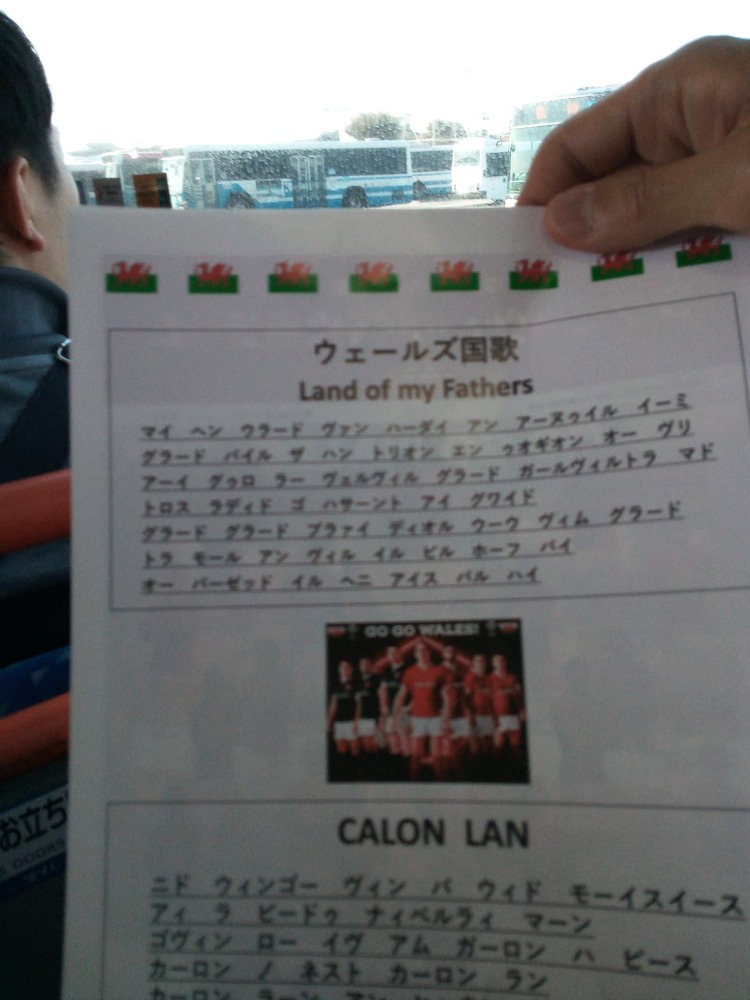
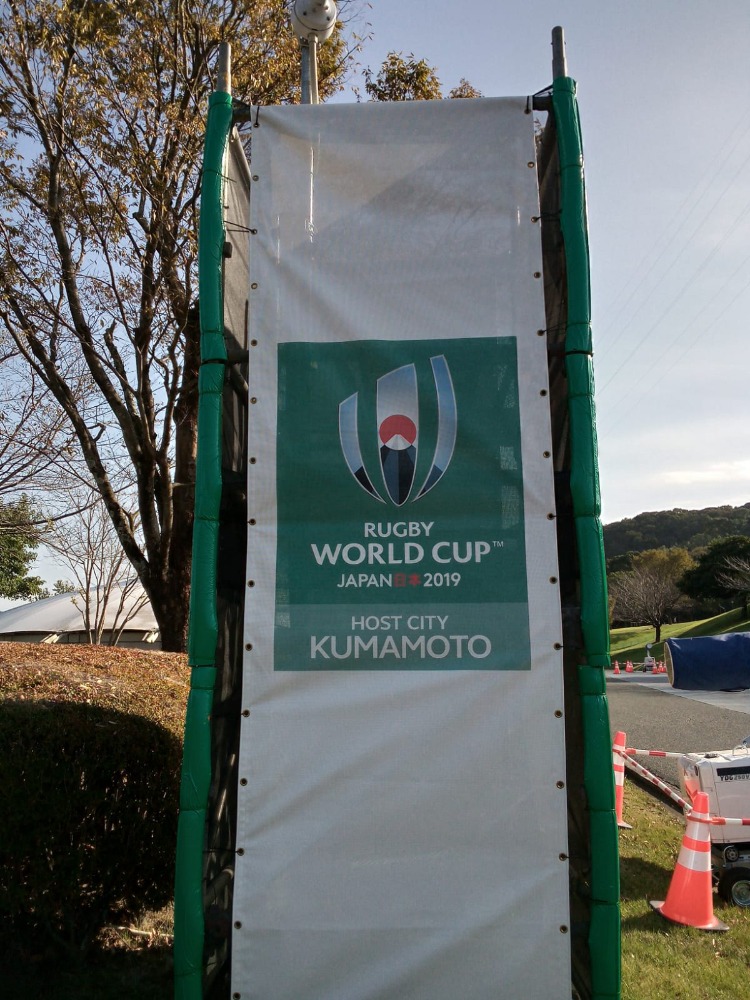
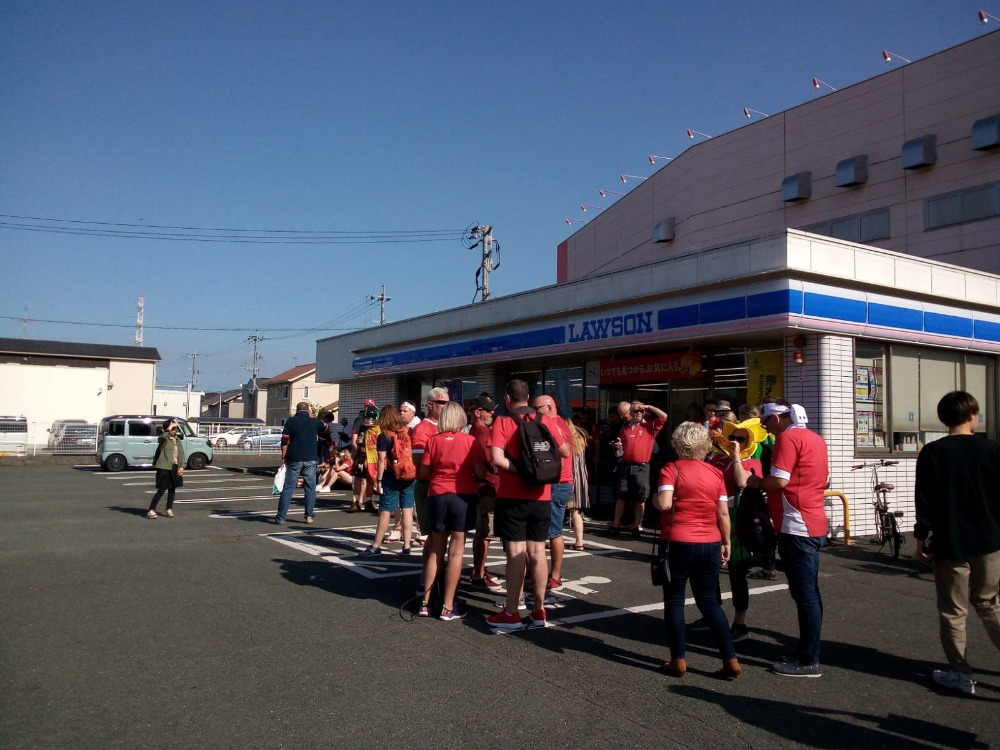
Song sheets such the locals could join in the singing
The walk from shuttle bus to stadium
Welsh fans purchasing liquid refreshment
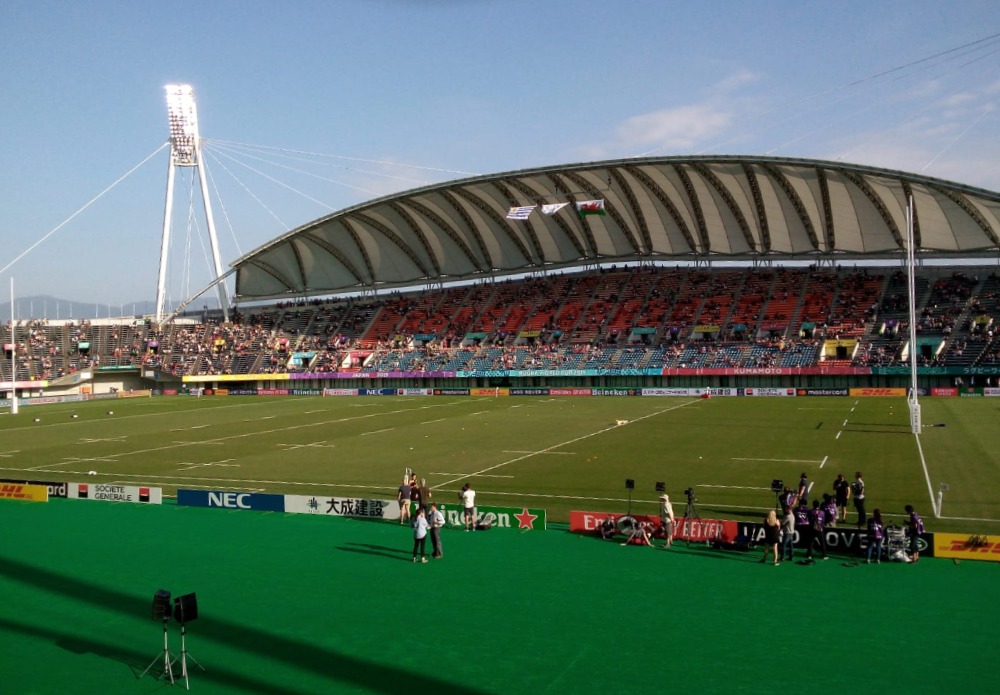
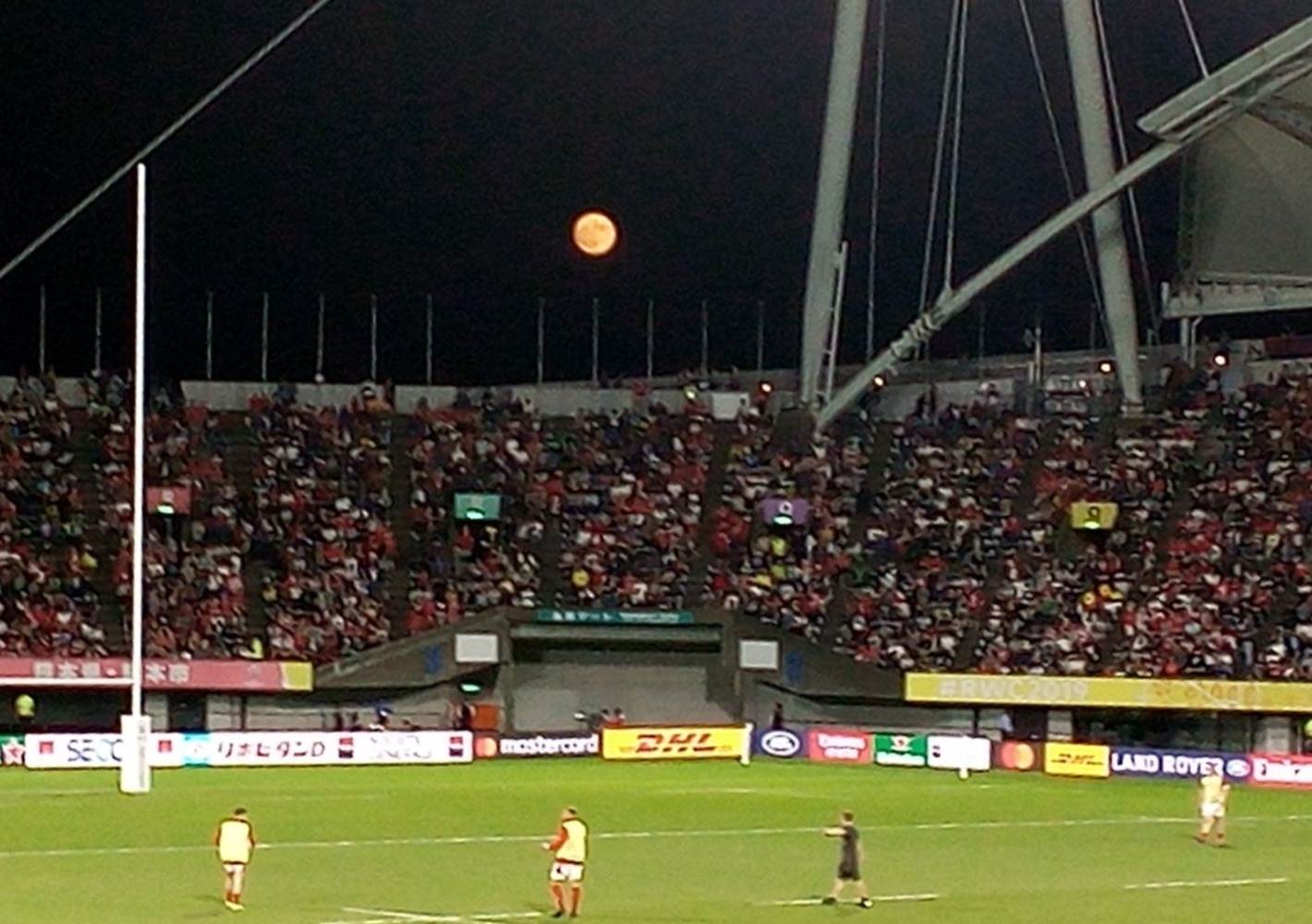
Kumamoto stadium in glorious sunshine
Moon rising over stadium in second half
Monday 14th October: The long journey home
The alarm was set the previous night for 06:30, but I awoke at 05:00 out of a deep sleep following the previous day’s excitement. Remembering that Wales were playing Croatia in a EURO2020 qualifier which kicked off at 0345 local time, I turned on the mobile phone and followed the game on BBC Sport. The match ended in a 1-1 draw at 05:45. It wasn’t worth attempting more sleep so got up, shower and then pack the holdall ready for the 800mile journey to Tokyo for the last night sleep in Japan.
Consumed a small breakfast and strong coffee with a surprising number of Japanese folk in the hotel café at this early hour. Unsurprisingly, there were no Welsh fans at breakfast yet- probably jaded following their previous day antics in the hot sunshine.
The sun was shining once again although the temperature was cool as I walked one last time to Higo Ozu station and the 07:44 commuter train heading for Kumamoto. A number of schoolchildren joined the train at different stops along the route, but no Welsh rugby fans.
Kumamoto main station was busy in the middle of rush hour but nowhere near as manic as Tokyo. I headed for the Shinkansen bullet platform to board the 08:50 headed for Shin Kobe. Shinkansen is the main rail franchise between Tokyo and the islands to the south of Japan. In some of the larger stations, the Shinkansen franchise have their own platforms, such is their dominance in these parts. The first stop on this Shinkansen bullet was Fukuoka where I’d stayed the previous week, but it felt a lot longer than just a few days ago, then a change of bullets at Shin Kobe heading to Tokyo.
A big element of Japanese culture is their politeness, in particular bowing, either as a gesture of hello or thank you. Every time a ticket collector or other member of the train’s staff entered a carriage, they would stop at the door and politely bow. The same action was repeated when they left the carriage. On each carriage outside the seating area was a clean toilet and also cubicles for making telephone calls which were not allowed in the passenger seating areas. There were also the mandatory recycling bins.
At each station along the route, rugby fans of different nationalities were either boarding or disembarking as they were continuing with their own unique itinerary. There were a few Welsh fans, who similar to myself were taking the 6.5 hour journey to Tokyo. Swapped messages with my ex-colleague Elwyn who was heading for his last night in Osaka before flying back to UK on Tuesday night.
Whilst sat in the comfortable reserved seat on the Shinkansen bullet, I contemplated with some disdain my last night of this epic adventure back at the student type accommodation of the Ibis hotel in the manic Tokyo district of Shinjuku. Using the efficient bullet train wi-fi, I searched and treated myself to a different and more luxurious hotel in a less manic district of Tokyo. My nieces would be amazed that their technophobe uncle was capable of booking a hotel room in Japan whilst on a train journey! There were excellent offers available for last minute bookings and so made a heavily discounted reservation at the Park Royal Hotel in Nihonbashi.
It was raining as the bullet headed north through Japan for on time arrival at 15:50 in Tokyo main station. I looked for any obvious damage caused by typhoon Hagibis. None was to be seen and the authorities had been super-efficient in their clean-up operation.
The Royal Park Hotel was located in the Nihonbashi district of Tokyo which was 2km from Tokyo station. It was raining and there was no easy metro route to Nihonbashi without at least three stops, so I boarded a taxi for the 10minute ride.
The entrance to the Royal Park Hotel was enormous and very grand with large chandeliers, marble floors and sweeping staircase. The double room was spacious had even had a wardrobe- the first of the journey. I joyously unpacked the holdall and took great pride in hanging my clothes. There was a wrinkle free spray which I used with great enthusiasm!. There is more- the channels on the in-room TV included BBC News and there was a mini bar.
Having made a cup of coffee whilst catching up with the latest news and getting my bearings with the various district guides, it was time to head out and seek dinner. The hotel was fantastic but so were it’ prices for food and beverage. In fact I couldn’t believe the style and quality of the hotel for the price charged, which was 25% of the tariff quoted at the lengthy reception counter.
It was raining, so borrowed an umbrella from the concierge. There certainly was not a bell boy at any of the other hotels on this trip. Out into the Tokyo night and some exploring.
Nihonbashi is close to the banking district and Tokyo stock exchange, and the contrast in atmosphere to the zoo-like Shinjuku was immediately obvious- this area was calm and much more professional. Commuters didn’t seem to be as rushed and there was more space at ground level, even though surrounded by modern high rise offices and apartment blocks.
Decided on a small bar for a couple of beers before moving to an unusual boutique grill for dinner. The seating in Japanese restaurants differs from the West- they seat on benches with a perch in front of them for their bowls of food, whereas in Europe we sit around tables. Sat at my perch, the chef prepared a dish of three types of grilled meat, but as with their fish, the meat is not cooked to the same extent as we would. I wasn’t brave enough to try one of their speciality cocktails – tomato juice and beer! Why?
Back out into the rainy Tokyo night, it was close to 10pm so time to head back to the luxurious Royal Park Hotel and an enormous bed which wouldn’t have fitted into the rooms at the Ibis, Richmond or Candeo hotels.
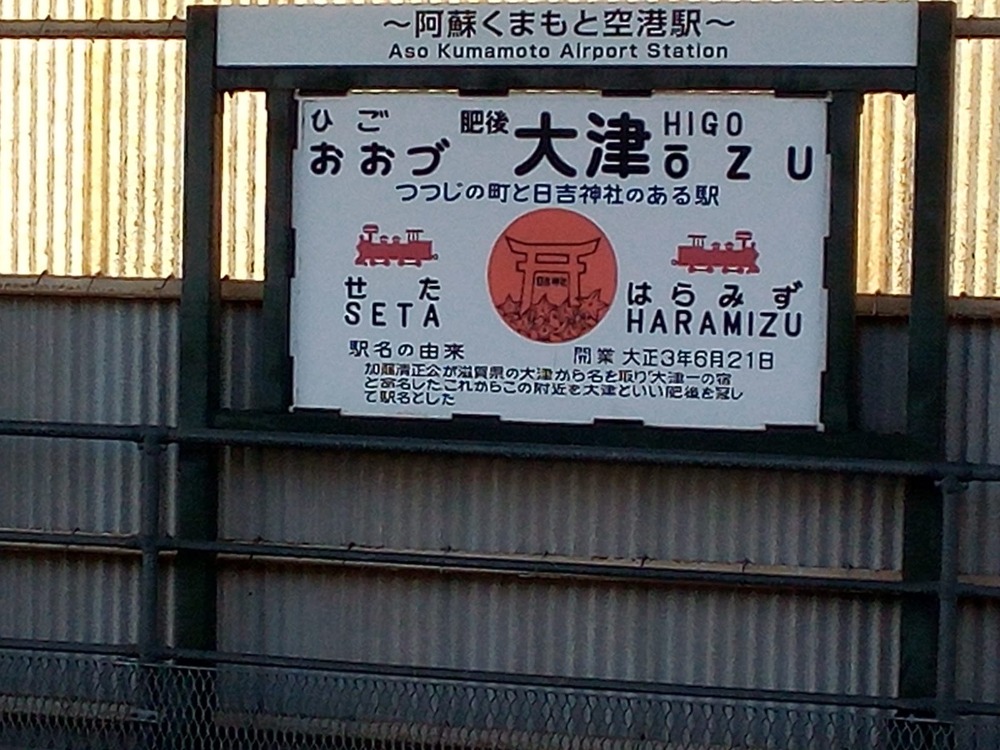
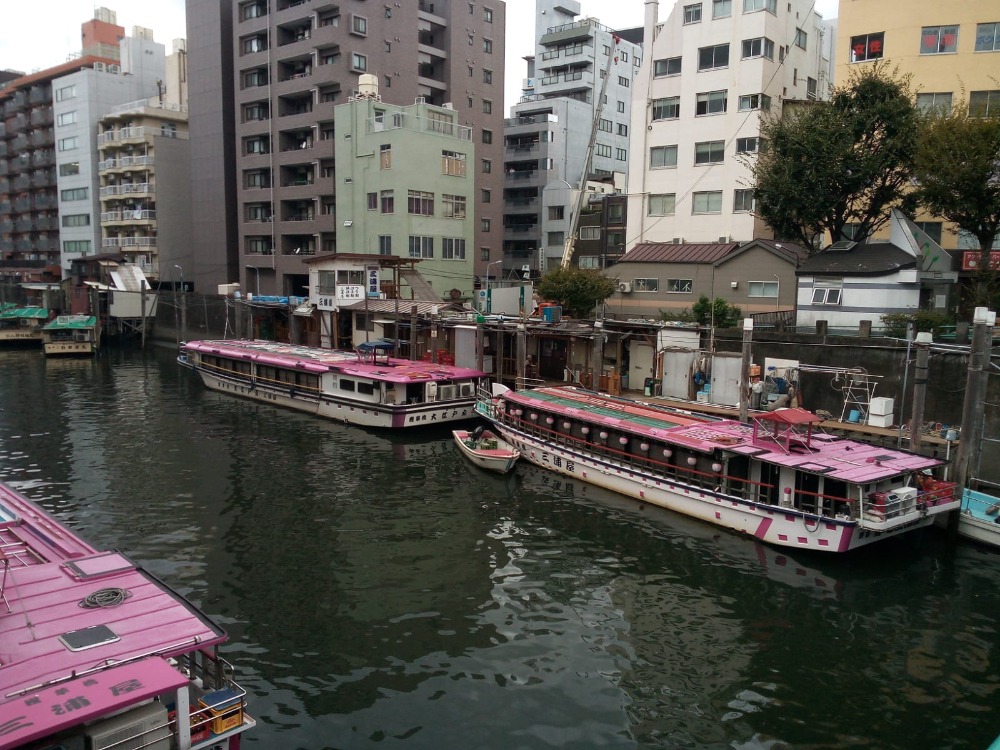

Hugo Ozu station- Homeward bound
Tourist boats on a Tokyo River
View from Tokyo hotel room
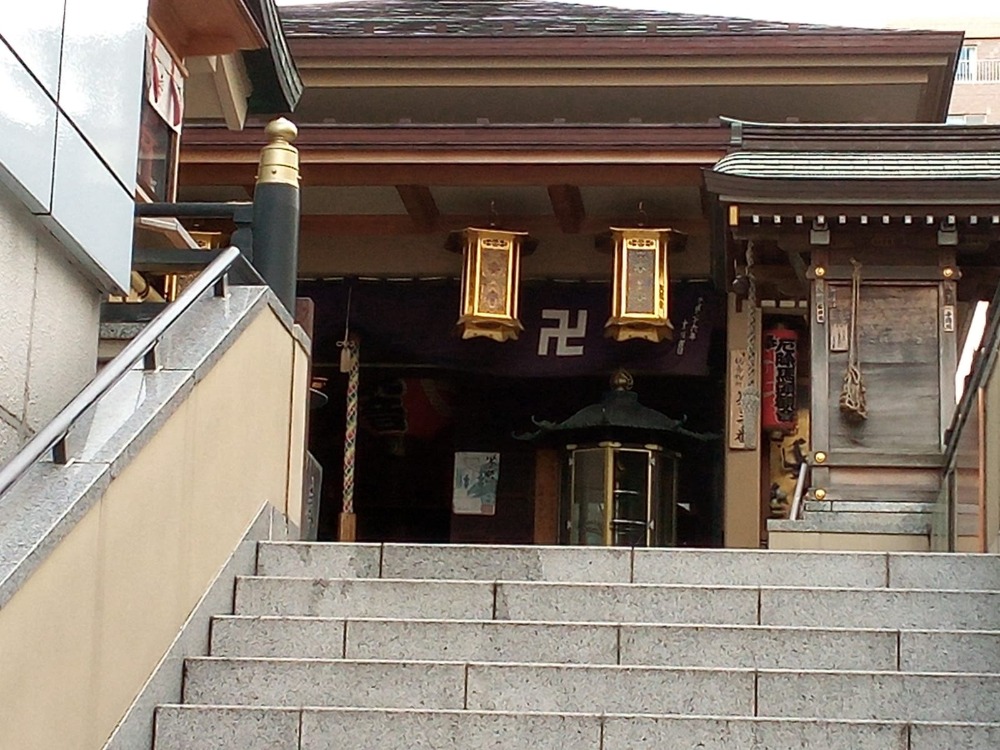

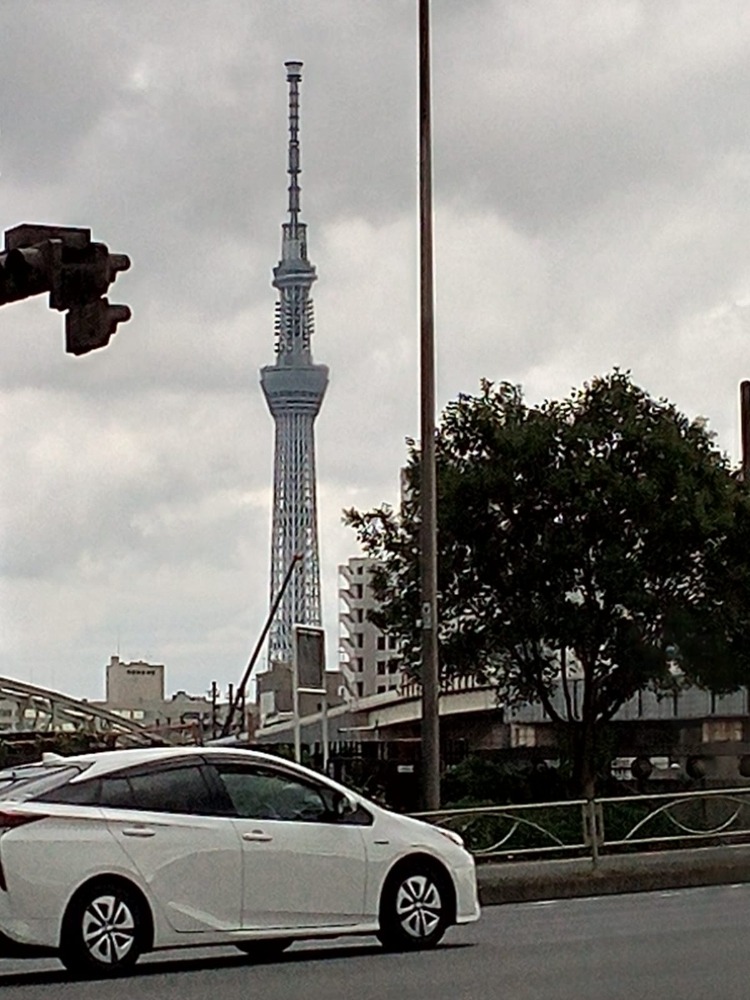
Tokyo restaurant
One of many advertising boards in Tokyo
Sky Tower

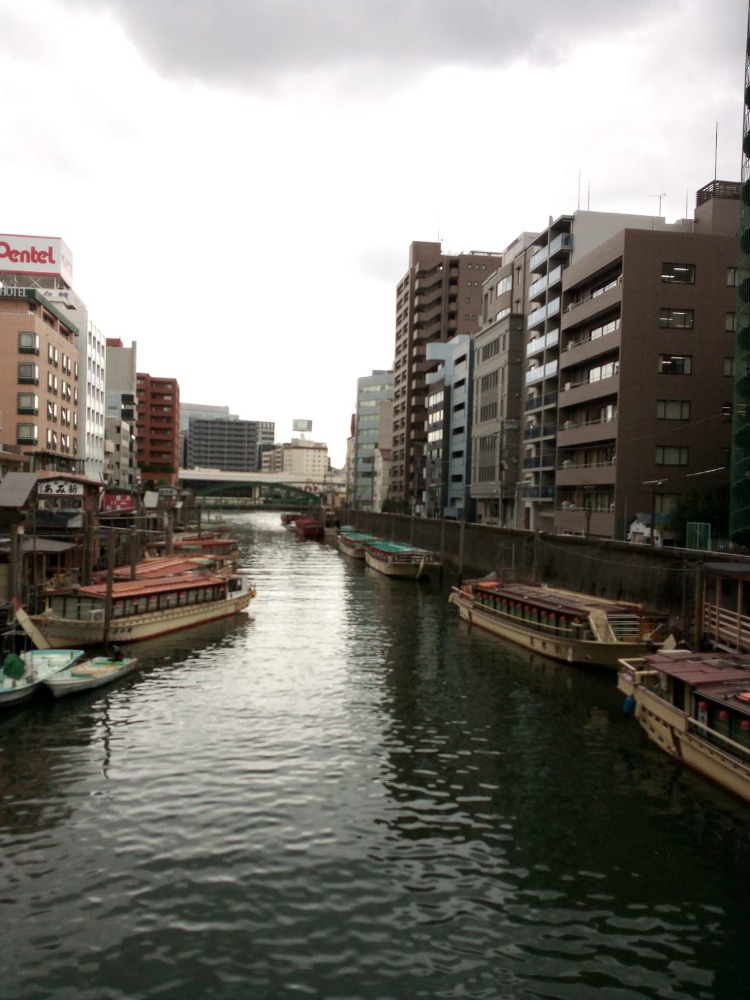
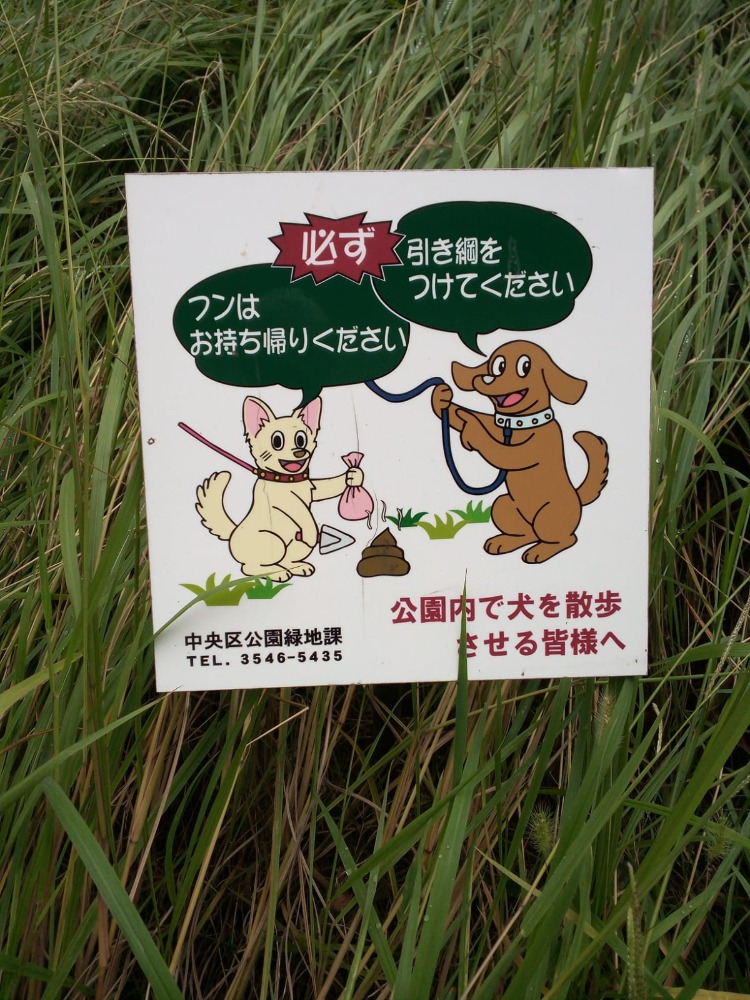
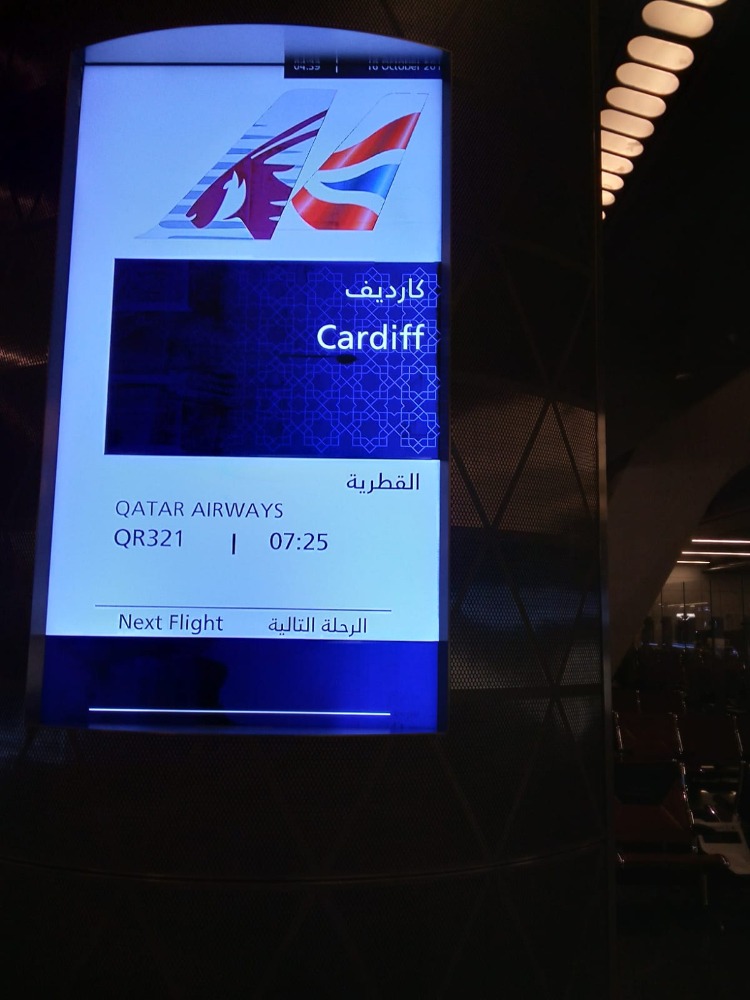
Tomato juice and beer
Downtown Tokyo
No translation needed
Departure board at Doha airport- How to spell Cardiff in Arabic
Tuesday 15th October: More sightseeing then the flight home
Although the last minute rate at the Royal Park Hotel was excellent it didn’t include breakfast. Enjoyed a lie-in whilst reviewing tour guides and devising a plan for the day. Made an in-room coffee before heading out into the grey but dry Tokyo day with a couple of destinations in mind. The guides supplied by Inside Japan were excellent and included suggestions of places to visit at each of the destinations. The morning aim was a walk and metro journey to the Tokyo Sky Tower in one of the more established districts of Tokyo. The traffic on the road and pavement was busy but not manic and consequently I walked all the way to the Tokyo Sky Tower rather than using the metro system.
An aspect of the last 10 days which was difficult to comprehend was the independent decision making. Most previous holidays have either been with my partner/wife or group holidays such as cycling, golf or skiing. However, with this adventure, I would make a plan the previous evening or maybe whilst lying in bed and if the following morning didn’t feel like following through that plan it didn’t matter as there was nobody else involved. The total independence with no responsibility to or for others felt alien.
Tokyo was originally a port town, but as the capital of Japan, really developed in the 1980s and 90s in parallel with the tech boom which catapulted Japan forward. There are many remnants of the old Tokyo particularly along the river system in the east of Tokyo. These old remnants are being replaced at varying speeds with tall and ultra-modern office blocks. This contrast was evident on the hour walk to Tokyo Sky Tower.
I needed to get back to the hotel for check-out at 12:30- no extension was allowed with the rate that I paid. Took a different route back along one of the main rivers in Tokyo. The water level was particularly high following the torrential downpour of Hagibis two days ago. I was hungry so had a late breakfast with a lovely cup of tea at a small but busy café.
Back to the hotel, packed the holdall for storage by the bell boy and checked out. Decided to treat myself to a tea in the hotel coffee shop and catch up with emails, blogs etc. It is the only time in my life I have spent £13 on a cup of tea. The only saving grace was the price included endless refills. I stayed at the coffee shop for 90 minutes enjoying the atmosphere and watching the locals enjoying their very traditional British afternoon tea with little cakes, scones and sandwiches.
The afternoon excursion was a metro journey to Tokyo’s equivalent of Harrods, recommended by the Inside Japan itinerary. The store was to be found in the centre of Tokyo’s business district. The ultra-modern high rise office buildings were breath taking as was the more traditional architecture of “Harrods”. I walked through the district in awe. So much so that instead of taking the Metro back to the hotel, I walked around the business district and using my Tokyo visitor map, devised a detour back to the hotel.
Time to retrieve my holdall, change into travel clothes and ask the bell-boy the easiest way to get to Tokyo central station to take the Narita express train to Tokyo’s second and smaller airport at Narita.
Included with the Inside Japan itinerary were tickets for all aspects of the adventure. These included hotel vouchers, the 10 day green railcard, bus trips, ferry crossing and the IC card for the Tokyo subway system. The package also included a ticket for this last leg of the journey, the Narita express train.
One of the hotel’s information staff overheard my conversation with the bell-boy and suggested that rather than taking a taxi to Tokyo main station in the middle of rush hour and then the stress of finding the Narita platform amongst the hordes of commuters, I should take the Narita airport transfer bus. The bus terminal was adjacent to the Royal Park Hotel and the journey would be shorter, less stressful and cheaper than the Narita express train. The hotel information guy was Italian and had moved to Japan more than 16 years ago. He said the culture in Japan was so much more to his liking than anywhere in Europe. He walked with my holdall the short distance to the Narita bus terminal where I boarded the efficient and modern coach to Narita airport. The hostess on the coach, stood up, bowed in true Japanese tradition and then requested we put on our seat belts and refrain from using mobile telephones and eating on the 1hour journey.
At the airport, it was announced that the Qatar Airways flight to Doha would leave 20 minutes early. On-board I watched the last episode of Chernobyl before luckily falling asleep.
There was a two-hour stopover in Doha before the very last hop of this amazing adventure on a BA flight to London Heathrow. The BA 787 cabin was such a disappointment following the relative luxury of Qatar Airways; the catering and inflight entertainment likewise were far inferior to that of Qatar airways. Every Qatar flight was full, but the BA aircraft was probably 20% of capacity- something wrong somewhere with BA business strategy.
The 10 day adventure was fantastic and thanks again to nephew Neil for inviting me to compile the daily diaries and to share the experiences of the last 10 days with the readers of Parallel.cymru. I have learnt so much during this journey. The politeness and discipline of Japanese culture; their determination to preserve their island as best they can in a consumer driven climate. Everyone seems focussed on their role in Japanese society- whether it be cleaning, efficient public transport, manufacturing, agriculture or public services. There is discipline, focus and efficiency with a common direction and understanding. I am proud to be Welsh and British, but my eyes have been opened by a wonderful culture elsewhere.
And as for RWC2019, if there is ever an opportunity to attend a global sporting event, then it is strongly recommended. The atmosphere, national pride and just being with people with common interests is simply amazing.
Warning: Parameter 2 to qtranxf_postsFilter() expected to be a reference, value given in /home/parallel/public_html/wp-includes/class-wp-hook.php on line 324
Warning: Parameter 2 to qtranxf_postsFilter() expected to be a reference, value given in /home/parallel/public_html/wp-includes/class-wp-hook.php on line 324
Warning: Parameter 2 to qtranxf_postsFilter() expected to be a reference, value given in /home/parallel/public_html/wp-includes/class-wp-hook.php on line 324
Warning: Parameter 2 to qtranxf_postsFilter() expected to be a reference, value given in /home/parallel/public_html/wp-includes/class-wp-hook.php on line 324
Warning: Parameter 2 to qtranxf_postsFilter() expected to be a reference, value given in /home/parallel/public_html/wp-includes/class-wp-hook.php on line 324
Warning: Parameter 2 to qtranxf_postsFilter() expected to be a reference, value given in /home/parallel/public_html/wp-includes/class-wp-hook.php on line 324
Gisella has been learning Welsh with Say Something In Welsh for a short period all the way in Turin, and after being captivated by our language and Welsh rock bands she decided to take a trip here and see what Cymru really looks like. Here she shares with the world her experiences, thoughts and photos on our country and music...
On a summer day with not much to do, I decided to give a try to one SaySomethingInWelsh.com lesson. Fast forward to six months later, I’m wandering around Wales and realise that…I’m actually able to communicate with people in Welsh. How could this happen? The first time I came to the UK, I had studied English for seven years at school, but could understand or say almost nothing.
Besides that, nobody was surprised to see students from all over the world coming to learn their language. In Wales, they are! And it’s great to see people’s reaction when I say I’m from Italy and ask:
“Is it ok if I try to speak Welsh with you?”
[astonished face #1, like “Oh wow, an Italian learning our language? Really?”]
“Sure, it’s fine! Do you live here?”
“No, no. It’s just I liked the way it sounds and the songs of a band called Datblygu, so I decided to learn it”
[astonished face #2, like “You must be a little crazy, but that’s ok anyway”]
At this point, I…well…have to say something in Welsh, right? Amazingly enough, they usually understand me. And they answer saying something that I usually pretty much understand, too.
“Da iawn! How long have you been learning?”
“Six months.”
[astonished face #3, like “Months? How come my cousin has been studying it for years, but hasn’t even tried to speak Welsh outside the classroom once?”]
People often thank me as if it were some kind of favour or even sacrifice I’m doing. But the truth is I’m just enoying myself! Hard to believe? Let’s see if my tour diary from February 2019 can prove it.
- Day 1: Abertawe
- Day 2: Aberteifi & Caerfyrddin
- Day 3: The Clonc-edigion, Tregaron & Aberystwyth
- Day 4: Developing a Music Project
- Day 5: Voices of Welsh Language
- Day 6, Epilogue: A final exam (sort of)
Day 1: Abertawe
At Swansea Bus Station
Just hopped off the coach from Stansted Airport, I walk in to ask for information. I wonder if the guy speaks Welsh. Maybe, maybe not. I think “Well I’ve just arrived. I’m too tired. I need to be sure I understand what he says. I’ll use English, this time. Just this time.”
I ask where I can catch the bus to Carmarthen. He doesn’t understand Carmarthen. I try to pronounce it in a few different ways, until he goes “Ooh, Carmarthen! Yes, in 15 minutes, at Stop X”. I wait at the stop for a while, then ask the driver, to be sure. Turns out that’s a local line, I should go to Stop S instead.
Luckily, the right bus is still there. Now I got a bit too anxious to remember to speak Welsh. I ask for a ticket to Carmarthen; he asks “Carmarthen?” (I suppose, again, with a subtle difference in pronunciation that I cannot perceive). I get my ticket and off we go.
I should really memorise Caerfyrddin, though: names in Welsh seem very complicated when you first see them. But once you figure out the alphabet, it’s easy because there’s only one way to pronounce each letter or combination of letters - like Italian and unlike English!
Anyway, since I crossed the England-Wales border, all the road signs are blilingual. Occasionally, on shops and houses, even in Welsh-only. So I can entertain myself reading them and learning something.
“Safle bysiau”
“Edrychwch i’r chwith”
“Dim baeddu”
“Anaddas i gerbyd hir”
“Mae ysmygu yn y fangre hon yn erbyn y gyfraith”
“Mynedfa”
The latter in particular seems very common and related to a lot of incredibly different activities. Until…uhm…got it now, it’s because it means “Entrance”. D’oh!
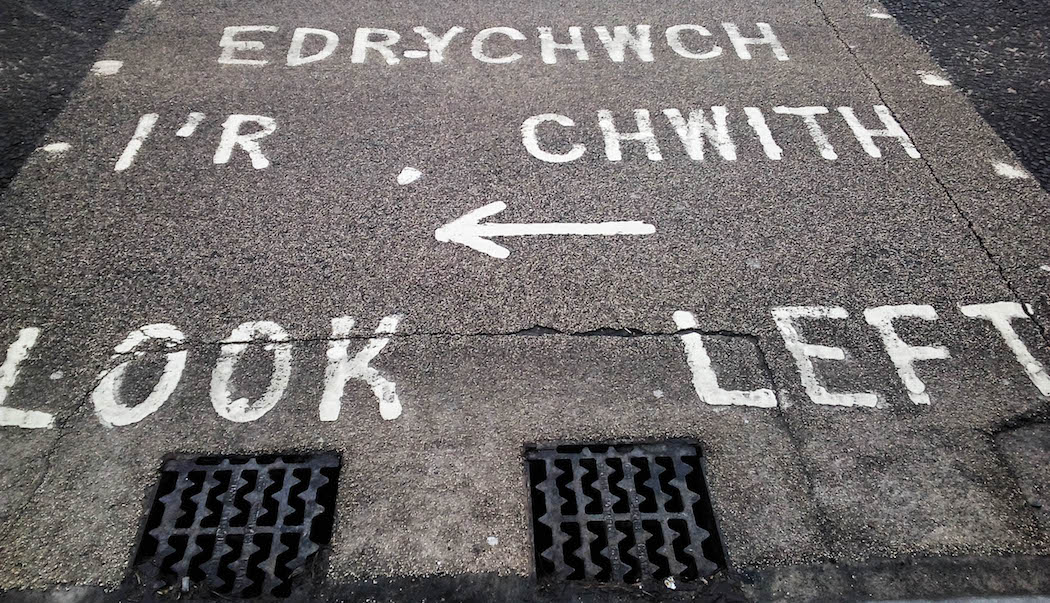
Carmarthen and The Warren
On the bus, nobody is chatting in Welsh. I reach Carmarthen… naaa, Caerfyrddin, Caerfyrddin!...and I have time for a coffee before getting on the bus to Pencader. I remember hearing on S4C the story of a cafe-restaurant that had launched a successful crowdfunding campaign and opened over here. It seemed really neat, guaranteed Welsh-speaking, and close enough, so I head for The Warren.
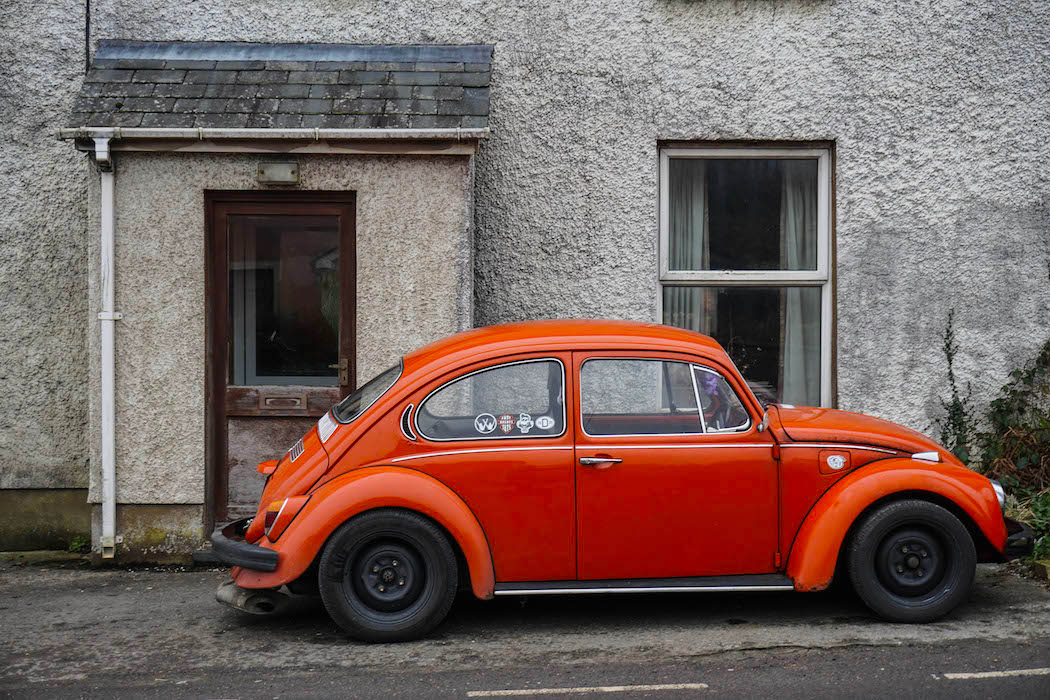 Car y Pobl (Volkswagen) ym Mhencader
Car y Pobl (Volkswagen) ym Mhencader
When it’s time to order…oh, damn…I chicken out again and speak English. Right before going out, at least, I ask if they all speak Welsh: yes, although two of them self-declare as still learning and point at the third as the only fluent speaker. Now, I’d love to say I’m a learner myself and stop for a chat, but unfortunately now it’s too late: I just can’t miss the bus. Well, next time. Loved the coffee and the scone, though!
Reaching Llandysul
On the bus, still nobody chatting in Welsh. At the next stop, a guy wearing a fleece jacket completely covered in cat hair - just like my grandma used to have! - sits next to me and starts talking about the weather. We’re in Britain after all, aren’t we? I don’t understand his question in English and say “Sorry?”. He asks me if I’m Polish (?). I reach Pencader, get off the bus, have a short walk, catch Bwcabus to Llandysul. Reminder: local buses accept cash only; go to the ATM machine first and/or make sure to have pounds and not euros in the wallet, to avoid complications and/or embarrassment.
Dee and Cymraeg
At the bus station I finally meet Dee in person. I had started planning this trip in August, soon after starting SSiW, and had asked for tips on the Forum. One of the first to answer was Dee, who grew up New Zealand, worked in Australia, then moved to Wales. Now she runs Nyth y Kiwi Airbnb, is part of SaySomethinginWelsh staff and is my host for the next few days. It has started snowing a little, but I’m really glad to walk a bit after sitting in planes, coaches and buses for so long. She already knows that the main purpose of my trip is practicing Welsh. So, no more excuses, from now on the official language is going to be Cymraeg. I have to admit that the image of an Italian and a Kiwi chatting in Welsh while walking in the snow in a small town in Wales seems slightly bizarre. But who cares? For the rest of the evening I’ll do my best to communicate, putting together sentences with my limited vocabulary and asking Dee (so patient, poor her!) for the missing words. I’m exhausted and happy to fall asleep in such a cozy and quiet home. Very busy schedule ahead, tomorrow.
I have to admit that the image of an Italian and a Kiwi chatting in Welsh while walking in the snow in a small town in Wales seems slightly bizarre...
Day 2: Aberteifi & Caerfyrddin
Going to Aberteifi
Yesterday we were a bit worried about the weather forecast: snow and ice everywhere, at least for a couple more days. Luckily, this morning, it’s not too bad. Dee and I, with her made-in-Italy car, reach Aberteifi alright.
I’m still a bit confused about so many aber, llan and caer all over the place in Wales. But calling a town like a garment sounds strange and I decided to ban Cardigan, with all the Earls and Marquesses who come along with it: Aberteifi’s the only name I’m going to use. Period.
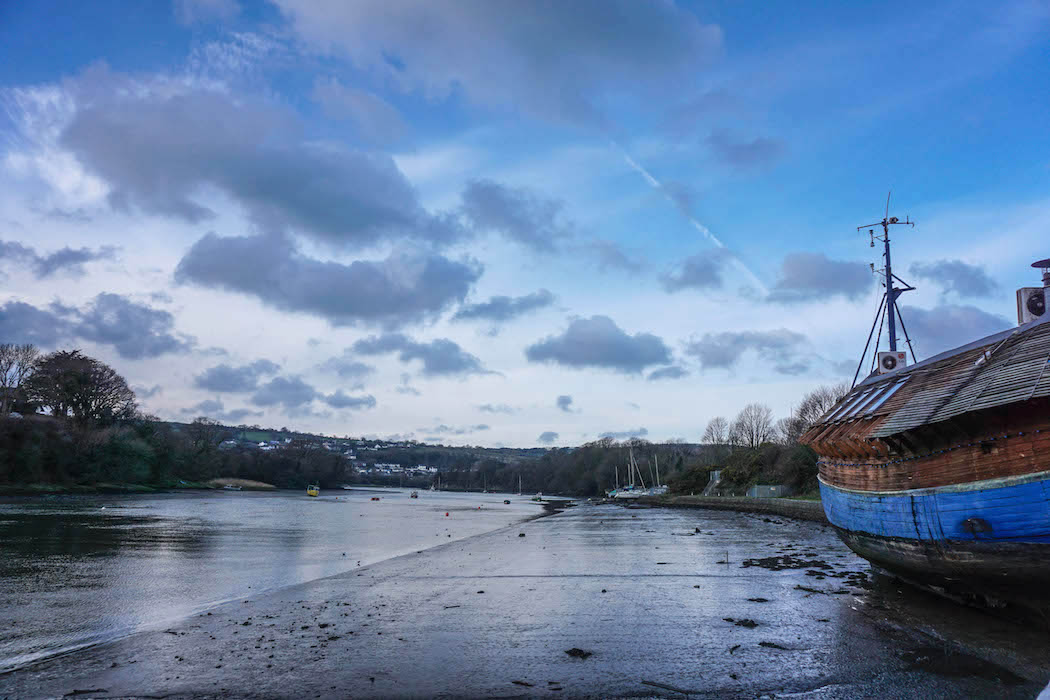 Aberteifi
Aberteifi
Gorffwysfa’r Pysgotwyr - Grŵp Sgwrs
We came here for the weekly conversation group, found on Pethe Clych Teifi. I’ve never been to a Welsh language learners meet-up before. Actually, I‘ve never been to any language learners meet-up before, also because my mind always imagined it as something between a school lesson and an Alchoholic Anonymous group. Not too appealing, I would say.
But I’m here to learn, and I’m going to try and see how it goes. Hey, the location looks nice! I’m even more inspired to start, and I’m also glad that Dee came with me so it’s not a complete jump into the unknown. But I’m a still bit nervous. We’re a few minutes early and there’s a freezing cold wind outside; we walk in the Fisherman’s Rest, we are welcomed by one of the participants and wait for the others to arrive.
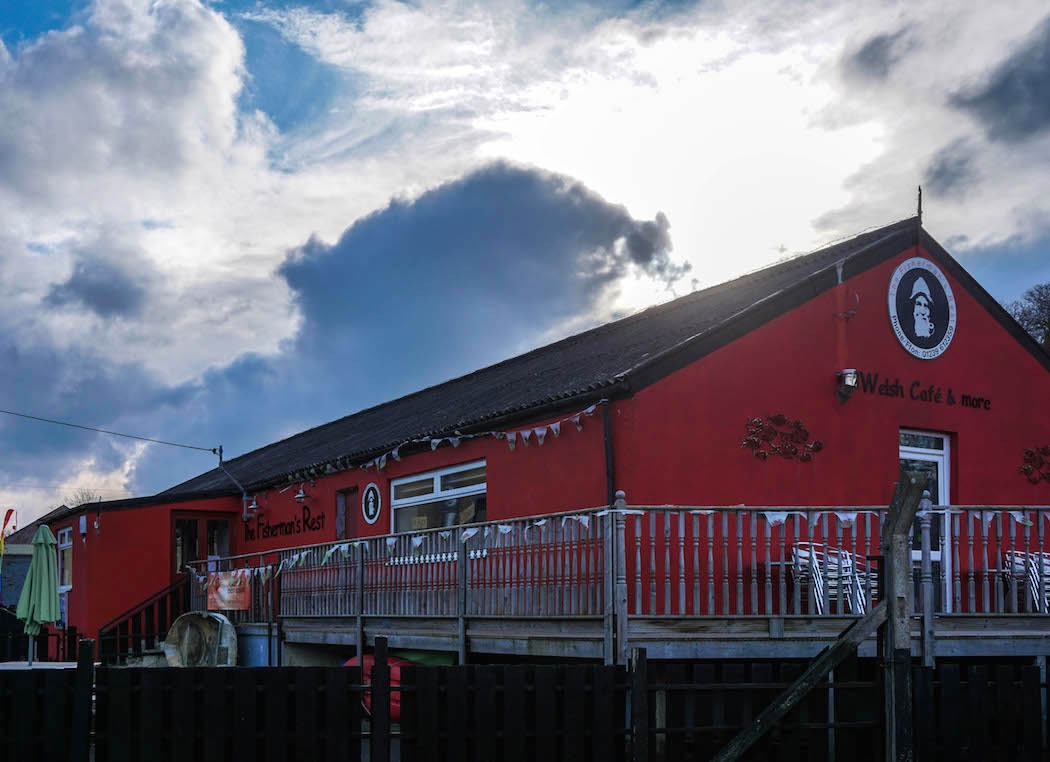 The Fisherman's Rest
The Fisherman's Rest
It’s way simpler and more informal than I thought: fluent speakers and learners sit at a table together; you introduce yourself to those sitting next to you, like at a dinner; you talk or just listen, as you prefer; you can go get a cup of coffee or tea if you feel like, then come back and chat some more. No pressure to do or not to do anything. The few times I had tried to speak outside in the wild, I tended to just say I’m from Italy, then dish out two or three classics from SaySomethinginWelsh early lessons - like Dw wedi bod yn dysgu Cymraeg am bump mis or Mae dal eisiau i fi ymarfer. Then shut up, hope to understand what they’d tell me and soon switch back to English.
In the group, the atmosphere is relaxed and friendly, it feels safe to try and have a conversation: I soon find myself saying things that are way too complicated for my level. It’s amazing to see everybody’s sincere effort to make sense of my garbled sentences, without even a hint of annoyance. So sweet, I’m really grateful, everyone!
Here’s a few of the things I learnt today:
- The totally Italian-sounding bolgi for glutton (from Howard’s vocabulary of the day)
- The hilarious Wyt ti’n Rigoletto? So I will always remember how to ask if someone’s fluent
- The curious and timely Mae’n ddigon oer i sythu brain
Dee has to leave to get work done I’m staying for lunch and to have a look around. Before saying goodbye, I get plenty of tips: I discover where to find a fellow SSiWer* who’d be happy to practice or someone with an Italian mom to speak Italian; where to see interesting gigs and events if I come back later in the week (The Cellar, by the way); and of course, how to go back to Caerfyrddin. Vanya even walks with me to the bus stop. What can I say, I’m all set!
Around Aberteifi
I had planned to look for records and maybe books, but I don’t feel like dragging stuff around all day.
I had planned to go around and try to speak and listen more because the local accent is the first I heard, it’s in my favourite songs, and my favourite singer’s accent - therefore also my favourite accent! In a roundabout way, this town is responsible for me starting to learn Welsh. Should I hate it or love it for this? Well, it’s a nice day, I feel good, I’m enjoying myself and I wouldn’t be here if it wasn’t for Welsh language. So alright then: thanks, Aberteifi!
But now my brain is tired and I’m hungry. Someone suggested Crwst. Very nice place. It’s also a bakery, and bread looks great. There’s a long queue behind me, so it doesn’t seem the right moment to order in Welsh - even though, I don’t remember why, I find myself saying I’m from Italy and learning it. The girl at the counter looks very surprised and happy to hear that. I eat rarebit and buy a tin of bara lawr - unfortunately later confiscated by Stansted officers, as a potentially dangerous item. Annoying but also pretty funny: “Airport security threats: the laverbread”. “The attack of the killer Bara Lawr”. Oh sorry, what was I saying? Right, the Crwst. I get out and have a short walk around. What else? The Welsh-Italian won’t be at the bar/club until later and the fellow SSiWer seems to feel a bit rusty and not quite in the mood for practicing Welsh - it happens, I know, I know - but I have a fun chat with two other people sitting there. Until it’s time to go and catch the bus.
Around Caerfyrddin (and Maridunum)
For today, I had planned not one, two language meet-ups: Aberteifi in the morning, Caerfyrddin in the evening. Dee had suggested to contact Margaret for all details and updates about Carmarthen conversation groups, so I did. It definitely was a good idea, cause she offered a lot of extra help for my trip and also a guided tour of the town. In Welsh, of course, since she knows I’m here to practice.
After meeting at the bus station, the first thing we come across is a bronze plaque outside the town’s Guildhall: I had noticed it before, but couldn’t guess who that affable guy (with outstanding sideburns!), waving to a crowd could be. He’s Gwynfor Evans, first ever Plaid Cymru Member of Parliament. By the way, it was his threat of a hunger strike to force the Conservative Government to honour its commitment to provide a Welsh-language TV (S4C). Chwarae teg for bending the Iron Lady!
We proceed to visit St. Peter’s Church, Merlin’s Oak and the old railway sites, the big fish sculpture (a curious oddity that reminds me of the whale in Pinocchio - but with fins) and of course the Roman amphitheatre. Well, I have to admit that Roman sites in Britain always need a bit of imagination for us Italians to see what we’re supposed to see. Ruins in Italy are more…self-evident, shall we say? However, I’m amazed to find out that I accidentally ended up in one of the most important towns of Britannia and I’m curious to learn more about Rhufeiniaid yng Nghaerfyrddin - even though it’s kinda hard to pronounce it right.

But hey, now thinking back to all the things we’ve been talking about…did I really understand all that stuff in Welsh? I swear I can’t remember which language we used. Let me ask Margaret. Yes, she says we did use Welsh most of the time!
It’s amazing how much more I’m able to understand speaking with people in person, rather than listening to the radio or any recorded material or watching TV. I guess nonverbal communication counts. But probably, it’s mostly that I’m aware that I’m going to have to give some sort of feedback, and it would be embarrassing to admit I have no idea of what they’ve just said. That extra pressure forces me to be way more alert and focused and do my best to understand. And it works!
Roaming for food (and drinks)
Dee joins us for tea and we go to West End Fish and Chips. No, wait: Pysgod a Sglodion. Just sounds so much better, in Welsh. No competition.
We have a look at the menu. What’s the difference between 'one battered cod”'and regular fried cod? - I ask.
Well, that’s actually 'unbattered cod' not 'un battered cod' - they tell me. Ooops!
I order the small portion, and it’s huge. We wonder who’d be able to eat the jumbo. It takes quite some time to finish it, so we can discuss the photo on the wall: two elephants taking a dip in the sea, and the caption Mixed bathing in Aberystwyth. How come there were elephants in Aberystwyth? Who took them to the beach? Does mixed refer to male and female elephants, women and men, or pachyderms and humans? All questions still unanswered, when we head for the Ivy Bush Hotel for the meet-up.
The lounge is warm and comfortable. Let’s get a beer, before sinking in a Chesterfield sofa and Cymraeg. “Beer or lager?” the lady asks. But…isn’t lager a beer? I’d better choose something more traditionally British. I usually prefer buying local anyway, so…Welsh Ale, maybe? A few older ladies, dressed up for some joyous celebration, are chatting in Welsh next to us. They order and leave the bar with a bottle of wine in a large bucket of ice. One bottle and a bucket each. The procession of the matronae gyda’r gwin: a mysterious cult of Bacchus survived from Maridunum times? That was weird.
Caerfyrddin - Grŵp Sgwrs (and some rugby)
Accidentally, there’s also going to be the Six Nations opening match, tonight: Ffrainc - Cymru. Oh well, I guess we can’t expect a crowd at the meet-up. In fact it’s a very small group, but probably even better for me, because my brain’s starting to feel tired, after 24 hours mostly in Welsh. The atmosphere couldn’t be more relaxed, it feels like a group of friends, out for a chat and a drink on a Friday evening. Margaret can actually speak fluently and embroider town names on a map of Wales at the same time. Instead, it still takes me a huge effort to put together some sort of sentences. But I keep on trying, sometimes mixing in English words to fill the gaps, sometimes just sticking to the vocabulary I’ve learnt so far. As long as they answer me, I guess it’s working fine…and it’s great!
Bill is a very dedicated and generous learner, because he’s at the meet-up even though it’s clear he did care about the match. There’s a TV in the room, so Bill, Dee and I have the chance to take a sneaky peek at the highlights, while we talk. I have to confess: I had never-ever seen a match before. I don’t completely understand what’s going on, but it all seems more fun in the home of rugby than in Italy, that’s for sure. When we leave, France is winning. Going back to Llandysul, Dee tunes on Radio Cymru, to hear the updates. I can guess from the tone of the speaker’s voice that something exciting’s happening in the last few minutes…tshhhfffshh…although it’shhhhshshsh…acffssshh-chrsh…mh…bzzzz….oh bloody hell!..tsshhstshhh…whatever, but yes, Wales won. That’s good cause since I’m here, and people are so nice, I’m going to cheer for Wales. And thanks for another lovely day, everybody!
Day 3: The Clonc-edigion, Tregaron & Aberystwyth
The Clonc-edigion
In early January, Nicky had announced:
Saturday 2nd February 11:00 a.m. - The Riverbank Cafe, Tregaron
The Official 13 month anniversary of “Clonc-edigion”
(Because yearly birthday parties are over-rated)
What is a Clonc-edigion? You can read all about it, and find where and when the next is going to happen on SSiW Forum, where it all started. But to give you an idea, here how Nicky Roberts himself had described it, when he launched it on SSiW Forum:
“Clonc-edigion is a group of friendly Welsh speakers of all abilities (from total beginners to fluent speakers) that meet monthly to make new friends, share stories, practice Welsh out and get out there and experience what Ceredigion and the surrounding areas has to offer.”
Today, still snow and ice on the roads, and the Riverside Cafe closed due to weather doesn’t sound like a promising start. But participants from Ceridigion, nearby counties and faraway lands are determined to overcome adversity. Luckily for us, there’s another suitable location, in Tregaron: a broadcast of warning messages allow us to meet at 11 at Cafe Hafan.
Dee is giving a lift to Ingrid and me. Quite a peculiar lot, in this car, now that I think about it: one German, one Italian and one infiltrate from the Pacific Ocean area driving them to a remote location in Wales, while the Government is busy sorting out the Brexit mess. In other times, it would have been enough to raise suspicion, I guess. What’s really going to be discussed at this Clonc-Ewrop-edigion?
But of course, how to get Welsh language to conquer the world!
Most participants had met in person before. And the few of us who are new, and from different countries, have talked before on SSiW Forum. So now it’s a bit as if we all knew one another already. Magic of the Internet, when used wisely.
Languages
Cymraeg is the magnet that attracted us all here, and obviously the one and only official language in the group and with the staff - who are happy to speak Welsh with us. However we all know we can use a little bit of English, if we need to.
But what if we had no other language to fall back to? All of a sudden, I remember my first time in England, when our group of Italian students got off the coach and each one left with their host family. Mine, really nice and welcoming, and with a Brummie-Geordie mix of accents. Goodbye Received Pronunciation, Queen’s English and school practice, hello real world! And no matter what accent, English was the only common language - well, sort of - so I had no choice but try and understand as much as I could and just try and say things. The first days were embarrassing and exhausting, but I remember I had a great time and when I came back, I was able to have a conversation in a foreign language. In Wales, unfortunately, it’s easier to get lazy and find excuses.
In this International clonc, a few guest idioms are exceptionally used: German, Italian and also the lesser-known Beaufortese and Datblyguan. What? You’ve never heard of them? The first appeared in the Forum when Huw named Carini’s as the best Italian Ice Cream in the world (and childhood favourite). I got curious and found a video featuring Marco Carini - son of Giacomo “Jake” Carini, who had come from Italy with his brothers in search of work in the early 20th century, opened a cafe and started making ice cream in Beaufort. Mister Carini speaks English with an awesome accent, that I had never heard before. Huw identified it as authentic Ebbw Vale (later renamed Beaufortese) and promised he’d speak some at the clonc for me. As for Datblyguan, I will explain shortly.
Topics
Sgwrs tend to wander through a variety of subjects. As Bronwen summed up: “Well, that was fun! Topics included the anomalous expansion of water, a helpful Radio Cymru tip on cleaning your toilet brush and a lively debate on the best decade for British music (the 60s, obvs). We only mentioned the B word (Birthday) briefly, in order to wish everyone Penblywdd Hapus for Cloncedigion’s 1st birthday. And to remember our Founding Father - sorry you couldn’t be with us, Nicky.”
Debates may continue on the Forum:
[Isata]: I think you must have blacked out for a moment when we voted, Bronwen. It was definitely the 70s.
[Ingrid]: Def agree with you Isata!
While the Eastern section of the table was discussing the anomalous expansion of water (if I’m not wrong, started by Helen), the Western side seemed to lean towards more trivial matters, like music:
[Isata]: I’ve discovered that I did know at least one track by Datblygu, which they play on Radio Cymru a lot. Now, thanks to Macky and Gisella, I’ve discovered a few more, including the one that Gisella is fluent in. I like this band!
[Macky]: “Hollol hollol hollol…ddiddorol. Amazing story and reason for learning Welsh from Gisella. Has to be one of best learning stories I’ve heard thus far”.
Datblyguan
At school, trying to remember poems by rote in Italian was a nightmare - even though I was equipped with fresh neurons and synapses.
Since I started learning Welsh because I liked how it sounded in a few songs, I thought reading lyrics along might be an enjoyable way to learn to pronounce words right. After a while I just ended up remembering them, without even meaning to! One in particular is basically spoken and I’m able to tell it like a story - as it actually is - effortlessly and smoothly.
Since I started learning Welsh because I liked how it sounded in a few songs, I thought reading lyrics along might be an enjoyable way to learn to pronounce words right.
I did so at the Clonc, and my giggling audience said that if someone asks me what languages I’m fluent in, I should answer: “Italian, English, French and Datblygu”. I will, but to avoid confusion I’m going to call it Datblyguan. So remember: call Huw for Beaufortese, me for Datblyguan.
Tourist in Ceredigion and Sir Gâr
We had reached Tregaron early and walked around a bit before the Clonc-edigion. I like that in Wales it’s easier to find silence. Italy is a beautiful country but unbelievably noisy: cars roaring everywhere, endless roadworks, loud horrible music popping up in every corner, cell phones ringing, people speaking way louder than necessary all the time. It’s very rare to find such quiet places. Also, I had never seen birds of prey hovering slowly above me, like here. They’re so close I can see how they move their tail to change direction. Dee tells us they’re - quite appropriately I must say - called kites. I’m charmed, and glad I’m not a mouse.
Sightseeings are not my priority in this trip, but I enjoy being a simple tourist from time to time. And I’m so lucky to have a special tour guide, driving around to visit places and showing me around: Dee. I couldn’t ask for more!
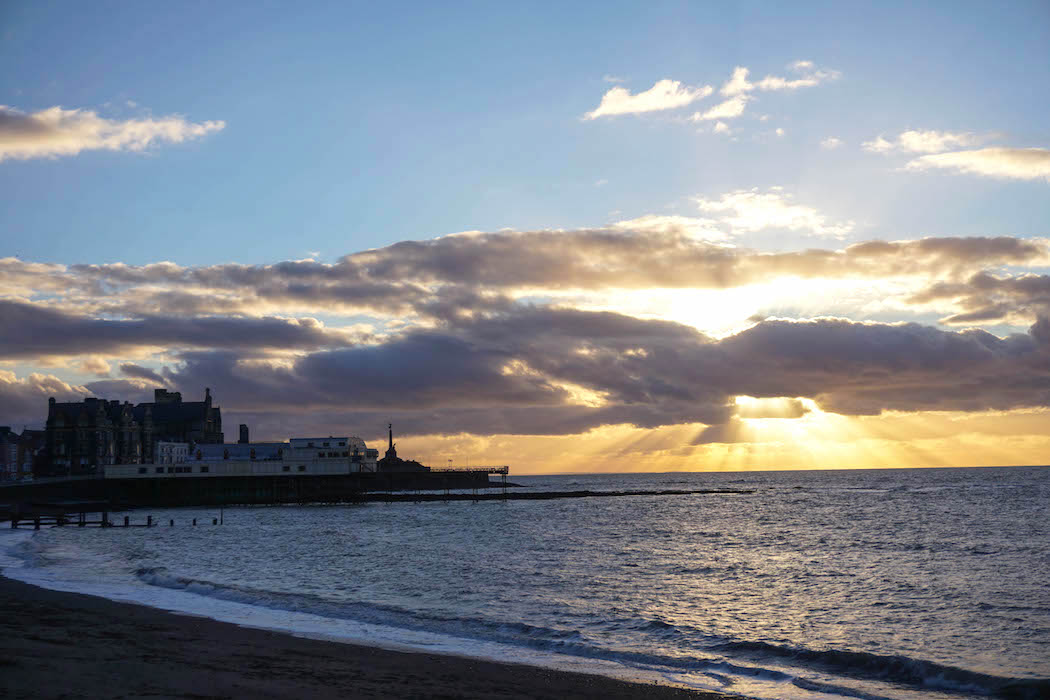 Aberystwyth Bay
Aberystwyth Bay
First stop, Aberystwyth. The other day, while speculating on the bathing elephants*, Dee and Margaret had mentioned this town for being a popular Victorian era destination. We walk on the promenade and see the beach where the elephants were pictured. For a full posh-Victorian-ladies-on-holiday experience we should go up the hill on the funicular railway to enjoy the view of the bay and the Camera Obscura. But there’s not time for everything today, so we go straight to the Siop Y Pethe: I have a look around - it has an interesting selection of books and Wales/Welsh themed objects and gifts - but the main reason we’re here now is Dee and I are meeting Lara and Nicky. A lively and fun conversation starts right away, and I’d love to participate more, but my brain seem to have forgotten how to speak any language. It just left a note: “If you really need to speak, say this: Where can I drink a good beer in Aber?”. Nicky happens to have an answer: Yr Hen Lew Du. (Gosh, written Welsh still puzzling me. Now I see it, how come it looks like the name of a Chinese restaurant?! But naa, it doesn’t if you say it, and by the way it’s an old black lion and a traditional pub that we’re talking about.)
While walking, I get distracted by a cafe named Agnelli’s. Being from Torino I can’t help but thinking of FIAT founder and dynasty with the same name right away. Then I notice they have a wide selection of Italian food and drinks. Not those with Italian names, like Celentano frozen pasta or Gino Ginelli ice cream, but which really exist only abroad. The kind we really have in Italy. A good sign. We decide to go in for a coffee, and maybe speak a little Italian, for a change? On the blackboard, I see today’s special: Hot Bicerin from Turin. Well, now I have to try it! I also have a little chat with Chiara, the owner, who came here to study at the University, loved the atmosphere (oh, no wonder, I understand) and decided to stay. She opened the cafe, and seems to be doing great! By the way, her version of the bicerin is different than the traditional you’d get in Turin. But just like a cover of a song may be even better than the original, this is very good and definitely wins my Torinese seal of approval.
I find out that Aber was the set of “Y Gwyll”. I’ve seen it, I’ve seen it! As far as I know, it’s the only Welsh TV series ever reaching our country. Not in Welsh language, though: via Netflix in the English version called “Hinterland” first, and later, I read, dubbed in Italian for a TV channel. The entry on Italian Wiki defines Aberystwyth as…er…uhm…“small country village”. To be honest, we don’t know much about Wales, in Italy. But it’s because it rarely gets mentioned all by itself, except for ancient history, the Prince, the fabric with the same name and sports. That’s a shame. I know. Anyway, I remember we all thought the locations in the series looked great. Now I know where they are, I can add them to my list for next trip.
While we leave Aber, Dee tells me the story of Capel Celyn, the village where people were forced to leave everything behind and the valley flooded to create a reservoir for Liverpool. The Cofiwch Dryweryn mural, by the A487 near Llanrhystud, stands as a reminder. We stop, and I take a picture. Crazy as it may sound, someone later that very same night would go and write "Elvis" on it. So my photo ends up showing how the wall looked like, just a few hours before being vandalised (and then promptly restored by a group of cool volunteers the day after).

Further south, we reach Aberaeron. It’s a veeeery pretty town, with gracious houses painted in different colors. Dee had planned a quick visit here and then a drive along the coast, so I’d be able to see the scenic route.
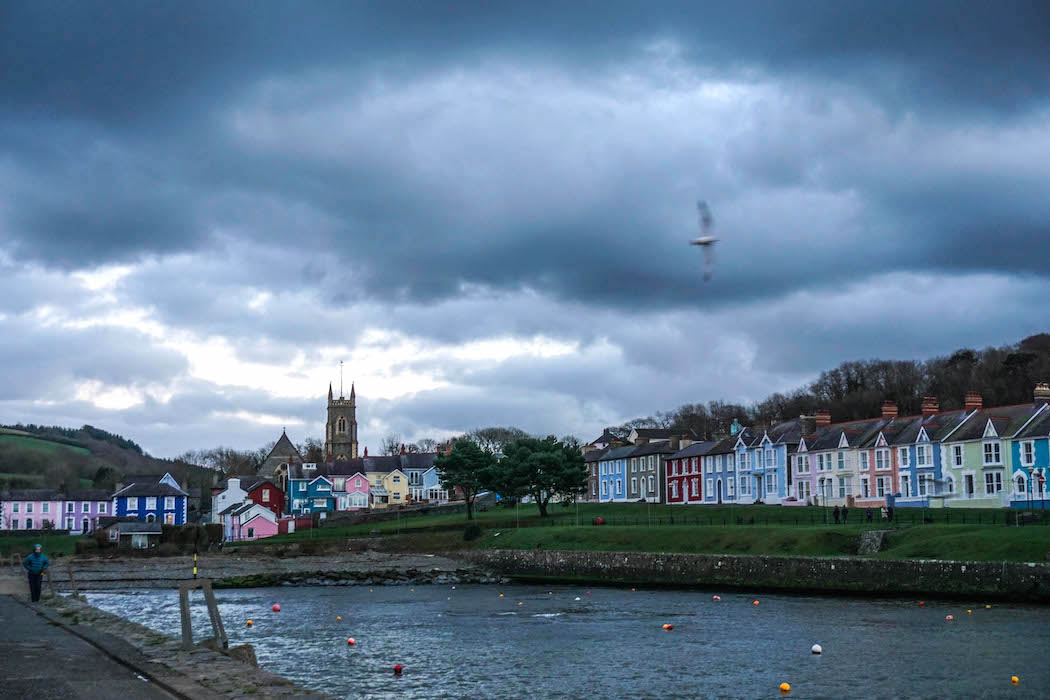 Aberaeron
Aberaeron
However, for lunch I had just cawl moron a sinsir (ok, this name still make me chuckle a bit) and a piece of someone else’s cheese and bread (with their permission, I swear!). It was all good, but now I’m quite hungry. And I haven’t had the chance to drink the beer I was longing for, yet. We walk by the Harbourmaster restaurant. It looks scarily out-of-my-range-fancy, but a sneak peek at the menu outside reveals that it’s very tempting and also surprisigly affordable, especially after noticing that in other restaurants prices are higher than the average anyway - as in nice tourist destinations often happens. Hey, I’m Italian and food is among my top priorities: when I travel, I’d rather sleep on a carpet with a sleeping bag, than give up on good food. We walk in aaand…attention, ladies and gentlemen, drum rolls and trumpets…for the first time ever, walking into a place someone speaks to me in Welsh first! Even just for this, I think they deserve us staying for dinner, don’t they? And definitely a toast. So I’ll start with a (Welsh) beer right away. Yes, I would usually drink wine in these circumstances. But listen, in Northern Europe wine is expensive, I like good beer, and it can be just as fine also with a more refined cuisine like this, so why not? By the time we head back to Llandysul, it’s too dark to see anything on the scenic route, but the food was delicious and well worth the stop. Ceredigion coast, on my list for next time in Wales.
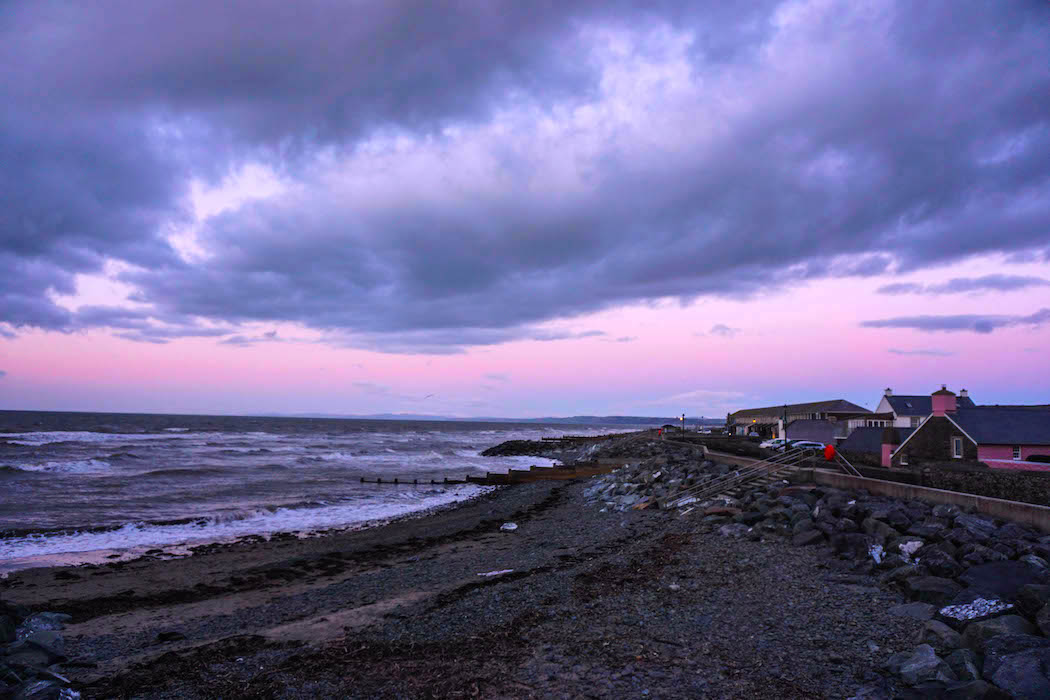 Ceredigion coast
Ceredigion coast
Two days later, I’ll play the tourist again, although with a few obstacles on the way: the National Wool Museum of Felindre is closed on Sunday and Monday in winter, so we can’t see it today. The ex-POW camp opens by appointment only. We didn’t plan the visits in advance, therefore we hadn’t called. But I’m leaving tomorrow morning, and going there I can have at least a glimpse of it. By the way, before coming to Wales I only had a vague idea of POW camps, and certainly didn’t know their locations around Europe. Never heard of the Italian Chapel of Henllan. Never heard of the Italian prisoner who decorated it (using things like tin cans, crates and paint made with berries, carrot pulp and fish bones!) even though he was from a small town just a hundred miles away from Turin. I’ll have to find out more, before I come back next time.
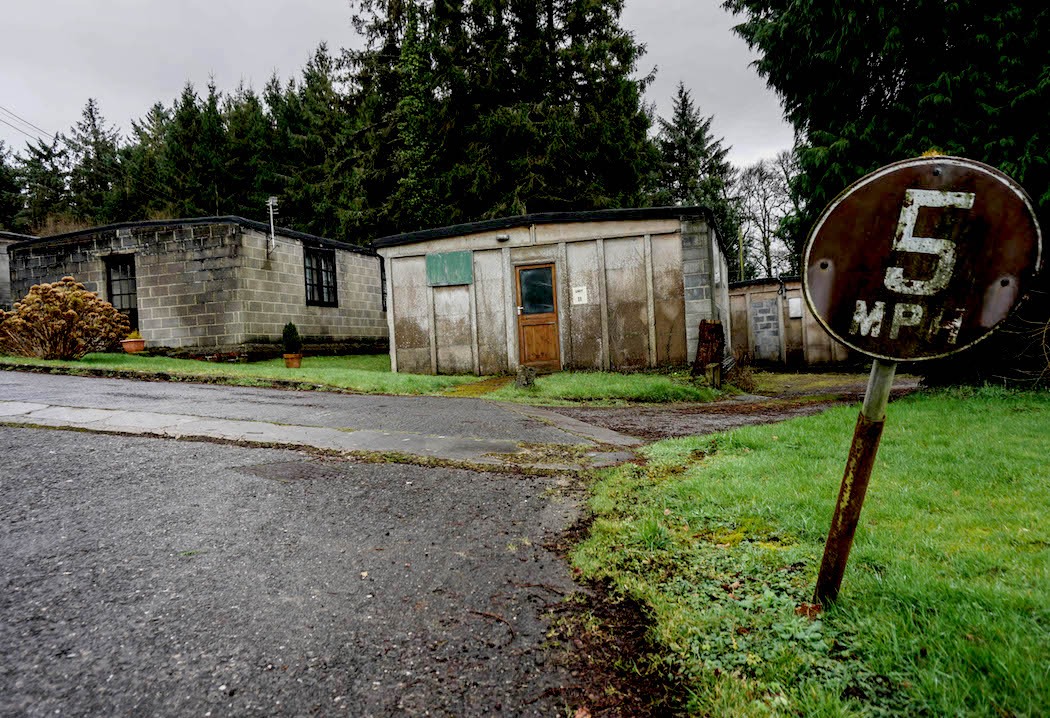 Henllan Prison Of War Camp
Henllan Prison Of War Camp
We then succeed in seeing the remains of the castle of Castellnewydd Emlyn - where apparently the last dragon in Wales - or maybe in the world? - got killed. Especially for a country with a dragon on the flag, doesn’t sound like a happy event. Anyway, Merlin, dragons…quite a lot of action going on in Sir Gâr, back in the days! Now, for us it’s just time to go back to Llandysul. Dee has work to do. It’s a nice and sunny day, and I go for a walk, but I forget to ask her for tips and directions, before leaving. I go all the way from one side of town to the other on the main road, and on the new road as well. Then I don’t really know what to do - so I just keep on going around the small park along the Teifi. It’s relaxing, anyway. I meet quite a few people walking their dogs and I later realise that every time a dog looks at me, I’ve got an automatic reflex to say “Ciao cane!” - no matter where I am. So if you saw a stranger walking in circles in the park in Llandysul and greeting dogs in Italian, it was me. But don’t worry, I’m not dangerous.
Day 4: Developing a Music Project
When I started planning this trip, in summer 2018, I made sure to keep one day free (“And you call this a vacation?” Well...yeah). You never know what might come up later. Turns out it was a very good idea, because I got to spend this day with...Dave and Pat of Datblygu, no less! I would have been very happy to hang out with them even just for the fun of it because they’re great, lovely and with plenty of sense of humour. However, in this case, I also had a mission to accomplish: going back to Italy with the only missing interview for a documentary in the making. It’s a French-Italian project, about a band from Scotland-England, another from Tennessee, one from Wales and a Germany-based label. What’s the connection among them? I will reveal more in due time- if someone’s interested. “Hey, but the interview, in Welsh or English?”. In English. Because all the documentaries I saw about bands who sing in Welsh language were...in Welsh language only, and only about Welsh bands. Nothing wrong with this, of course, and by the way, I’m looking forward to seeing Huw Stephens' music documentary Anorac on S4C Clic. However, to me, this tends to give the impression that Welsh music is like a separate world of its own- which it is not. And also, documentaries and programmes in Welsh rarely reach audiences outside the UK or people who do not speak Welsh even just a little bit already. Correct me if I’m wrong, but at least for Italy, I’m sure this is true. So why not doing something different, for once? It can do no harm, I guess.
What about Welsh language, culture and tradition?
Unfortunately, the vast majority of Italians don’t know the Welsh language even exists. Those who have accidentally heard of it usually believe it’s a dialect, or long dead. And the fact that its name, here, is so similar to Gallia and gallico certainly doesn’t help, because it naturally evokes images of an ancient past. Most people just think of Ireland, France and occasionally Scotland when Celts or any related tradition is mentioned. Just ultra-nationalistic racist parties’ and their followers, (totally unrelated) new agers and Fantasy/RPG/historical reenacments geeks often refer to them. Then folk music enthusiasts usually know at least a few Welsh artists, and rugby fans have certainly heard the national anthem. But it’s normal for anthems folk or choral music to be in old or extinct languages. I mean how can we avoid thinking of Latin, Catholic Church, canti gregoriani or ancient songs in dialects? As for literature and poetry, I suppose students of foreign languages at the University should have some degree of knowledge of it. But I still have to meet someone who knows what an Eisteddfod is. Now that I see it and hear it mentioned all the time from Welsh people, it became somewhat familiar. But until a few months ago, it was just a mysterious name in the lyrics of a song, that I had to google and- to be honest- seemed quite strange, at least for the part with the druids and bards and rituals. When it comes to modern authors, I knew Dylan Thomas because he was often mentioned along with Bob Dylan, John Lennon and the Beatles (who are some of my all time favourites). And the language? Having spent two months in Ireland (that I absolutely loved, by the way) I had heard Irish, but didn’t know it was related and I remember only one word: bruscar. And hey, it doesn’t sound like sbwriel at all!
One sure thing is that Italians tend to assume Welsh is unbelievably complicated. I must admit it doesn’t look very friendly in written form. It’s even worse, if you think the first, or only, thing we’re more likely to see is the 58-character-long name of that village in the North, that’s mentioned almost every single time Wales is mentioned. Maybe it works for tourism, but really not a very good promotion for the language. Finally, don’t forget we know nothing of the alphabet and phonetics so when we try to read it, we conclude it must sound ugly, and that’s about it. Believe it or not, I knew nothing more than the average Italian - until a few songs turned all my beliefs upside down.
Welsh music in disguise
Alright, but wait a minute. Is it possible that a music freak and record collector like me had never heard any Welsh bands before the 2000s? Of course not- it’s just that they all sang in English. And for some reason, people usually refer to minor and major celebrities from Ireland and Scotland as Irish and Scottish, but Welsh ones tend to be defined British or even - sorry again guys! - English. Except in sports.
So if you asked me to name Welsh artists, I would have only been able to say: John Cale - because I’m a Velvet Underground fan- and Tom Jones, because he just happens to always be mentioned as Welsh. I guess we all remember his comeback in the charts with the catchy 'Sex Bomb', but he must also have been very popular here in the 60s. My mom owned only a handful of singles and Tom Jones was among them. So it ended up being one of the first records I ever listened (when I found the little bag of 45s, forgotten in a closet).
I certainly knew more, but didn’t think of them as Welsh - until I had a look at a few lists around the web. Like Freur, especially for their look and hair, but I admit I also really liked “Doot Doot”. The Alarm, although I can vividly remember only their hair. Shakin’ Stevens- can anyone forget “You drive me cray-ay-zee” after hearing it even just once?. Then regulars on MTV and such like Manic Street Preachers, Catatonia, Stereophonics, Underworld and Super Furry Animals. Although picky and disdainful as I was in the 90s, only Creation label and Super Furries could kinda fit in my taste. In any case, at the time I didn’t know they also played songs in Welsh. So it took a bit longer, and more coincidences, before I actually got to hear any.
Meet Welsh-language music
The full story of how a record by a Welsh-language band ended up in my iPod is too long. So I’ll just skip to the point when, on a long drive across France, shuffle picked a song called Brechdanau Tywod: it was instantly clear that it was the kind of stuff I liked but, surprisingly, not sung in English.
“What language is this!? Oh, this is the band that Ben had mentioned. It must be Welsh, then. But these guys can’t be using an ancient language with this music...so?”
Well, turns out Welsh is a living language. And very cool sounding too. Blimey.
After a while, shuffle decided it was time for another, and more popular, song by this band: “Casserole Effeillaid”.
It seems that quite a few people in the UK heard this on John Peel on BBC Radio 1 or The Tube but we didn’t have those in Italy. Anyway. Lighter atmosphere, not dark and gloomy as the first. Also the language seemed different. It still sounded a bit weird at times - pretty much like I expected from the look of written Welsh - but I never in the world would have guessed I’d hear echoes of Italian language in it. Not jokin’! At first, this universal truth might be overshadowed by the presence of “ch”, “ll”, “dd”, “rh”, “th” and some pronunciations of the “y” - that we don’t have. But everything else sounds just like in our alphabet. Hearing this guy yelling casserole, casserole was quite hilarious by itself. But imagining possible meanings and making up sentences with the fake Italian words - like sainpassio, asgùrsio, oguèli, riòlai, esgrivenni (just to name a few not too nasty or naughty) - provided hours of extra entertainment. And the best was yet to come.
Songs had different styles, but a few were sung in a quite similar way. I don’t really know how to explain it, kinda like short sentences, very clear and distinct? It reminded me of The Fall a bit (whose lyrics, when I was a kid were just slightly more intelligible than Datblygu’s, by the way). But the Welsh words made the singer really sound like a wizard casting spells, or something: Gwahanol! Trafodaeth! Gorllewin! Gyfan gwbl ond beth meddylion nhw, pan o’n i’n hollol hollol! Awesome. Also, the little pause between verses was just perfect to try and repeat what I heard. We did something like that, in English lessons. But instead of boring things like “The red pen is on the desk” and “Good afternoon, Mrs. Freeman” now I could say…well, to tell the truth, I hadn’t the slightest idea of what I was saying. But I didn’t really care, cause it was so much fun! I was hooked for days. I would suddenly go….hollol!...any time. Hey, it’s not easy to figure out how to pronounce it right - you should know! My boyfriend probably considered leaving me in a remote corner of Brittany, not to hear any more hollols. In which case, maybe I would have ended up learning Bréton instead. But I made it back to Torino, and...what next?
But the Welsh words made the singer really sound like a wizard casting spells, or something: Gwahanol! Trafodaeth! Gorllewin! Gyfan gwbl ond beth meddylion nhw, pan o’n i’n hollol hollol!
Day 5: Voices of Welsh Language
Having no real need to speak Welsh, in the next few years I learned just tiny bits and pieces. But I kept on listening to the songs I liked, and as a consequence, no less than 90% of the Welsh language I heard came from one source only. That’s why my Voice of Welsh Language Award can only go to...David R. Edwards. The remaining 10% is split between Pat Morgan, anyone who did backing vocals on Datblygu records and a bunch of people in random videos on YouTube. Until I came across Say Something in Welsh.
When I started, last year, you had to choose North or South version right away. I didn’t have a clue of what it meant. The only sure thing was that I liked the Aberteifi version of the language. Aberteifi is in the South. Then South version was the way to go. And that’s how Iestyn and Cat became Mr. and Mrs. Number Two Voice(s) of Welsh. Both, because in the course they say the same phrases - apart from a few sentences he occasionally adds in the introduction to the Challenges - but I’m sure he doesn’t mind sharing the title.
SSiW South - Live in person
Cat and Iestyn happen to live in Llandysul, too and on Monday morning Dee has organized a meeting with him at Buon Appetito (!) cafe. There’s photos of Valentino Rossi and Ducati bikes all over the place so, sipping a good cappuccino, it’s almost like being already back to Italy. Almost. Because rumors are that Mister Voice Number Two has no mercy and only Welsh is allowed in his presence. Like the recorded version of himself, and Aran, he expects learners to just speak as much as possible and make a lot of mistakes - ‘cause that’s the fastest way to learn. What I didn’t know is that when we meet, he automatically switches to speaking-to-learner mode: extra slow speed and articulating syllables very clearly. Oooh, he’s the first person to do this for me! It seems a good moment to use mae gyda fe galon mor garedig…isn’t it? We’re all aware people don’t speak like this, in real life. But it definitely helps in the following conversation, that’s mostly around the experience of learning languages. Oh well, not surprised - with two SSiW staff members, how could we not talk about it? But with a lot of laughs too - because they’re mandatory in SSiW philosophy and teachings.
Day 6, Epilogue: A final exam (sort of)
Next day, Tuesday, early in the morning, I have to say goodbye to Dee and walk to the bus stop. Same route as the first day, backwards: Bwcabus to Pencader, then Carmarthen, London and Stansted. I have time for one more coffi, before leaving Wales, as long as it’s not too far from the bus station. Luckily Dee knew a place called Pantri Blakeman, that’s right in front. She had been there with a group of students from Quebec, and the staff was very nice. Great to know, ‘cause this is my last chance to speak Welsh in the wild for this trip and I have to do my best. I have a look at the menu. There’s a lot of traditional dishes. Now I can’t help but thinking that I have to leave soon...dammit...I guess some comfort food is what I need. Like that pwdin reis I see in the refrigerator. The very friendly lady who comes to take the order is happy to siarad Cymraeg. It’s a very quiet hour, she’s not too busy and we can chat a bit. She speaks clearly and even helps me find the words I can’t remember - definitely recommended for learners who want to practice! She still remembers the group of Canadians who sang Calon Lân, and is curious to hear why an Italian decided to study this language. A girl from Ireland who works there is a Welsh learner, and seems even more curious to hear how I’m learning it. From what they say, I’m doing quite well for someone who’s never been in a Welsh language course classroom and only spent just a few days in Wales in all her life. I guess I can consider myself proficient enough for restaurants and pubs chatting.
Cymhwyster Tŷ Bwyta, passed. But now I see the bus from the window, and I shouldn’t miss it, I’m afraid.
The English teacher
The time it took me to get back to Torino would have been enough to reach Australia. Next time I’m definitely willing to spend a bit more and fly to Cardiff. A few flights landed at the same time and there’s a pretty long queue also for EU citizens (not that it can make a difference, but I have to say it: Italians are the only true masters of chaos. Please, stop imitating us, straighten things up and...stay!)
The lady next to me and I start talking, while we wait. She’s an English English teacher. I mean, she’s from England and teaches English, in Italy.
“How good are Italians at English?” - I ask.
“Oh they know grammar really well, but they can’t speak.”
Nothing changed, since I finished school, then. And from what the ex-students I met in Wales said, learning Welsh as a second language at school is not different. Something doesn’t work too well in the way languages are taught in school?
In my case, it’s only because I loved songs in English a lot that I didn’t end up hating the language, and went on learning it the way I enjoyed: from records, books, films, magazines, fanzines, Internet...and most of all, people. Luckily now with Welsh I can avoid the boring and annoying parts, and just keep the good ones.
Now I think about it, and finished writing this, I’d better start organising next trip to Wales right away. Hwyl am y tro!
Tŵt is available online or mobile at toot.wales
You once launched a Web services company called MerlinWeb. Are you obsessed with Wales, or was that just a coincidence?
In everything I do, I try to sell Wales a little bit. I believe we have a unique culture and spirit from which comes a great sense of personal pride and belonging, and I love sharing that with anyone and everyone. My very first business was a shop called Merlin’s Cave, there’s definitely a theme there.
Why do you think Welsh people need their own Twitter?
I don’t. I believe every community needs their own Twitter. We built the Web to liberate content, not hide it behind proprietary paywalls and data-mining conglomerates. Tŵt is a decentralised, privacy-first microblog that ensures each individual user owns their content, can delete it, take it somewhere else, and have complete control over who can see and interact with their “Tŵtiau” (“Toots”). Then add in the stated aim of encouraging bilingual conversation on the Web. If I was a dog lover I’d have built Woofer instead of Tŵt, but here we are.
Does this mean you don’t like dogs?
I love dogs, but I find them hard to communicate with online. I think it’s their lack of thumbs- they can’t type or text well.
How is Tŵt different from just following a bunch of Welsh people on normal Twitter?
Well first off, it’s not a competition. Anyone can participate in both fora. However, Tŵt offers a Welsh language interface which Twitter does not, and a native Welsh language capability for posting and reading; and Tŵt is intended to be a more intimate online setting, recalling community Web forums of the nineties. Couple that with a clear guide to acceptable content and activity, Tŵt is in many ways a response to the fake news/online abuse/noise fest that the larger sites simply can’t moderate or really get a handle on. Twitter is a communications medium; Tŵt is a community.
How does an online community of like-minded folks compare with In Real Life? Are they complementary, and if so, how?
Tŵt first came to me in a Welsh restaurant in New York – the much-loved-although-sadly-closed Cantre’r Gwaelod – where a bunch of us Cymry were gathered. I was chatting with a mate and another acquaintance of his joined in to say hi and they switched to Welsh for their portion of the conversation. Growing up in 70s and 80s Wales, there was a lot of suspicion and even venom against the language from many corners, but here in New York thirty years on we were effortlessly switching one to the other and it was warm, welcome, and heartening. There’s a lot of politics around the language, with arguments over things like which version of a village name goes first on the road signs, how much money should be spent on Welsh language initiatives etc. So I wanted to recreate that NYC experience online, but without the politics. Tŵt is not a pro-Welsh political endeavor. It’s simply a medium that says “you can use this thing in the language of your choice, you can post in the language of your choice, and you’ll be replied to in the language of that replier’s choice. Figure it out.” Most specifically, I want an online experience where Tooting something in one language and being replied to in another is normal and acceptable.
The political arguments are similar to arguments in Spain and France around Basque and other “majority-minority” languages, where road signs are bilingual, etc.. Language is obviously vital to the health of a culture, particularly when that culture is subsumed by another, larger one. Do you know of other efforts similar to yours for Welsh?
I was just yesterday invited to a meeting “Promoting Multilingual Societies: Perspectives from Wales, The Basque Country, Flanders and Quebec” so I’ll ask them when I see them. I recently happened upon the SaySomethingInWelsh forums which are a treasure trove of similar activity, and Parallel.cymru is a fascinating bilingual magazine where content is in both languages side by side on the page. Right as we started translating the service I bumped into Carl Morris and Rhos Prys of Hacio’r Iaith who are heavily engaged in Welsh-language technology, and they offered some great advice based on their experience in this area.
Twitter itself was once a hobby for three guys, two of whom had strange names. Then came market forces and the laws of large numbers and it became the cacophony of phoniness that we know and despise today. How do you keep that from happening? Conversely, how the heck do you manage this all by yourself? And is it healthy for a community forum to be managed by just one person?
I am in the process of incorporating a charity to take ownership of Tŵt such that it can never be sold or profited from. Tŵt will never accept advertising fees. My goal is to reach somewhere between 50,000 and 100,000 members; I don’t think the model can go much farther than that. However, Tŵt is built on an open source platform called Mastodon, which allows anyone to set up their own “instance” – their own personal Tŵt. I hope that as we get bigger others might form their own friendly, neighbouring instances to focus on particular subjects or communities, maybe photography, maybe religion, maybe music… As for how I manage it by myself, I don’t sleep much. And it really shouldn’t be just me for too long, I’ll push the boat out but others are going to have to row. I believe there’s a gap in the market, I believe Tŵt brings innovation and value, and if others feel the same, they will eventually outweigh me.
Are you promoting Tŵt in any way? Just word of mouth or… Twitter?
I’ve posted a few bits and pieces on other social network sites, mainly in the form of “if you’re not having fun here, why not try Tŵt?”, and a few ads here and there. But for the most part I’m hoping to get the word out through our early adopters and content providers – we’re at around 150 people right now in our first month – and if we can demonstrate fun and value to them I think they will bring their friends and followers.
To save folks the trouble of reading your Ts and Cs, are there policies banning people from swearing etc.?
Tŵt is a community proposition, and while I have the helm for a short while I intend to let the community decide these things. Tŵt has built-in privacy to restrict your audience and content warning capabilities to hide content behind a spoiler alert; however we will always draw the line at racism, sexism, discrimination against gender and sexual minorities, xenophobia and/or violent nationalism. We may ask that that be hidden behind a content warning, or we may point to more appropriate venues for such content.
It seems pretty clear that sex and money motivate people most of the time. What will draw people to Tŵt?
I think you make a sweeping statement which is easily refuted by the millions of people posting pictures of their cats. I really believe the Web to be a powerful vehicle for freedom and equality in the world, and having worked on many moderated communities since the mid-nineties I do think there’s a space for Tŵt to exist and a group of people who will derive some measure of value from it. How big that group is remains to be seen. For me, it’s simply a safer – and saner – space than most to connect with my fellow Welsh back home and around the world. I hope that it can be that to others, too.
You’re a Welsh expatriate living in New York. If you were to return to Wales, would you continue managing this site for as long as you otherwise intend?
I will keep on shepherding Tŵt until it’s dead or bigger than I can manage, wherever I may be. Right now I’m planning to go for two years and see where we are then.
Is this primarily a community for other Welsh expats, or do you think folks in Wales will also participate? (Or do they already?)
It’s aimed more at home than away, although I envision it being a great way for the diaspora to connect. Our early members are about three quarters Wales-based, and a quarter Welsh diaspora and Welsh learners. I’ve recently bought some hand-painted decorations from a young Welsh artist in South Africa through Tŵt, and I met a German chap who is a rugby fan and is learning Welsh, and we swap notes on the Six Nations matches. As a technologist I live by three rules of software development, and the second one is “The Users Will Subvert the System” – so I fully expect and welcome the platform taking on a life of its own as it adapts to its user base.
Then I guess I hope they do, as that will be a great measure of its success!
Diolch i ti Mike!
toot.wales / twtcymru.wordpress.com
]]>A small company in the Netherlands has released an iOS and Google Play word puzzle game, Word Tango. In its first iteration, Word Tango can be played in English, Welsh, Cornish, Danish, Faroese, Icelandic, Dutch and Frysian, with more languages to follow. Parallel.cymru asked the game's designer, Remco Denessen, to talk us through how he went about making the game and why they are supporting lesser-used languages.
I speak Limburgisch (https://en.wikipedia.org/
Fewer and fewer people are speaking Limburgish, and that really is a shame. Our dialect is much older than our national Dutch language, but the people from Holland (the western part of the Netherlands) can hardly understand it and sometimes they ridicule it. Maybe Welsh speakers have had similar problems with people from England?
For smaller languages to survive, it is important for them to have enough media available, such as radio programs, magazines and also word games. A word game can also be used to practice the language, which is especially helpful when you are learning it.
That’s why we- my brother and I- decided that we want Word Tango to be available in more than 100 languages, even when there are only a few speakers. Most word games can only be played in English and in a few other world languages, but we want to make a statement: We DO care about all these smaller languages!
We hope that when Word Tango gets successful, other developers may also release their games in more languages.
We are planning to add around 25 Dutch dialects (Limburgisch and others) in February, which will be the first time the Dutch people can play a word game in their dialect. We also hope to add Manx soon and a lot of other European languages and dialects
How did I compile the word list while not being a Welsh speaker? I collected the Welsh words myself on the internet, from different websites. After that I checked the words in two Welsh spell checkers to make sure that they were written correctly, and we had the texts in our game translated by a professional Welsh-English translator.
I know there are some letters in Welsh which are two letters combined, like “ng” but it was not possible to fit two letters on one tile, and it did not look right. So we hope the Welsh people will not be angry with us about our decision not to do this. I guess they also use a standard English keyboard, and may be used to it.
In a few weeks, we will update our app. You will be able to go back to a finished level to look at the words again. And in Kernewek (Cornish) and Welsh you can also see the English translation of the words; for Frysian you will see the Dutch translation. So this might me useful when you are learning the language. We do this only for the smaller, local, languages.
In summary, we are just brothers who are using our spare time to support languages- languages and word puzzle games are our passion. It was a lot of fun to collect all these Welsh words, and to try to guess the meaning. But it was sometimes hard- for example Kernewek is closer to Dutch or Limburgisch.
smilingcube
Google Play link:
play.google.com/store/apps/details?id=com.smilingcube.wordtango
![]()
Apple Apple Store link:

Special news; our correspondent, Peter Mescall, has been in contact with Jeremy Vine after the recent language debate on Twitter. Mr Vine presents a program on Radio 5 and was reviewing the year; a caller criticised the Welsh language, with an example about people who change to Welsh instead of continuing in English when English speakers enter a pub.
Jeremy Vine received a message on Twitter; the user was not happy with the program and the discussion then deteriorated. Mr Vine tried to resolve the situation, but the image used on Twitter didn't help- unfortunately, the title and image of the article wasn't suitable and Mr Vine then received a lot of criticism.
That's when our correspondent and many others, for example, Say Something In Welsh's Aran Jones, sent messages to Mr Vine. Aran shared his views on nation.cymru and our correspondent then received a message from Mr Vine. Despite the criticisms, Mr Vine realises that the most of the community is happy with his support and recognise that he is a person who appreciates languages and culture. After discussing the situation, our correspondent is happy to say that Mr Vine is honest, and parallel.cymru is proud to have the opportunity to present his experience.
Here's what Mr Vine said (Tuesday 01/01/2019):
Newyddion arbennig; mae ein gohebydd, Peter Mescall, wedi bod mewn cysylltiad efo Jeremy Vine ar ôl y ddadl ar Drydar. Mae Mr Vine yn cyflwyno rhaglen ar Radio 5 ac oedd o’n adolygu’r flwyddyn; oedd galwr yn beirniadu’r Gymraeg, gan ddefnyddio'r hen stori am bobl sy’n newid i’r Gymraeg yn hytrach na defnyddio Saesneg wrth i siaradwyr Saesneg fynd i mewn i dafarn.
Mi wnaeth Jeremy Vine dderbyn neges ar Drydar; doedd y defnyddiwr ddim yn hapus efo’r rhaglen, ac wedyn aeth pethau’n waeth. Roedd Mr Vine yn trio datrys y sefyllfa, ac mi wnaeth o roi dogfen ar Drydar er mwyn helpu’r sefyllfa. Yn anffodus, doedd y delwedd a llun yr erthygl ddim yn addas ac wedyn mi wnaeth Mr Vine dderbyn llawer o feirniadaeth.
Dyna pryd mi wnaeth ein gohebydd a nifer o bobl eraill, er enghraifft Aran Jones sy'n rhedeg y wefan Say Something In Welsh, anfon negeseuon at Mr Vine. Mi wnaeth Aran rannu ei farn ar nation.cymru. Wedyn wnaeth ein gohebydd dderbyn neges oddi wrth Mr Vine. Er gwaetha’r beirniadaethau, mae Mr Vine yn sylweddoli bod y rhan fwyaf y gymuned yn hapus efo ei gefnogaeth a sylweddoli ei fod o'n ddyn sy’n gwerthfawrogi ieithoedd a diwylliant. Ar ôl trafod y sefyllfa, mae ein gohebydd yn hapus i ddweud mai dyn onest ydy Mr Vine, ac mae parallel.cymru yn falch o dderbyn y cyfle i gyflwyno ei brofiad.
Dyma beth dywedodd Mr Vine (ddydd Mawrth 01/01/2019):
It was one of those things. A caller from months ago was repeated in our review of the year on Radio 2 — a Welsh guy from Pontypridd, as I recall, who was very rude about Welsh language speakers who, he believed, “switched to Welsh when I walked in the pub and spoke English.”
The repeat of the phone call went out in the break between Xmas and New Year.
The caller created quite a bit of online anger, including from someone who tweeted me directly to say that his complaint about Welsh being spoken in pubs in Wales was like a Brit complaining about French being spoken in a bar in Paris.
Here I made my classic (holiday) mistake! Thinking we could have some fun debating this point, I asked “Is France in the UK?” ... simply as a way of pointing out that the analogy wasn't a very good one.
This tweet (if you're still following me) suddenly popped up in the feed of Leanne Wood, who I must say I have a lot of time for. Shorn of all context it must have looked pretty crass. I woke up the next morning, saw the scores of angry responses, realised I was in the middle of a classic pile-on, and deleted my France tweet to spare anyone else the agony.
There it might have ended, but for the fact that a very well-meaning Welsh speaker, @owswills, sent me an excellent article debunking the “Welsh in pub” story as an urban myth. Keen to show I was open to the idea that our original caller's story was rubbish, I tweeted Owen’s article. Sadly it came with a photo of the League of Gentleman and an unhelpful headline:
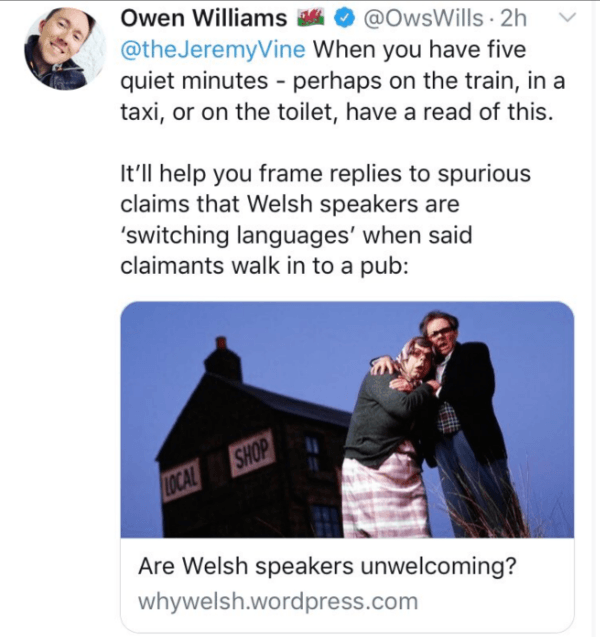
At this point the incident reached Defcon 4 and there was no saving me. The article was pro-Welsh language but I'm not sure anyone really read it. Poor Owen then started taking a hammering too:

By this stage I'd apologised, but it's hard to apologise with complete conviction when the original phone call to my show came from a listener who had every right to ring up and tell his story, however obnoxious some might have found it. Still, several people thought we should have stopped him coming on at all:


And that last comment came from someone whose hobby, I suspect, used to be fighting in pubs before they discovered Twitter.
I followed the uproar carefully, and where I could reply or contextualise I did so. But in the end you can’t stop some people hearing what they want to hear. That’s their right.
The upside is this. Watching these exchanges, which took on a life of their own on day two, with separate individuals hurling insults at each other and me now hardly involved, I made some genuinely friendly acquaintances. The author of this blog, @pedrapiago ... @aranjones whose “high intensity Welsh language training” I would love to try, if there’s ever time: https://www.saysomethingin.com/ ... Welsh AM @neiljmcevoy and MP @jonathanplaid. Plus @owswills who used to be BBC and is a great guy. Oh, and this blog was truly heartwarming https://nation.cymru/opinion/why-we-shouldnt-shout-at-jeremy-vine/. That’s Aran again, and I’m grateful.
So it’s not all bad. I know a lot of this was my fault and I’m not trying to underplay that. But the key thing is to keep talking — in whichever language we prefer. I love the diversity of this tiny island we live on.
Parallel.cymru editors: Thank you Jeremy for engaging with the Welsh-language community, and we appreciate you taking so much time and interest to understand and clarify the issues raised in this Tweetstorm.
Mae Parallel.cymru yn gylchgrawn arlein i roi llais i unrhyw un sydd yn gwneud pethau trwy Iaith y Nefoedd, ac i gyflwyno erthyglau, straeon, diwylliant Cymraeg a llyfrau i’r byd.
Parallel.cymru is an online magazine that gives a voice to anyone who is using the language of heaven, and to introduce articles, stories, Welsh culture and books to the world.
Mae pobl yn profi’r Gymraeg ar gontinwwm o alluoedd gwahanol, ond y ffordd draddodiadol o gynhyrchu deunydd yw mewn dull deuol. Trwy gyflwyno cynnwys unigryw ochr yn ochr, yn ‘paralel’, ac wedi’u graddoli yn ôl hyfedredd (Anffurfiol, Ffurfiol, Llenyddol), gall darllenwyr o bob gallu fwynhau darllen a sicrhau bod y Gymraeg yn hygyrch i bawb.
People experience Welsh on a continuum of abilities, but the traditional way of producing material is as binary Welsh or English. By presenting unique content side by side, in parallel, sequenced by level of proficiency (Informal, Formal, Literary), readers of all abilities can enjoy reading and ensure the language is accessible to all.
When Wales and Ospreys hooker Scott Baldwin got bitten by a Lion cub whilst in South Africa with his club in September 2017, my first thought was- how on earth did that happen? The second, oh dear, I am going to have to scrap some of last weekend’s work.
This now infamous incident, which led to one of my all time favourite Welsh rugby quotes, from then Ospreys manager Steve Tandy – “There was an incident with a lion, but in fairness it was nothing to do with the lion” – provided plenty of mirth across social media, although less so for Baldwin, who had to miss several games due to the injury.
But for me, writing my rugby satire Absolutely Huge (Y Lolfa), in and around my full time job, family life and a lengthy commute, the nip from little Simba meant some of the recent work had to be scrapped. A little frustrating! In my recently finished Chapter 5, Lion Taming, our hero Gethin ‘Huge’ Hughes is selected to be part of the British and Irish Lions tour to South Africa. Among a tour of disasters, the original version, had one of the squad (lightly) mauled by a Lion on a safari, but Baldwin’s brush with Aslan proved far too close to reality. I didn’t want readers to think I had copied a real life incident- so out it went. But don’t worry, there was still a major incident with another animal, whilst visiting Robben Island, rather than on safari. You’ll have to read the book to find out what that’s about. But it hasn’t been copied in real life. Yet.
So, why all this fuss about animals in a rugby book?
Well, it’s not a normal rugby book. Its origins lie in my love of the sport, the biographies of its stars and being one half of half of the Twitter rugby humour account @NotGavHenson since 2011 (with now over 40,000 followers). Through this time, I have seen the ebb and flow of people’s affections towards players and coaches, and it seems no players or coaches are immune to criticism from keyboard warriors.
A similar rollercoaster in the nation’s affections happens to Gethin Hughes, the hero of Absolutely Huge. After a stunning international debut and glory for club and country, by the age of 20 Huge is the biggest star in Welsh rugby. He’s dating pop star Heledd Harte, the ‘nation’s sweetheart’, and after one particularly heroic moment at Twickenham is voted Second Best Welshman Ever.
But the good times don’t last. He causes a diplomatic row on a Lions tour (that’s the pesky penguin…), makes some calamitous product endorsements, suffers World Cup embarrassment and injury heartbreak and is voted the Second Worst Welshman Ever. Things don’t improve after early retirement at 23, when he gets entangled with both reality TV and a political scandal in Cardiff Bay. The book ends with him tentatively beginning a playing come-back but a long way (professionally, if not figuratively) from where he began.
In writing Absolutely Huge, I wanted, through what I hope is a vein of good hearted satire, to reflect a little of what really influences Welsh rugby now – academies, twitter, crazy media coverage, sponsorships, and celebrity girlfriends. All in a slightly exaggerated fictional Wales – where the regions are the Sailors, Capitols, Borderers, Y Gorau and Criccieth RFC, a pop singer who combines the Mabinogion with R&B rules the charts and an eccentric IT billionaire (normally) gets exactly what he wants.
I’ve been fortunate to have had a great response to the book since it was published in September, and it’s been particularly enjoyable to receive notes from players who have read and liked it, more than one has asked me where the stories have come from. Some pure imagination… others well maybe I’ll talk about that another time!
It’s fundamentally a very silly book, but one that people seem to be liking, A bit of a laugh in a time when they are in short supply! I hope you enjoy it!
MrLukeUpton / NotGavHenson
ylolfa.com/products/9781912631018/absolutely-huge
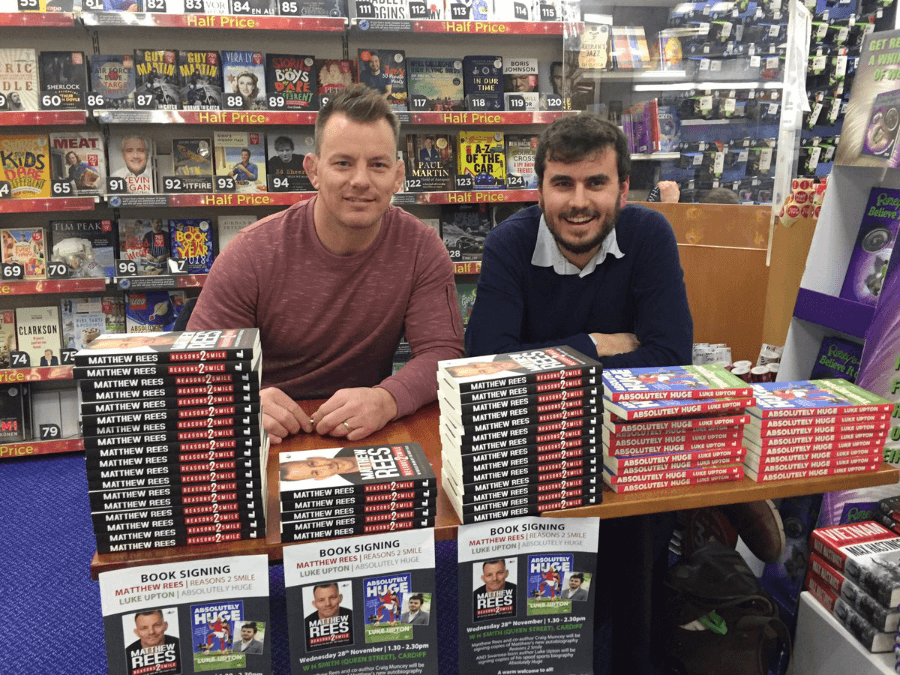 At a book signing with Matthew Rees
At a book signing with Matthew Rees
Gofid (meaning sorrow) plays extreme metal with Welsh song titles under the name Iselder (meaning depression). His work attracted attention this month when he covered Dafydd Iwan’s cultural anthem Yma O Hyd- parallel.cymru went to find out more! First up Gofid, what is your background in metal? I first started listening to metal when I]]>
Warning: Parameter 2 to qtranxf_postsFilter() expected to be a reference, value given in /home/parallel/public_html/wp-includes/class-wp-hook.php on line 324
First up Gofid, what is your background in metal?
I first started listening to metal when I was about eleven years old, slowly getting in to classic bands such as Judas Priest, Iron Maiden and Black Sabbath. In my teenage years I had a good friend who introduced me to the more extreme side of things with Cannibal Corpse and Slayer, which forged the path for me to seek out the most extreme metal I could find. At sixteen I discovered bands such as Dimmu Borgir and Gorgoroth, and it’s all been a passion of mine ever since.
I understand that you’re not fluent in Welsh, but you’re keen to use the language- what is the appeal for you in this?
As a Welshman I feel as though it’s my duty to promote and publicise our nations heritage whenever possible- be it the language, history, or folklore. I believe that doing this will not only encourage people to learn more about Wales as a whole, but possibly help us thrive in the future and help keep the culture alive.
Your current release is a recording of the unofficial Welsh-language national anthem Yma o Hyd by Dafydd Iwan- why cover this?
The idea to record it had been on the drawing board for a few months now, as I felt that there hadn’t really been a Welsh metal band to release a song relating to the history of the country itself. It felt fitting to release it ahead of the new album in light of the renaming of the Severn Bridge into the now “Prince of Wales” Bridge. I’d like to think of it as a form of protest, and I hope Dafydd Iwan catches wind of it and is proud that his message is being heard by a new generation of proud Welsh people.
Your music released as Iselder is you performing vocals, guitar, and bass with drum machine software. Do you have your own studio, or do you record and produce everything at home?
Everything is recorded at home, as Iselder is a deeply personal project of mine. A Welsh promoter once greatly insulted me by telling me that they’re not interested in “bedroom bands”, so I’ve made it almost my mission to prove that I don’t need them. But other than that I don’t think I’d ever ask for help with the recording/production side of things. The only things I use are my instruments and the recording software on my computer. It’s also handy to do everything myself, as this lets me avoid dealing with people (aside from a very tolerant wife who sleeps on the sofa when I decide to record at 3am) as I often like to work alone and prefer to keep my independence as an artist rather than relying on others. This means my music is entirely my creation and my vision and is not muddied by the input of other voices.
These days independent creators have to responsible for the marketing of their work and development of their careers, and not be reliant on a publisher/label/agent/manager/producer to do those tasks. Do you have any tips for other independent creators in Wales?
The biggest tip that I can give is to hone your craft and develop your own sound. Don’t try to be another second wave worship band, unless that’s what you really want to be. The world doesn’t need another Burzum or Darkthrone. What it needs are original bands to make their mark so that the scene can flourish and continue. There’s a few bands I could name that don’t really offer anything new, and instead rely too much on the achievements of others for their success, imitating them to such a degree where I could easily confuse the two and personally that doesn’t appeal to me.
You can often find blogs and such that would be more than happy to review your music, and it’s easier now than ever to sell your music online through Bandcamp and other such sites. Never ask for anything, never make excuses, stand your ground and do what you want to do.
There are a lot of guitar-based rock and indie bands in Wales, but not many metal bands. Are there are any other Welsh metal bands that you listen to?
There are quite a few bands from Wales that I listen to- the most well-known being the death metal band Desecration. But as for smaller bands, I’d say the death metal trio Sepulchre are a must to see live. Other than that you have black metal bands like Ghast (who were featured on Fenriz of Darkthrone fame’s radio podcast), Coedwig Machen, Lleuad, and Merciless Savage. All distinctly different from each other, each bringing their own twist on the genre.
I listen to Emperor, Satyricon and Darkspace a lot; in terms of extreme metal, what bands do you enjoy listening to and who has influenced your style?
I listen to a wide array of bands nowadays, so it’s hard for me to pick out a select few who have influenced my style. I’d definitely say bands such as Satanic Warmaster, Tsjuder, Leviathan, and Nargaroth were big influences when starting Iselder, and they all definitely had a hand in shaping in the music you hear me playing today. The influences definitely come out more on the upcoming album than they did on the last, but aren’t comparable in any way. I don’t want to be Wales’ version of Mayhem, or Gorgoroth, or Burzum. I want to be Gofid, sole member of Iselder, and be at the forefront of Welsh Black Metal.
I’d like to think of the Yma O Hyd cover as a form of protest, and I hope Dafydd Iwan catches wind of it and is proud that his message is being heard by a new generation of proud Welsh people.
iselder.bandcamp.com youtube.com/channel/UCzW715U-PEsKXV885LgGSNw
coedwigmachen.bandcamp.com
lleuad.bandcamp.com
mercilesssavage.bandcamp.com
sepulchreofficial.bandcamp.com
ghastdreaddoomruin.bandcamp.com
desecration.bandcamp.com
]]>






